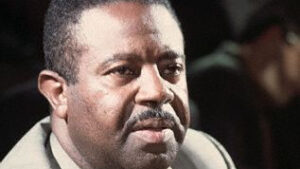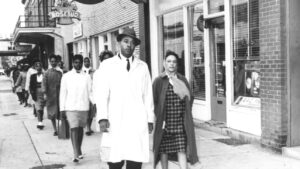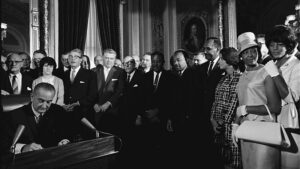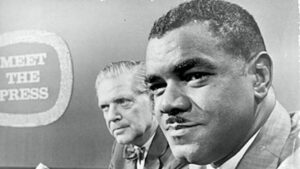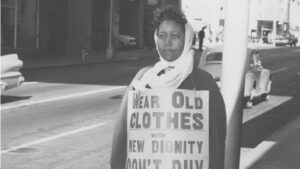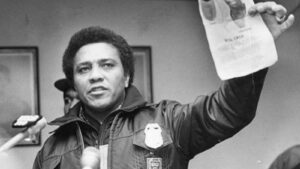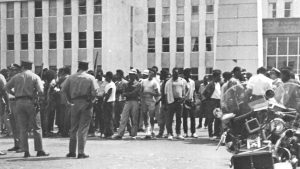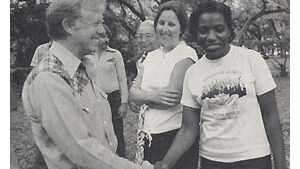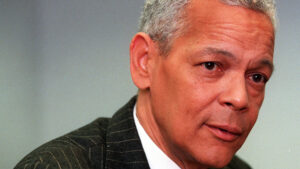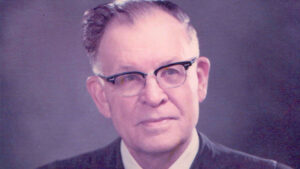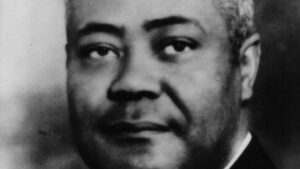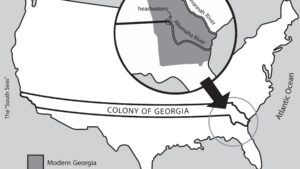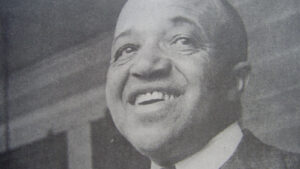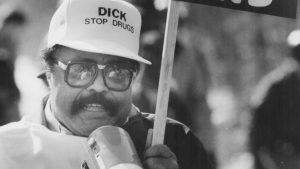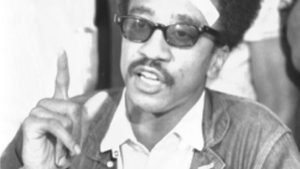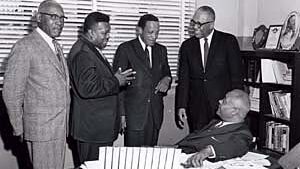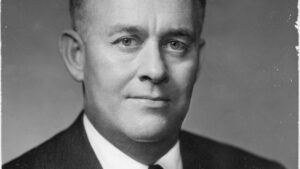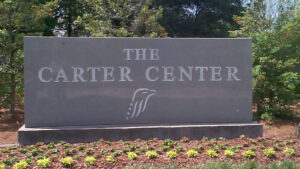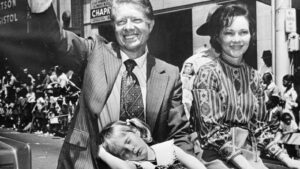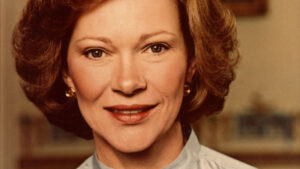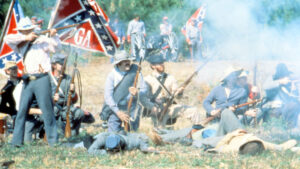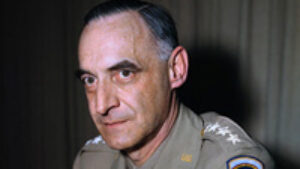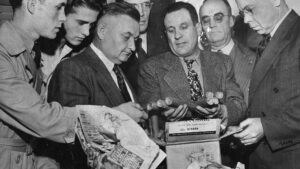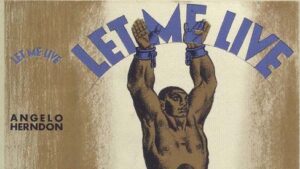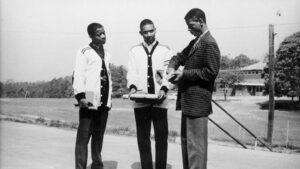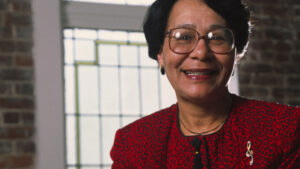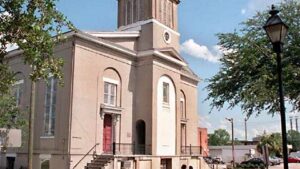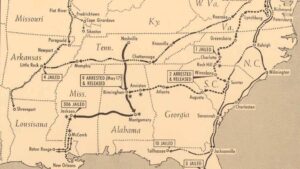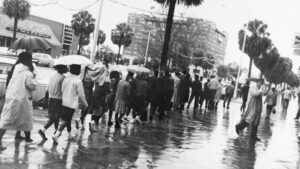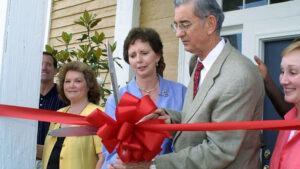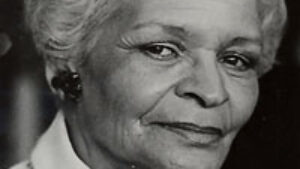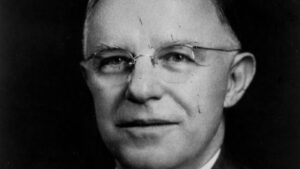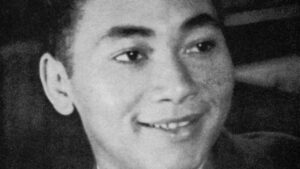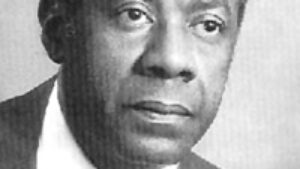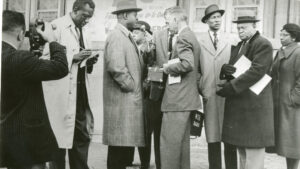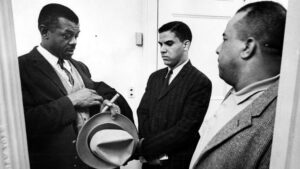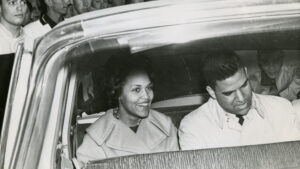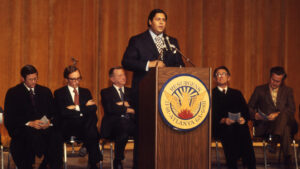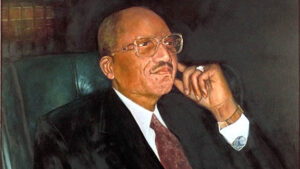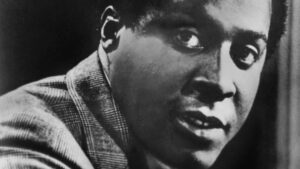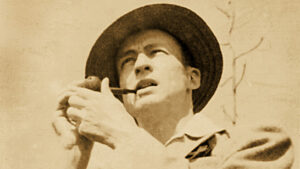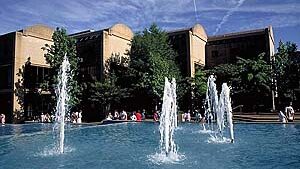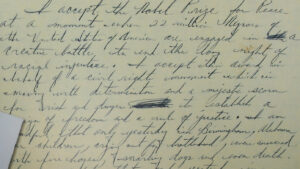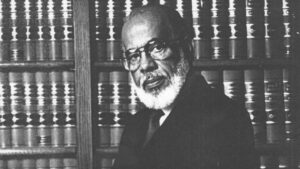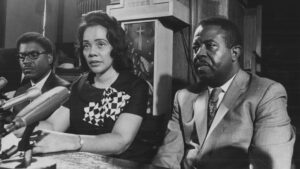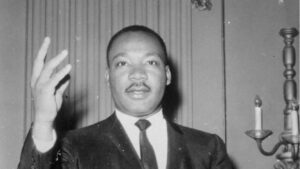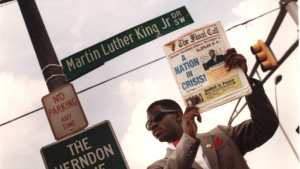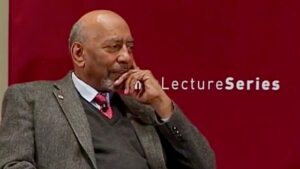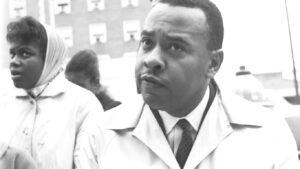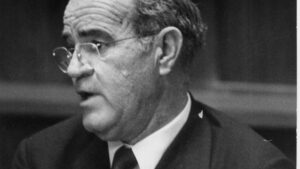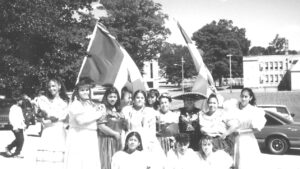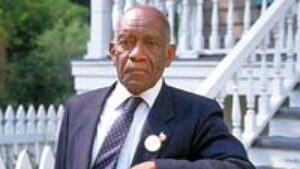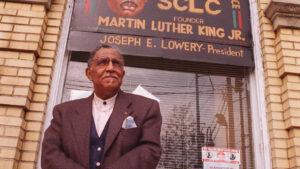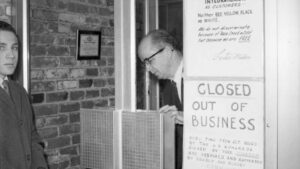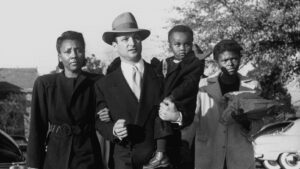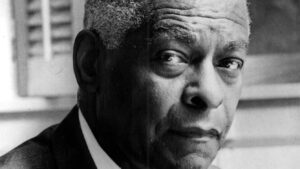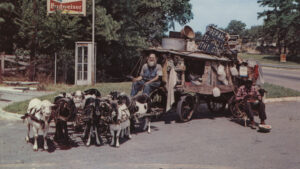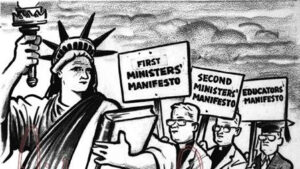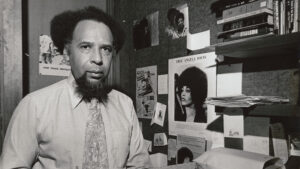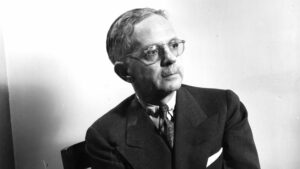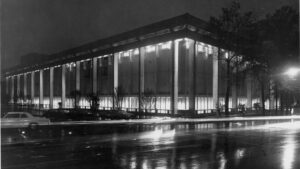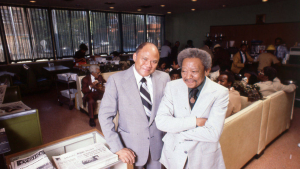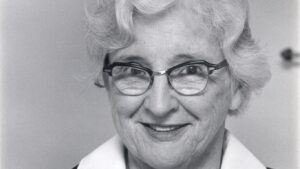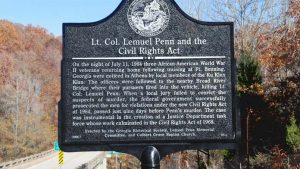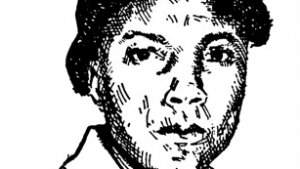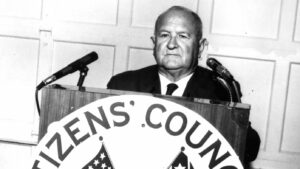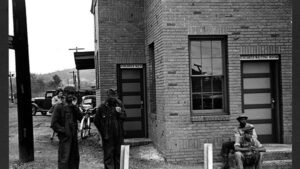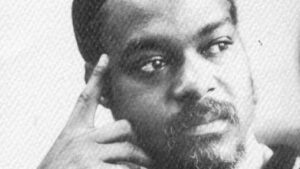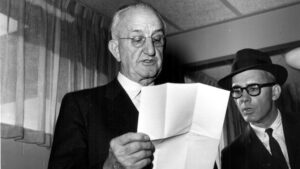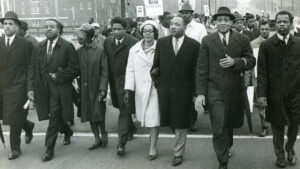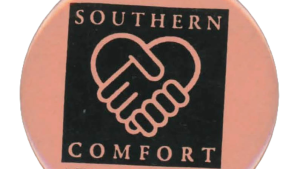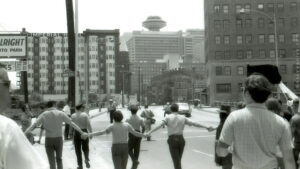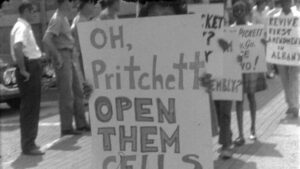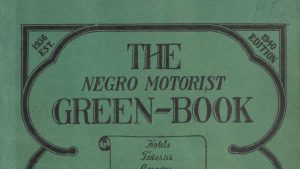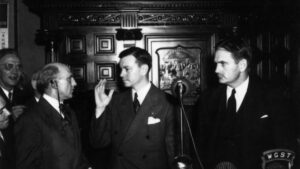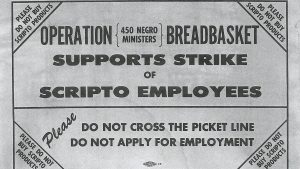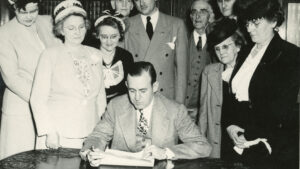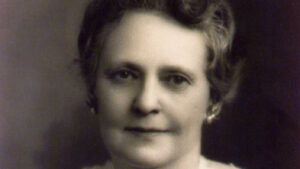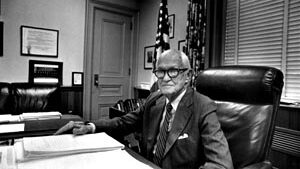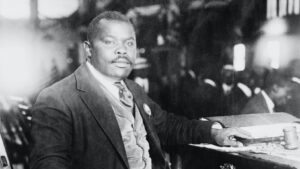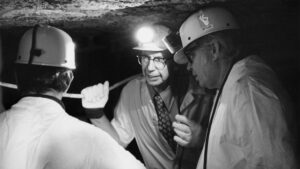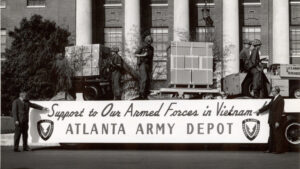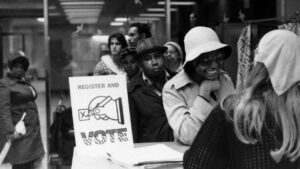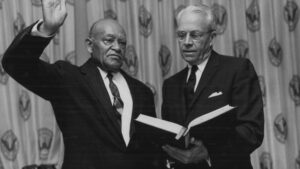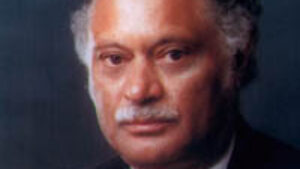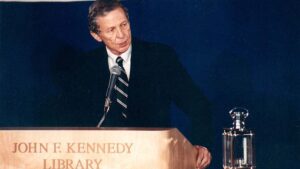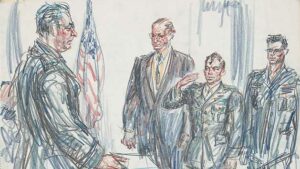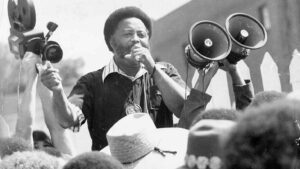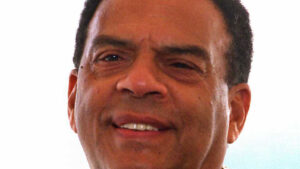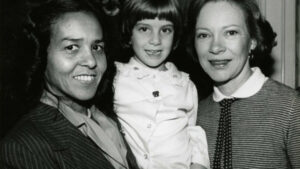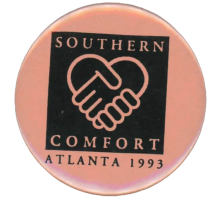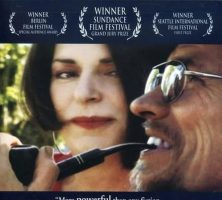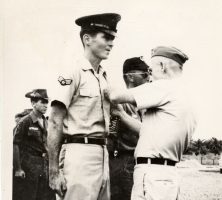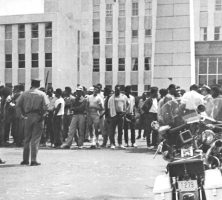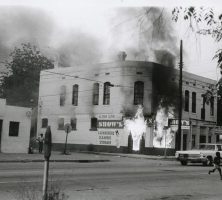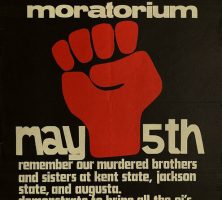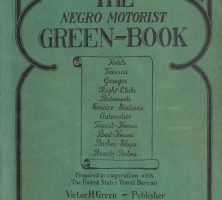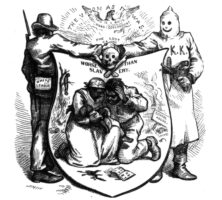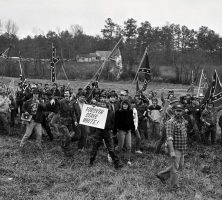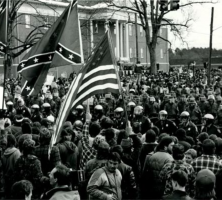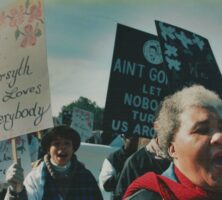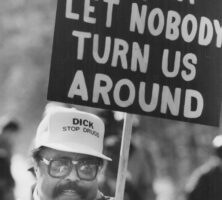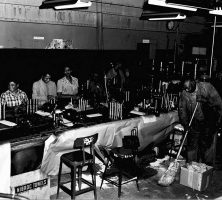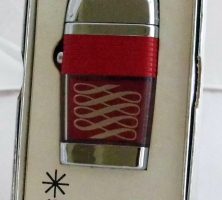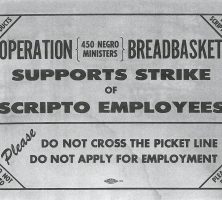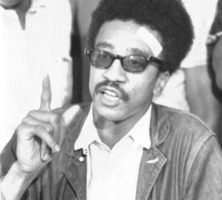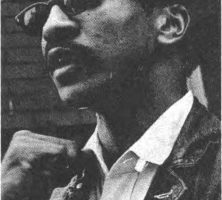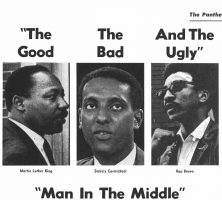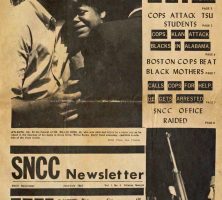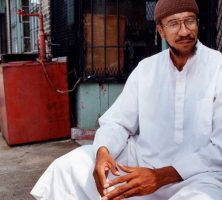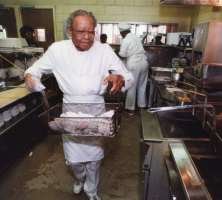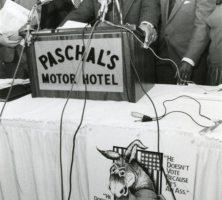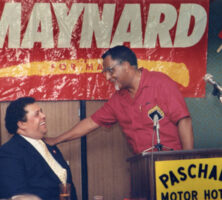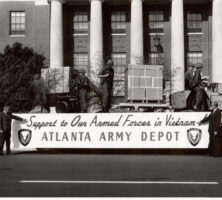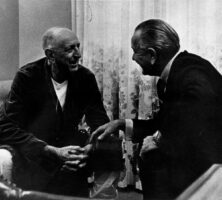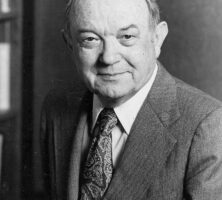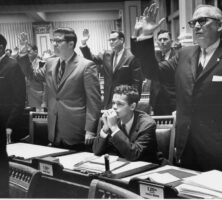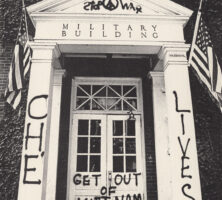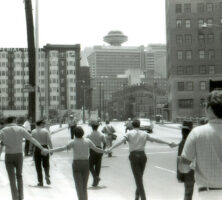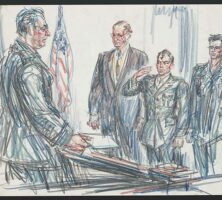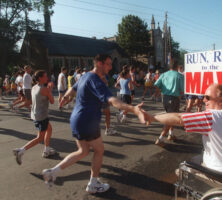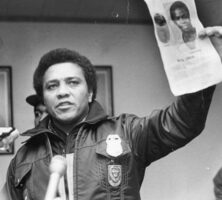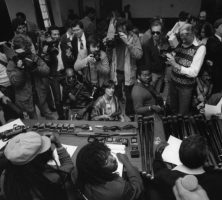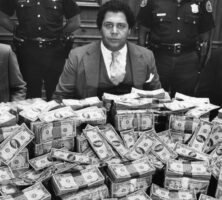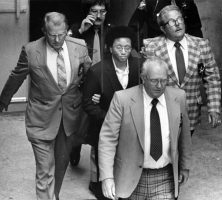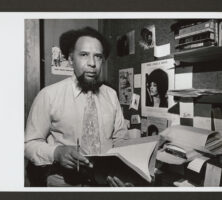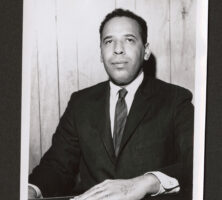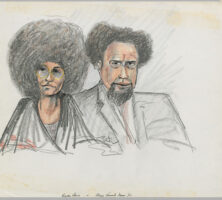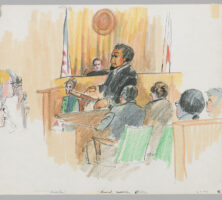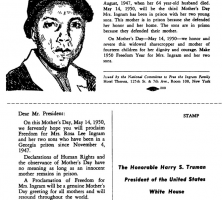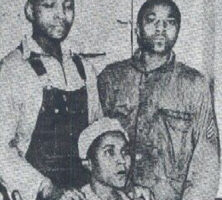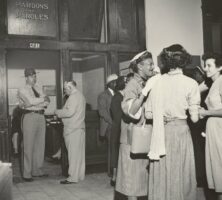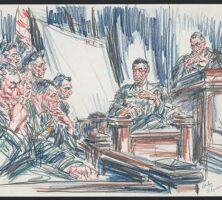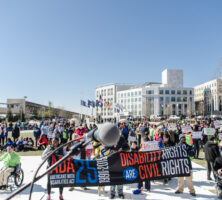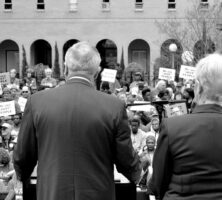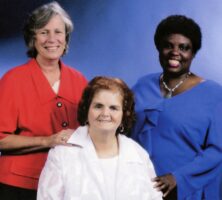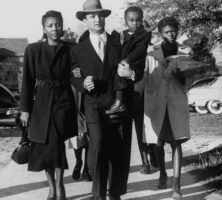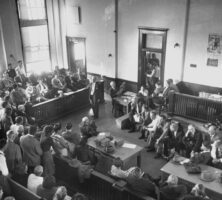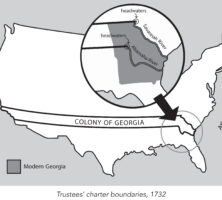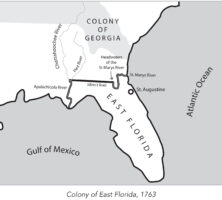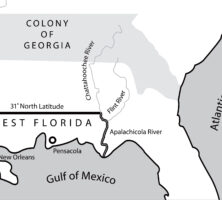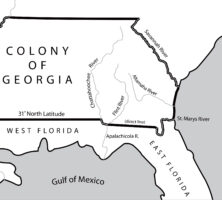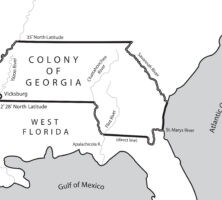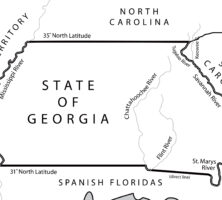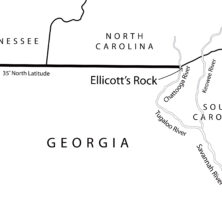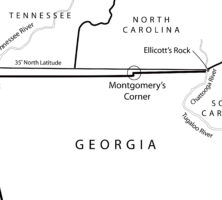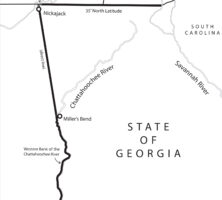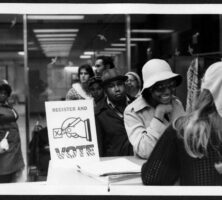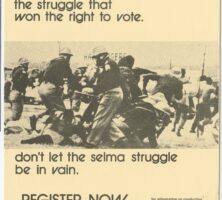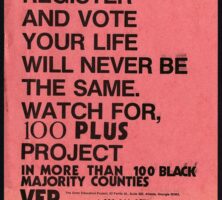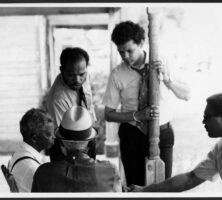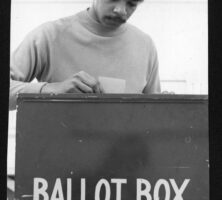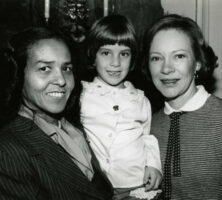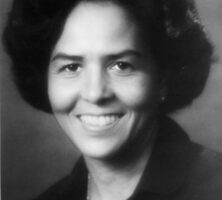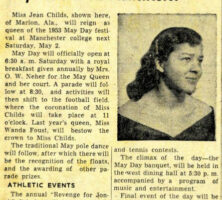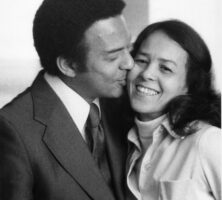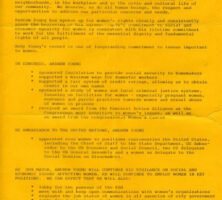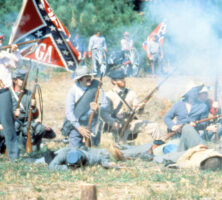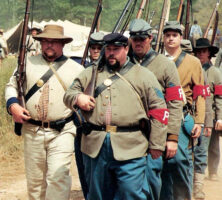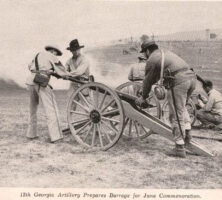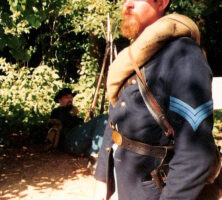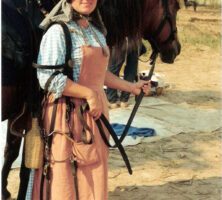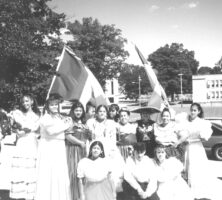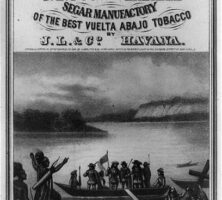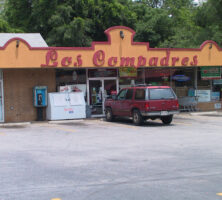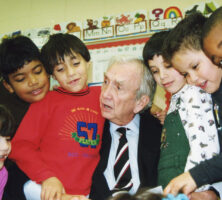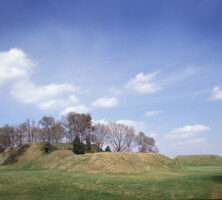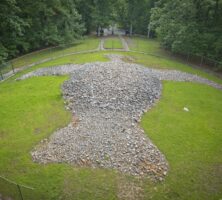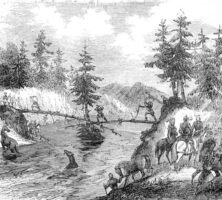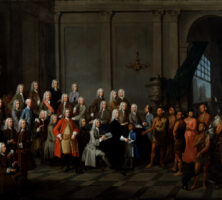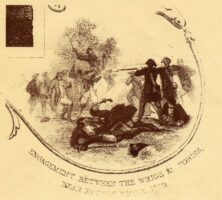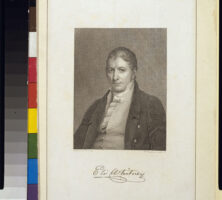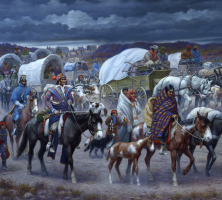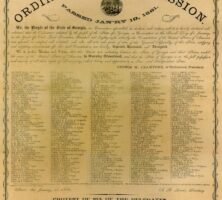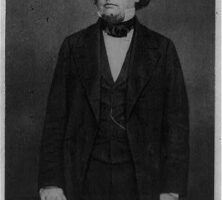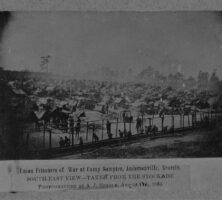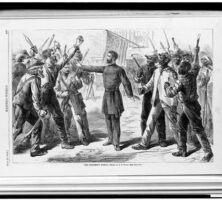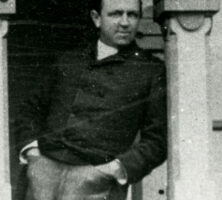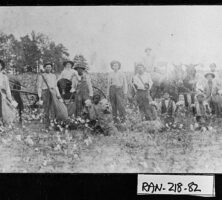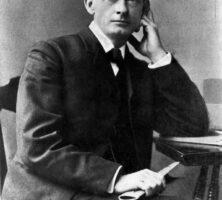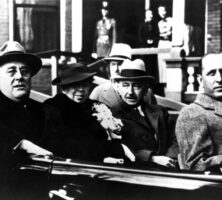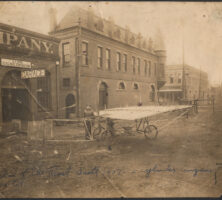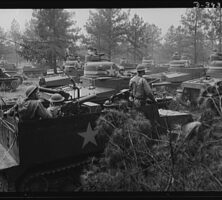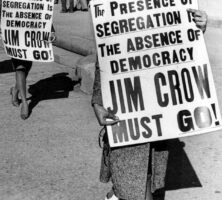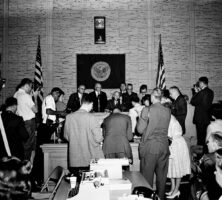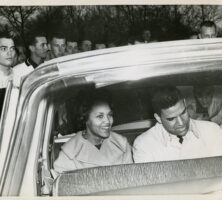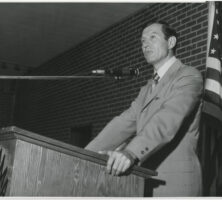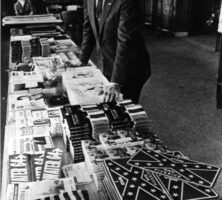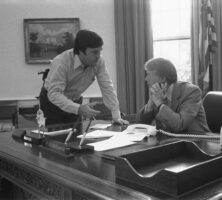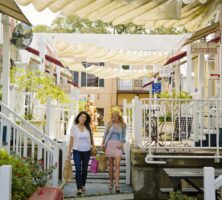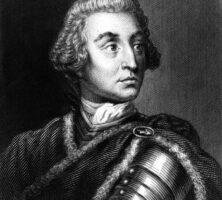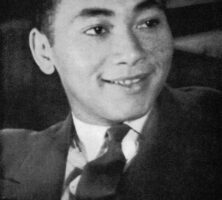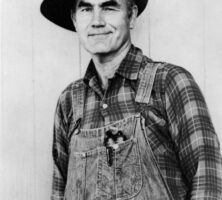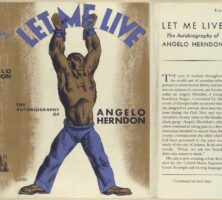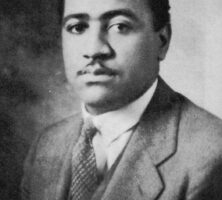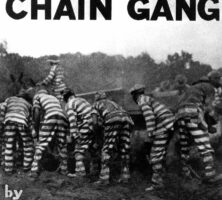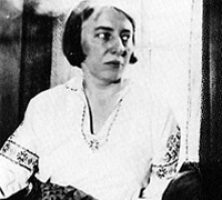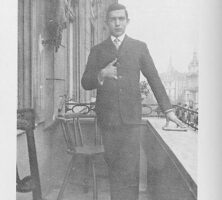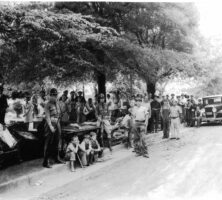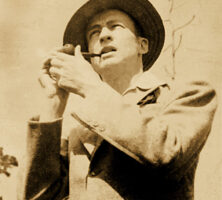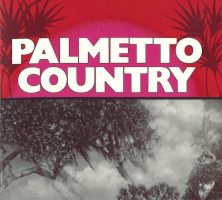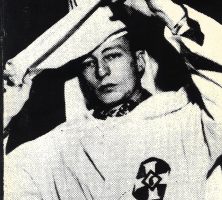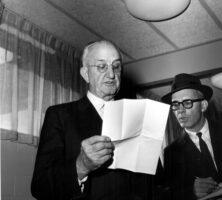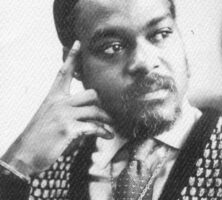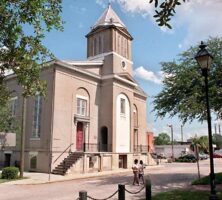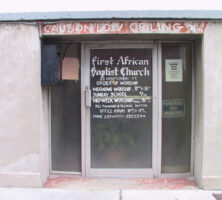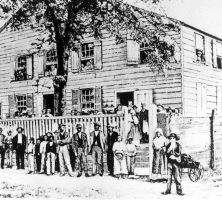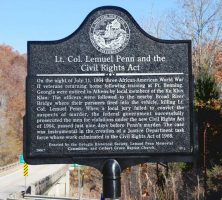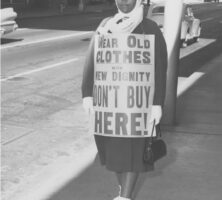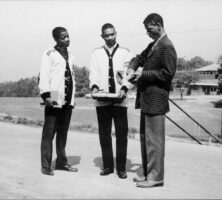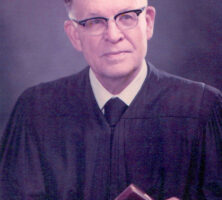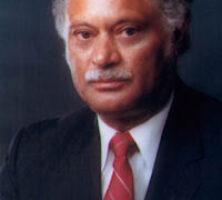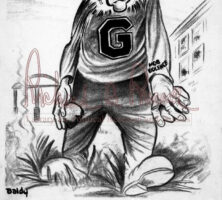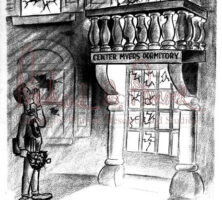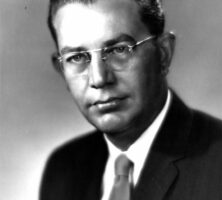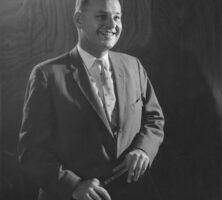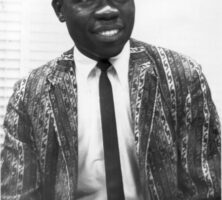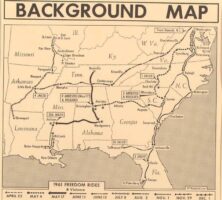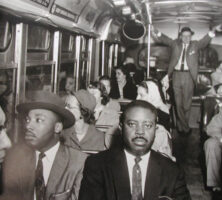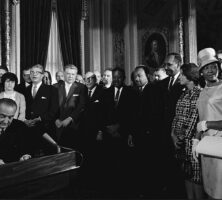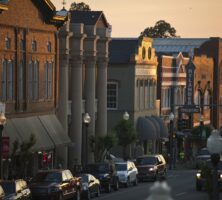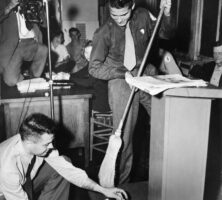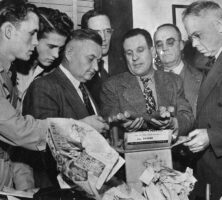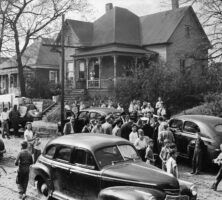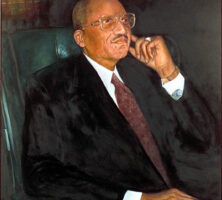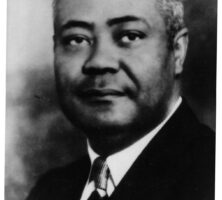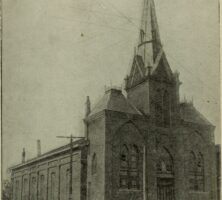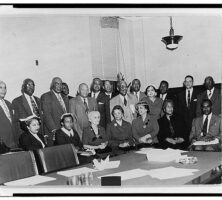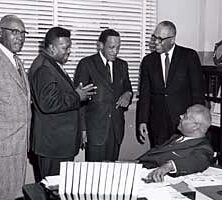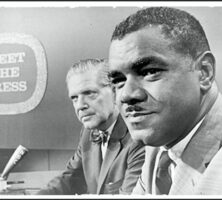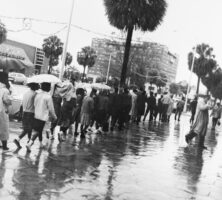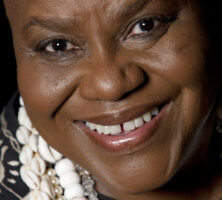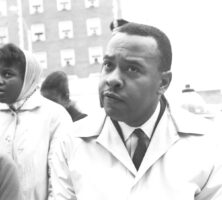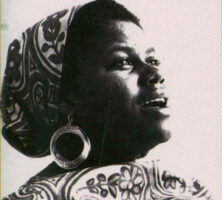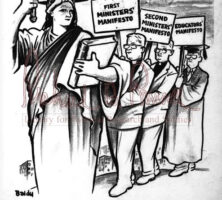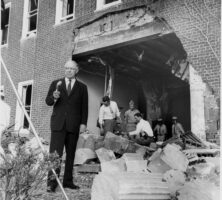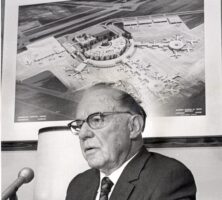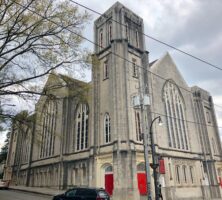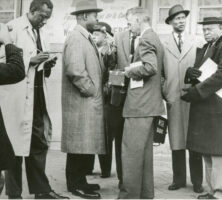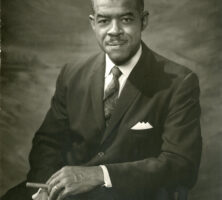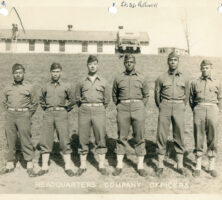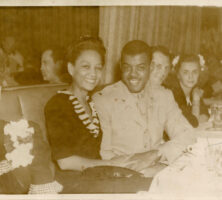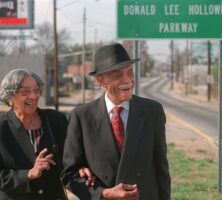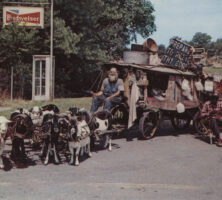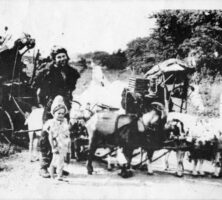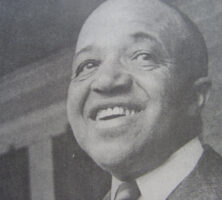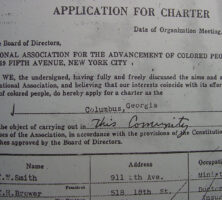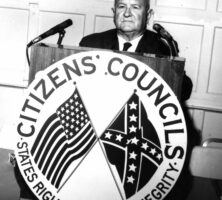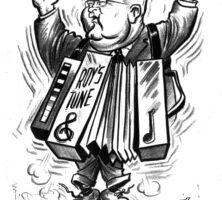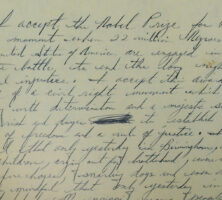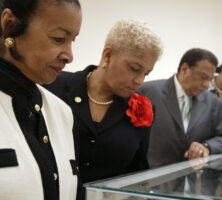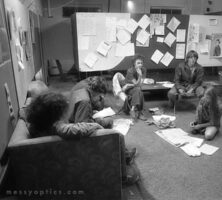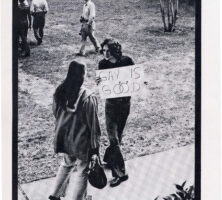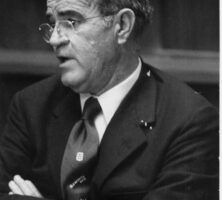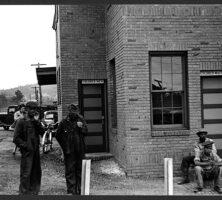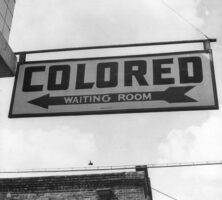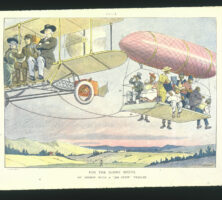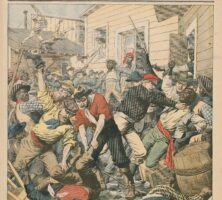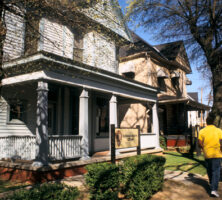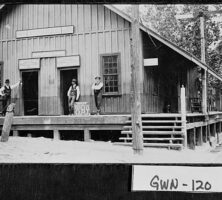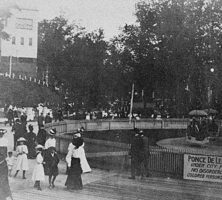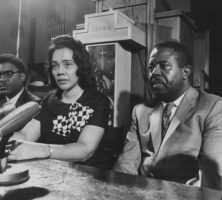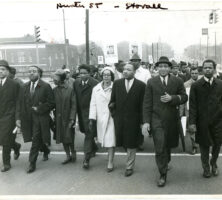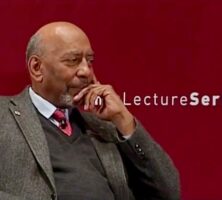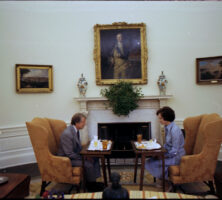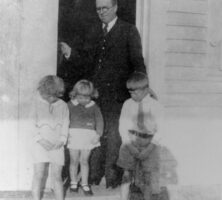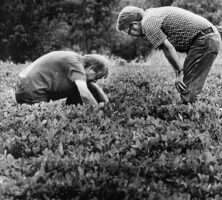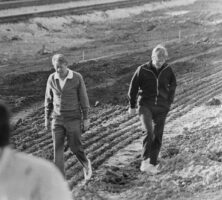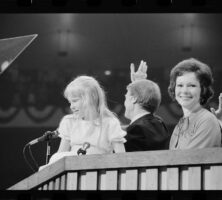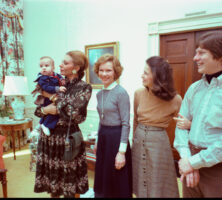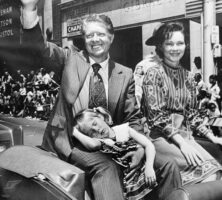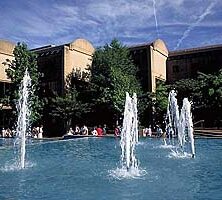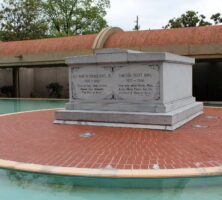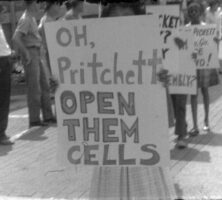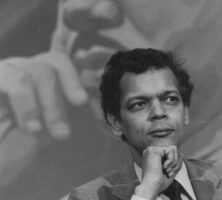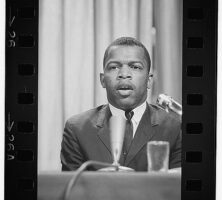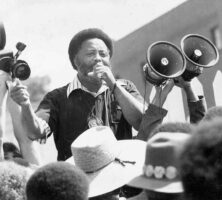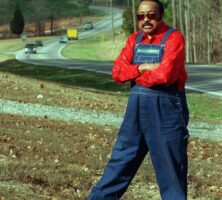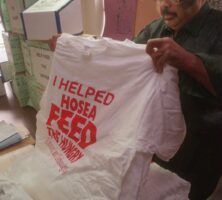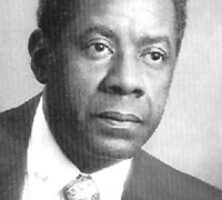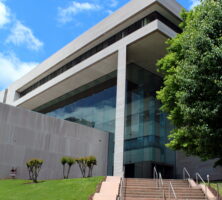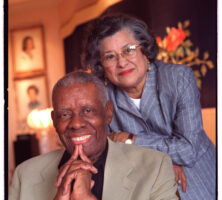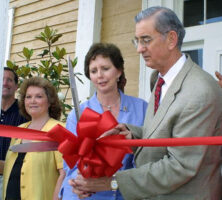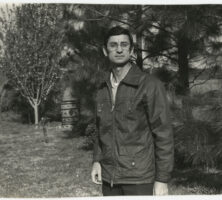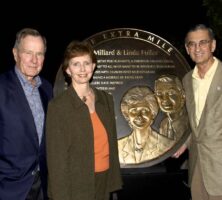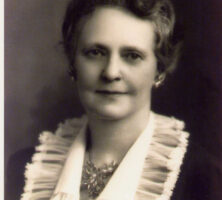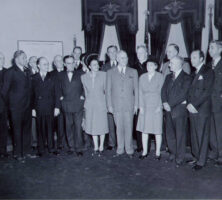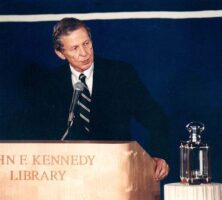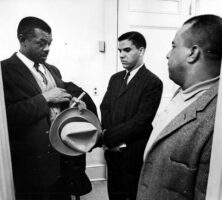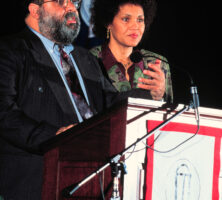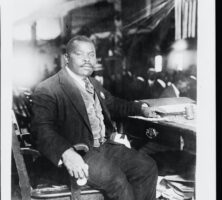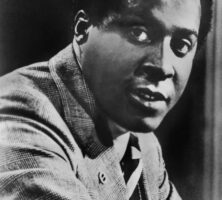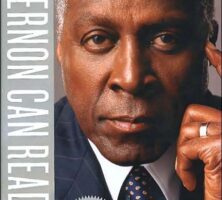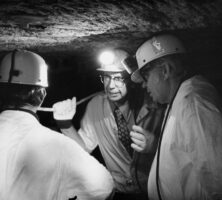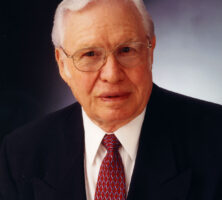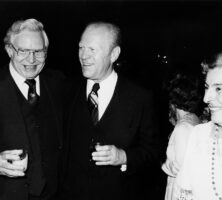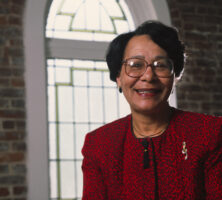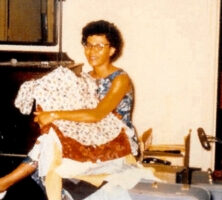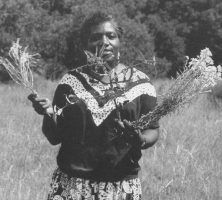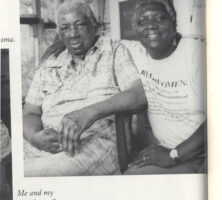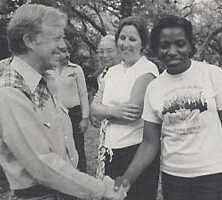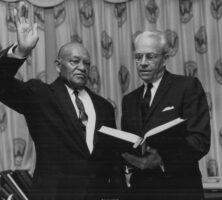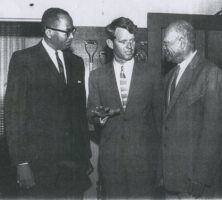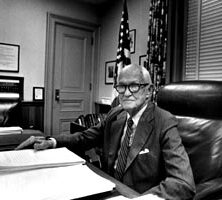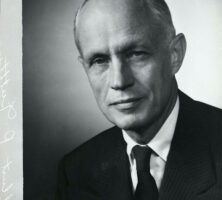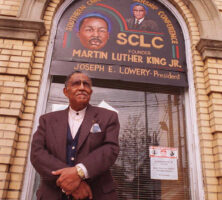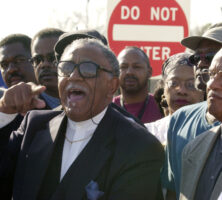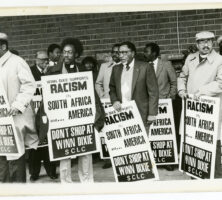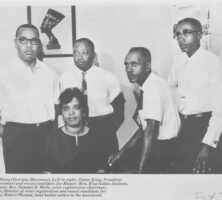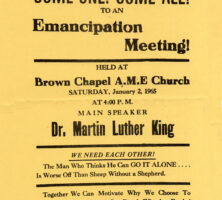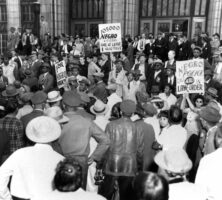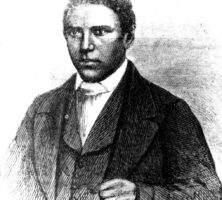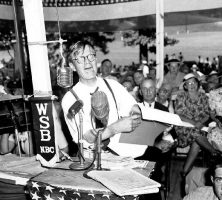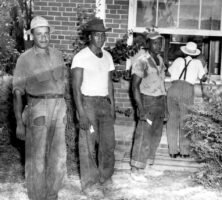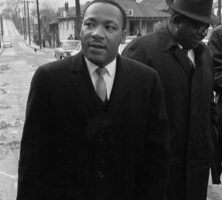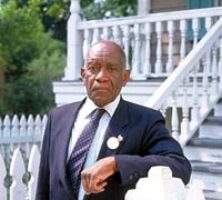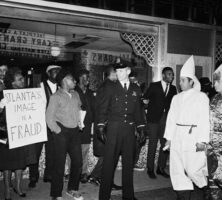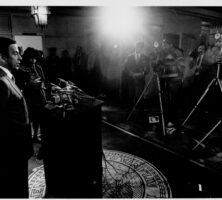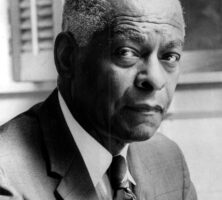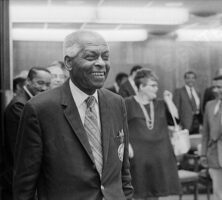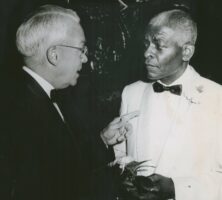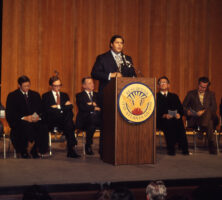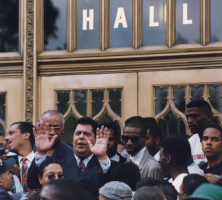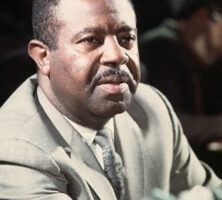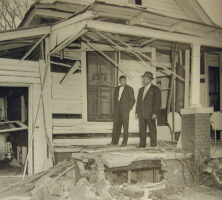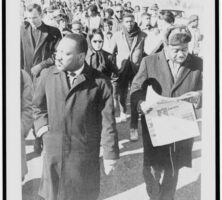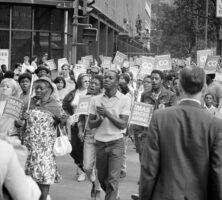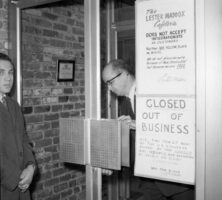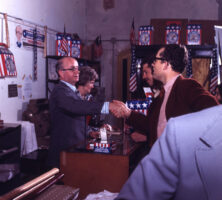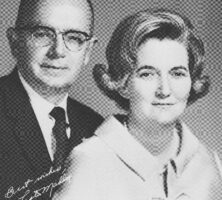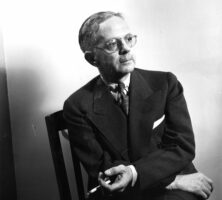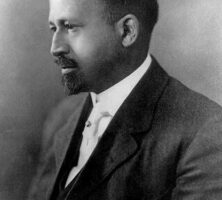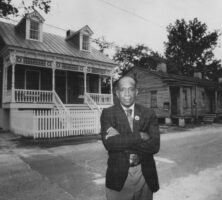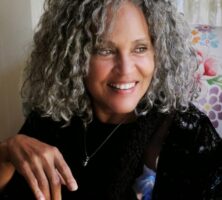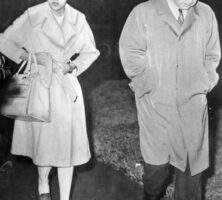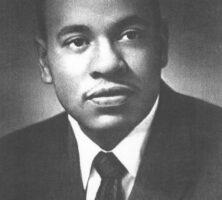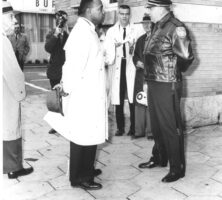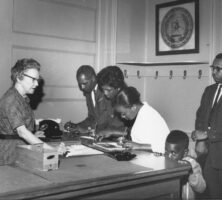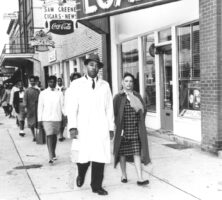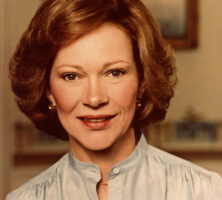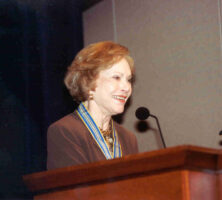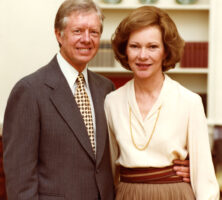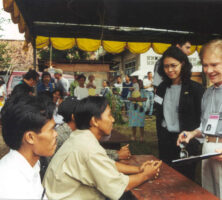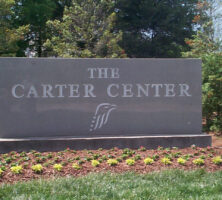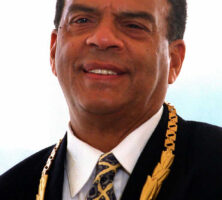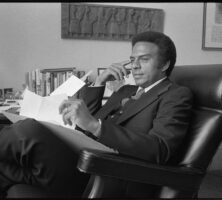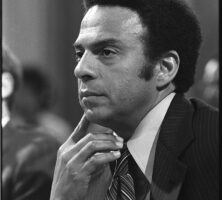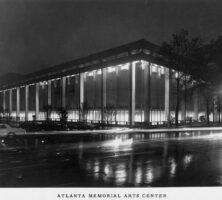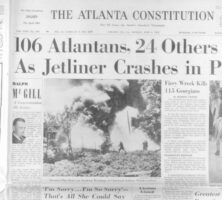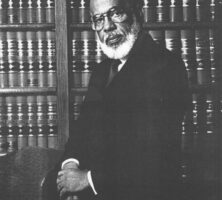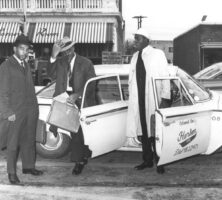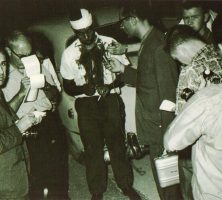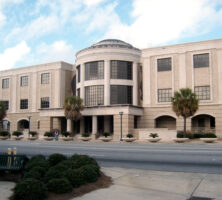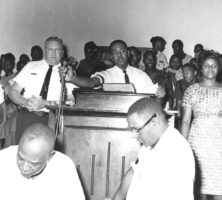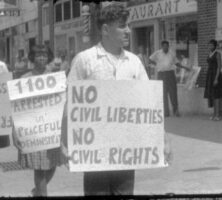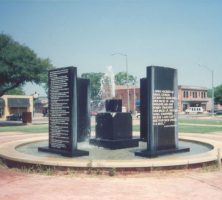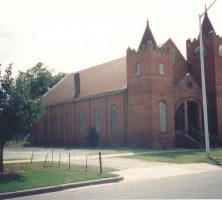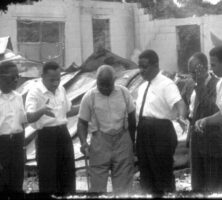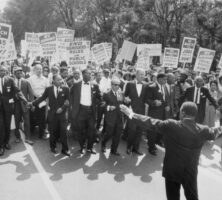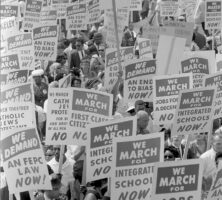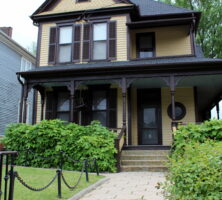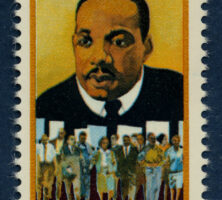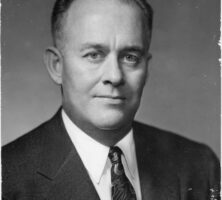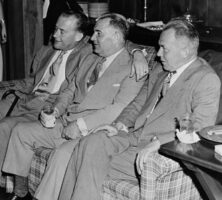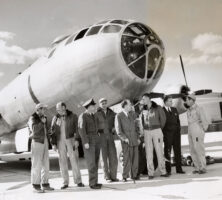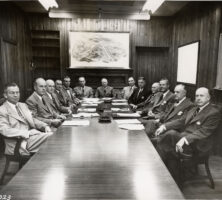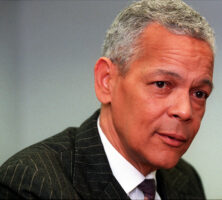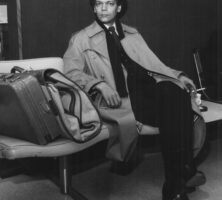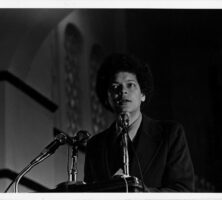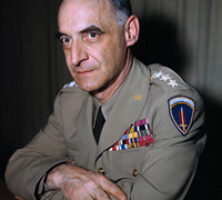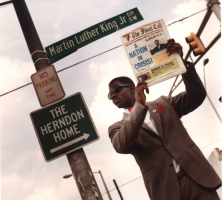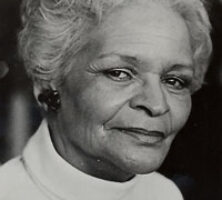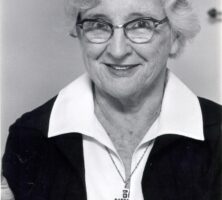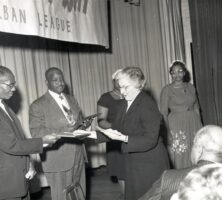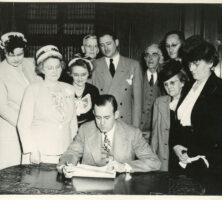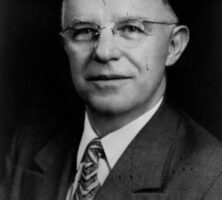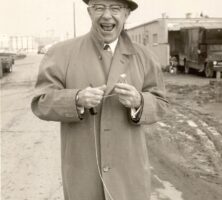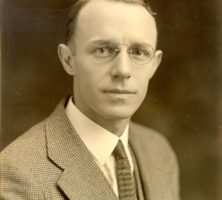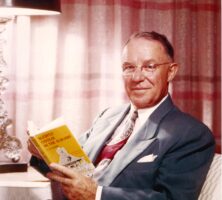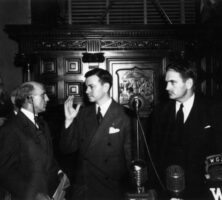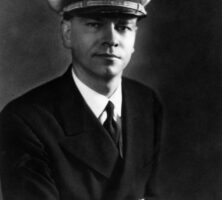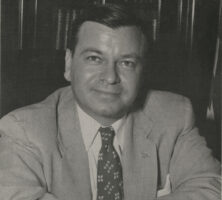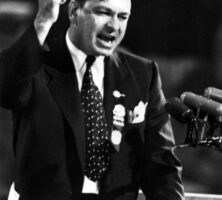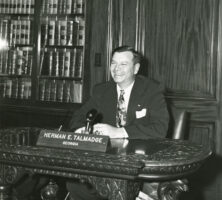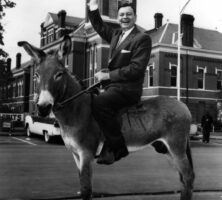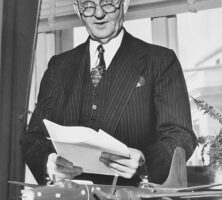The New Georgia Encyclopedia is supported by funding from A More Perfect Union, a special initiative of the National Endowment for the Humanities.
The Southern Comfort Conference was one of the most well-known transgender conferences in the United States. Originally held in Atlanta, it created a space where members of the transgender community could gather, learn about medical resources, and organize politically.
From the Digital Transgender Archive, Joseph A Labadie Collection, University of Michigan.
The New Georgia Encyclopedia does not hold the copyright for this media resource and can neither grant nor deny permission to republish or reproduce the image online or in print. All requests for permission to publish or reproduce the resource must be submitted to the rights holder.
The 2001 documentary Southern Comfort brought unprecedented attention and visibility to the Southern Comfort Conference. Directed by Kate Davis, the film follows the final months of long-time conference regular Robert Eads, a Georgian transgender man dying of ovarian cancer.
The New Georgia Encyclopedia does not hold the copyright for this media resource and can neither grant nor deny permission to republish or reproduce the image online or in print. All requests for permission to publish or reproduce the resource must be submitted to the rights holder.
Leonard Matlovich received a Bronze Star in 1966 for his service in the Vietnam War. Born in Savannah, he was one of the earliest activists to challenge the status of gays and lesbians in the U.S. military.
Courtesy of Hormel LGBTQIA Center, San Francisco Public Library, Cliff Anchor Papers (GLC 49), #GLC-0013.
The New Georgia Encyclopedia does not hold the copyright for this media resource and can neither grant nor deny permission to republish or reproduce the image online or in print. All requests for permission to publish or reproduce the resource must be submitted to the rights holder.
On May 11, 1970 protestors massed outside an Augusta municipal building to protest the killing of Charles Oatman, a developmentally disabled Black teenager, in the Richmond County Jail. In 2021 the Department of Justice, through its Cold Case initiative, reopened its investigation into the deaths of Oatman and six other Black Augustans killed in the ensuing protests.
From Reese Library Augusta University
The New Georgia Encyclopedia does not hold the copyright for this media resource and can neither grant nor deny permission to republish or reproduce the image online or in print. All requests for permission to publish or reproduce the resource must be submitted to the rights holder.
On May 11, 1970 thousands of Black Augustans participated in a major uprising against police violence. Known thereafter as the Augusta Riot, the event resulted in $1 million in property damage and was the largest Black rebellion in the civil rights South.
From the Augusta Chronicle
The New Georgia Encyclopedia does not hold the copyright for this media resource and can neither grant nor deny permission to republish or reproduce the image online or in print. All requests for permission to publish or reproduce the resource must be submitted to the rights holder.
On May 5, 1971 students held a national moratorium to remember the deaths of protestors at Kent State University, Jackson State University, and in Augusta the previous spring. In the years that followed, Kent State remained a national touchstone for repressive violence, while Black rebellions in Augusta, Jackson, and elsewhere receded from national memory.
From the Student Mobilization Committee to End the War in Vietnam
The New Georgia Encyclopedia does not hold the copyright for this media resource and can neither grant nor deny permission to republish or reproduce the image online or in print. All requests for permission to publish or reproduce the resource must be submitted to the rights holder.
The Negro Motorist Green-Book, also known as the Negro Traveller's Green-Book, was an essential guide for Black travelers between 1936 and 1966. This yearly publication, created by postal employee Victor Hugo Green, helped readers avoid sundown towns and locate safe lodging, gas stops, and eateries.
From Wikimedia
The New Georgia Encyclopedia does not hold the copyright for this media resource and can neither grant nor deny permission to republish or reproduce the image online or in print. All requests for permission to publish or reproduce the resource must be submitted to the rights holder.
Most Ku Klux Klan action was designed to intimidate Black voters and white supporters of the Republican Party. Founded in Tennessee in 1866, the Klan was particularly active in Georgia from 1868 to the early 1870s.
From Harper's Weekly
The New Georgia Encyclopedia does not hold the copyright for this media resource and can neither grant nor deny permission to republish or reproduce the image online or in print. All requests for permission to publish or reproduce the resource must be submitted to the rights holder.
White supremacists picketing at the first Brotherhood March on January 17, 1987, in Forsyth County.
Courtesy of Atlanta Journal-Constitution, Atlanta Journal-Constitution Photographic Archive, #AJCNS1987-01-17l.
The New Georgia Encyclopedia does not hold the copyright for this media resource and can neither grant nor deny permission to republish or reproduce the image online or in print. All requests for permission to publish or reproduce the resource must be submitted to the Atlanta Journal-Constitution.
Organized by civil rights activists Dean Carter, Charles Blackburn, and Hosea Williams, the Brotherhood March brought nationwide attention to Forsyth County's long history of racial violence and discrimination.
Courtesy of Atlanta History Center, Southline Press, Inc. Photographs, #VIS 158.18.05.
The New Georgia Encyclopedia does not hold the copyright for this media resource and can neither grant nor deny permission to republish or reproduce the image online or in print. Requests for permission to publish or reproduce the resource should be submitted to the Atlanta History Center.
Marchers demonstrate for fair housing in Forsyth County in 1987. The march, led by Hosea Williams, ended in a confrontation with Ku Klux Klansmen throwing rocks and bottles at the demonstrators. The incident brought national attention to Forsyth County and resulted in the indictment of two Klan organizations.
Courtesy of Atlanta Journal-Constitution.
The New Georgia Encyclopedia does not hold the copyright for this media resource and can neither grant nor deny permission to republish or reproduce the image online or in print. All requests for permission to publish or reproduce the resource must be submitted to the Atlanta Journal-Constitution.
Hosea Williams led two demonstration marches in Forsyth County in 1987. The first march, held in celebration of the Martin Luther King Jr. holiday, was attacked by several hundred members of the Ku Klux Klan. The second march, attended by Coretta Scott King, was held in protest of Klan activities in the county.
Courtesy of Atlanta Journal-Constitution.
The New Georgia Encyclopedia does not hold the copyright for this media resource and can neither grant nor deny permission to republish or reproduce the image online or in print. All requests for permission to publish or reproduce the resource must be submitted to the Atlanta Journal-Constitution.
Between 1931 and 1977, Black female employees at the Scripto factory in Atlanta organized against unfair wages and a discriminatory work environment. Their activism was a precursor to the civil rights movement.
Courtesy of Special Collections & Archives, Georgia State University Library, Lane Brothers Commercial Photographers Photographic Collection, #LBCB095-022a.
The New Georgia Encyclopedia does not hold the copyright for this media resource and can neither grant nor deny permission to republish or reproduce the image online or in print. Requests for permission to publish or reproduce the resource should be submitted to Special Collections and Archives at Georgia State University.
Black women made up more than 80 percent of the workforce at Scripto's factory in Atlanta. This 1958 advertisement depicts ballpoint pens, one of the company's most popular products.
Image from James Vaughan
The New Georgia Encyclopedia does not hold the copyright for this media resource and can neither grant nor deny permission to republish or reproduce the image online or in print. All requests for permission to publish or reproduce the resource must be submitted to the rights holder.
Cigarette lighters, such as the popular Compact Vu-Lighter shown here, were one of Scripto Inc.'s defining products, along with pens and mechanical pencils.
Image from Joe Haupt
The New Georgia Encyclopedia does not hold the copyright for this media resource and can neither grant nor deny permission to republish or reproduce the image online or in print. All requests for permission to publish or reproduce the resource must be submitted to the rights holder.
Operation Breadbasket was created in 1962 as a branch of the Southern Christian Leadership Conference (SCLC). A minister-led program, Operation Breadbasket worked to improve economic conditions in the Black community through boycotts and organized support.
Courtesy of Stuart A. Rose Manuscript, Archives, and Rare Book Library, Emory University, Southern Christian Leadership Records.
The New Georgia Encyclopedia does not hold the copyright for this media resource and can neither grant nor deny permission to republish or reproduce the image online or in print. For more information about this resource, contact the Stuart A. Rose Manuscript, Archives, and Rare Book Library at Emory University.
H. Rap Brown, the final leader of the Student Nonviolent Coordinating Committee, speaks at a press conference in 1967. In 1968 he changed the name of the organization to the Student National Coordinating Committee, marking the group's new willingness to use violence as a means of self-defense.
Courtesy of Library of Congress, Prints and Photographs Division
The New Georgia Encyclopedia does not hold the copyright for this media resource and can neither grant nor deny permission to republish or reproduce the image online or in print. All requests for permission to publish or reproduce the resource must be submitted to the rights holder.
H. Rap Brown was the fifth chairman of the Student Nonviolent Coordinating Committee (SNCC) and an honorary officer of the Black Panther Party in the late 1960s.
Courtesy of Atlanta University Center, Robert W. Woodruff Library Archives, The Clark Atlanta University Panther.
The New Georgia Encyclopedia does not hold the copyright for this media resource and can neither grant nor deny permission to republish or reproduce the image online or in print. All requests for permission to publish or reproduce the resource must be submitted to the Atlanta University Center Robert W. Woodruff Library and Archives Research Center.
Civil rights activist H. Rap Brown was elected chairman of the Student Nonviolent Coordinating Committee (SNCC) in 1967. Brown's radical vision and aggressive rhetoric marked a shift from the nonviolent civil disobedience prescribed by Martin Luther King Jr.
Courtesy of Atlanta University Center, Robert W. Woodruff Library Archives, The Clark Atlanta University Panther.
The New Georgia Encyclopedia does not hold the copyright for this media resource and can neither grant nor deny permission to republish or reproduce the image online or in print. All requests for permission to publish or reproduce the resource must be submitted to the Atlanta University Center Robert W. Woodruff Library and Archives Research Center.
H. Rap Brown's leadership of the Student Nonviolent Coordination Committee (SNCC) was characterized by radical discourse, as seen in SNCC's newsletters from the late 1960s.
Image from Washington Area Spark
The New Georgia Encyclopedia does not hold the copyright for this media resource and can neither grant nor deny permission to republish or reproduce the image online or in print. All requests for permission to publish or reproduce the resource must be submitted to the rights holder.
Jamil Abdullah Al-Amin (formerly H. Rap Brown) is pictured in 1990 in front of his grocery store in Atlanta's West End. Al-Amin was arrested in 1999 for his involvement in the fatal shooting of a police officer and later sentenced to life in prison.
Courtesy of Atlanta Journal-Constitution.
The New Georgia Encyclopedia does not hold the copyright for this media resource and can neither grant nor deny permission to republish or reproduce the image online or in print. All requests for permission to publish or reproduce the resource must be submitted to the Atlanta Journal-Constitution.
James and Robert Paschal opened Paschal Brothers Soda, a thirty-seat luncheonette at 837 West Hunter Street, in 1947. They are pictured here in 1978.
Courtesy of Special Collections & Archives, Georgia State University Library, Atlanta Journal-Constitution Photographic Archive.
The New Georgia Encyclopedia does not hold the copyright for this media resource and can neither grant nor deny permission to republish or reproduce the image online or in print. Requests for permission to publish or reproduce the resource should be submitted to Special Collections and Archives at Georgia State University.
In 1967 Paschal’s underwent a major expansion with the addition of a six-story, 120-room motel. Paschal’s Motor Hotel was the first Black-owned hotel in Atlanta.
Courtesy of Special Collections & Archives, Georgia State University Library, Atlanta Journal-Constitution Photographic Archive.
The New Georgia Encyclopedia does not hold the copyright for this media resource and can neither grant nor deny permission to republish or reproduce the image online or in print. Requests for permission to publish or reproduce the resource should be submitted to Special Collections and Archives at Georgia State University.
Robert Paschal prepares the restaurant's famous fried chicken, the recipe for which remains a secret to this day.
Courtesy of Special Collections & Archives, Georgia State University Library, Atlanta Journal-Constitution Photographic Archive.
The New Georgia Encyclopedia does not hold the copyright for this media resource and can neither grant nor deny permission to republish or reproduce the image online or in print. Requests for permission to publish or reproduce the resource should be submitted to Special Collections and Archives at Georgia State University.
Representative John Lewis speaks for Atlanta' Concerned Black Clergy at Paschal's Restaurant in 1988. The relationships that James and Robert Paschal built within the city’s Black community made Paschal’s a central meeting spot during the civil rights movement and helped earn the restaurant its reputation as Atlanta’s “Black City Hall.”
Courtesy of Special Collections & Archives, Georgia State University Library, Atlanta Journal-Constitution Photographic Archive.
The New Georgia Encyclopedia does not hold the copyright for this media resource and can neither grant nor deny permission to republish or reproduce the image online or in print. Requests for permission to publish or reproduce the resource should be submitted to Special Collections and Archives at Georgia State University.
Reverend Joseph E. Lowery (right) and mayoral candidate Maynard Jackson at a 1989 campaign event at Paschal's Motor Hotel. Paschal’s was a hotbed of political activity for Atlanta’s African American community.
Courtesy of Special Collections & Archives, Georgia State University Library, Atlanta Journal-Constitution Photographic Archive.
The New Georgia Encyclopedia does not hold the copyright for this media resource and can neither grant nor deny permission to republish or reproduce the image online or in print. Requests for permission to publish or reproduce the resource should be submitted to Special Collections and Archives at Georgia State University.
Soldiers at the Atlanta Army General Depot in 1967 show their support of the troops in Vietnam.
Courtesy of Garrison Public Affairs Office, Fort McPherson
The New Georgia Encyclopedia does not hold the copyright for this media resource and can neither grant nor deny permission to republish or reproduce the image online or in print. All requests for permission to publish or reproduce the resource must be submitted to the rights holder.
U.S. senator Richard B. Russell Jr. (left) converses with U.S. president Lyndon B. Johnson in 1968. Russell, an early supporter of and mentor to Johnson, criticized the Johnson administration's escalation of the war in Vietnam during the 1960s.
Courtesy of Richard B. Russell Library for Political Research and Studies, University of Georgia Libraries, Richard B. Russell Jr. Collection.
The New Georgia Encyclopedia does not hold the copyright for this media resource and can neither grant nor deny permission to republish or reproduce the image online or in print. Requests for permission to publish or reproduce the resource may need to be submitted to the Richard B. Russell Library for Political Research and Studies at the University of Georgia.
Dean Rusk served as U.S. secretary of state from 1961 to 1969. During that period of service under Presidents John F. Kennedy and Lyndon B. Johnson, he was a primary architect of U.S. intervention in the Vietnam War on the side of the South Vietnamese.
Courtesy of Richard B. Russell Library for Political Research and Studies, University of Georgia Libraries, Dean Rusk Research Collection.
The New Georgia Encyclopedia does not hold the copyright for this media resource and can neither grant nor deny permission to republish or reproduce the image online or in print. Requests for permission to publish or reproduce the resource may need to be submitted to the Richard B. Russell Library for Political Research and Studies at the University of Georgia.
Pictured in 1966, Julian Bond was elected to the Georgia House of Representatives in 1965, but the legislature refused to seat him because of his outspoken opposition to the Vietnam War. In December 1966 the U.S. Supreme Court declared the actions of the house unconstitutional, and Bond was finally sworn in on January 9, 1967.
Courtesy of Atlanta Journal-Constitution.
The New Georgia Encyclopedia does not hold the copyright for this media resource and can neither grant nor deny permission to republish or reproduce the image online or in print. All requests for permission to publish or reproduce the resource must be submitted to the Atlanta Journal-Constitution.
Graffiti left by antiwar protestors marks the military building at the University of Georgia in Athens during the Vietnam War (1964-73). Student activists at UGA attempted to burn down the building five times between 1968 and 1972. The slogan "Che Lives" is a reference to Che Guevara, a leader of the socialist revolution in Cuba and an icon of the American New Left. He was captured and executed in Bolivia in 1967.
The New Georgia Encyclopedia does not hold the copyright for this media resource and can neither grant nor deny permission to republish or reproduce the image online or in print. Requests for permission to publish or reproduce the resource should be submitted to the Hargrett Manuscript and Rare Book Library at the University of Georgia.
In 1970 demonstrators in downtown Atlanta protest U.S. involvement in the Vietnam War (1964-73). Most antiwar marches in the city, which took place from the late 1960s to the early 1970s, followed a route down Peachtree Street to Piedmont Park.
Photograph by Carter Tomassi
The New Georgia Encyclopedia does not hold the copyright for this media resource and can neither grant nor deny permission to republish or reproduce the image online or in print. All requests for permission to publish or reproduce the resource must be submitted to the rights holder.
William Calley Jr., depicted here in an artist rendering of his 1971 court-martial, was the only U.S. soldier convincted for his role in the My Lai Massacre.
Courtesy of Library of Congress, Prints and Photographs Division, Sketch by Howard Brodie.
The New Georgia Encyclopedia does not hold the copyright for this media resource and can neither grant nor deny permission to republish or reproduce the image online or in print. All requests for permission to publish or reproduce the resource must be submitted to the rights holder.
In 1968, during the Vietnam War, Max Cleland (far right) was injured in an accident, in which he lost both his legs and his right hand. He was awarded the Silver Star and the Soldier's Medal.
Courtesy of Atlanta Journal-Constitution.
The New Georgia Encyclopedia does not hold the copyright for this media resource and can neither grant nor deny permission to republish or reproduce the image online or in print. All requests for permission to publish or reproduce the resource must be submitted to the Atlanta Journal-Constitution.
At a press conference, Assistant Police Chief Eldrin Bell holds up a photo of one of the victims of the Atlanta youth murders. From 1979 through 1981, at least twenty-nine Atlantans between the ages of seven and twenty-seven were abducted and slain.
Courtesy of Special Collections & Archives, Georgia State University Library, Atlanta Journal-Constitution Photographic Archive.
The New Georgia Encyclopedia does not hold the copyright for this media resource and can neither grant nor deny permission to republish or reproduce the image online or in print. Requests for permission to publish or reproduce the resource should be submitted to Special Collections and Archives at Georgia State University.
During the Atlanta youth murders, Techwood Homes community members formed a neighborhood "Bat Patrol." By the time city officials established a formal task force to investigate the killings, eleven young Atlantas had already been added to the list of missing and murdered.
Courtesy of Special Collections & Archives, Georgia State University Library, Atlanta Journal-Constitution Photographic Archive.
The New Georgia Encyclopedia does not hold the copyright for this media resource and can neither grant nor deny permission to republish or reproduce the image online or in print. Requests for permission to publish or reproduce the resource should be submitted to Special Collections and Archives at Georgia State University.
The remains of the Gate City Day Nursery after an explosion on October 29, 1980, that claimed the lives of five people, including four Black children. Though the blast was attributed to an overheated boiler, many community members and observers remained unconvinced that it was an accident.
Courtesy of Special Collections & Archives, Georgia State University Library, Atlanta Journal-Constitution Photographic Archive.
The New Georgia Encyclopedia does not hold the copyright for this media resource and can neither grant nor deny permission to republish or reproduce the image online or in print. Requests for permission to publish or reproduce the resource should be submitted to Special Collections and Archives at Georgia State University.
From July 1979 through May 1981 the Atlanta child murders took place. With leads in the case dwindling and no arrest in sight, Atlanta mayor Maynard Jackson imposed a 7:00 p.m. curfew on the city's children and offered a $10,000 reward (pictured) for information about the perpetrator of the crimes.
Courtesy of Atlanta Journal-Constitution.
The New Georgia Encyclopedia does not hold the copyright for this media resource and can neither grant nor deny permission to republish or reproduce the image online or in print. All requests for permission to publish or reproduce the resource must be submitted to the Atlanta Journal-Constitution.
Atlanta youth murders suspect Wayne Williams is escorted back to Fulton County Jail after a hearing in 1981. Williams would eventually be convicted of two murders and implicated in virtually all of the others.
Courtesy of Special Collections & Archives, Georgia State University Library, Atlanta Journal-Constitution Photographic Archive.
The New Georgia Encyclopedia does not hold the copyright for this media resource and can neither grant nor deny permission to republish or reproduce the image online or in print. Requests for permission to publish or reproduce the resource should be submitted to Special Collections and Archives at Georgia State University.
Howard Moore Jr., a civil rights attorney from Atlanta, handled a number of precedent-setting cases in the 1960s and 1970s. He is best known for serving as lead counsel on the Angela Davis trial.
The New Georgia Encyclopedia does not hold the copyright for this media resource and can neither grant nor deny permission to republish or reproduce the image online or in print. For more information about this resource, contact the Stuart A. Rose Manuscript, Archives, and Rare Book Library at Emory University.
Howard Moore Jr. grew up near the Auburn Avenue neighborhood in Atlanta. After attending law school in Boston, he returned to Atlanta and soon developed a reputation as the go-to defense attorney for political activists.
The New Georgia Encyclopedia does not hold the copyright for this media resource and can neither grant nor deny permission to republish or reproduce the image online or in print. For more information about this resource, contact the Stuart A. Rose Manuscript, Archives, and Rare Book Library at Emory University.
Howard Moore Jr., depicted here in a court-rendering alongside Angela Davis, relocated to California in 1971 to serve as lead counsel for Davis's trial. The jury found Davis not guilty in June 1972.
Photograph from Bancroft Library, University of California Berkeley
The New Georgia Encyclopedia does not hold the copyright for this media resource and can neither grant nor deny permission to republish or reproduce the image online or in print. All requests for permission to publish or reproduce the resource must be submitted to the rights holder.
Noted civil rights attorney Howard Moore Jr., depicted in this courtroom sketch, speaks in defense of his client Angela Davis. Moore served as lead counsel on a number of high-profile cases.
Photograph from Bancroft Library, University of California Berkeley
The New Georgia Encyclopedia does not hold the copyright for this media resource and can neither grant nor deny permission to republish or reproduce the image online or in print. All requests for permission to publish or reproduce the resource must be submitted to the rights holder.
The National Committee to Free the Ingram Family worked to promote public interest in Rosa Lee Ingram's case. Their efforts included this Mother's Day postcard campaign addressed to President Truman.
Image by the National Committee to Free the Ingram Family, Wikimedia
The New Georgia Encyclopedia does not hold the copyright for this media resource and can neither grant nor deny permission to republish or reproduce the image online or in print. All requests for permission to publish or reproduce the resource must be submitted to the rights holder.
Rosa Lee Ingram and two of her adolescent sons were sentenced to death for their role in the death of a white landowner in 1948. Their conviction raised considerable doubt about the integrity of Georgia's judicial system and prompted a nationwide campaign to secure their release from prison.
Photograph from BlackPast.org
The New Georgia Encyclopedia does not hold the copyright for this media resource and can neither grant nor deny permission to republish or reproduce the image online or in print. All requests for permission to publish or reproduce the resource must be submitted to the rights holder.
Supporters of Rosa Lee Ingram wait outside the offices of the Georgia State Board of Pardons and Paroles during her 1953 parole hearing. The Ingrams were denied parole several times before their release from prison in 1959.
Photograph by Norma Holt, from the Schomburg Center for Research in Black Culture, Photographs and Prints Division, New York Public Library
The New Georgia Encyclopedia does not hold the copyright for this media resource and can neither grant nor deny permission to republish or reproduce the image online or in print. All requests for permission to publish or reproduce the resource must be submitted to the rights holder.
Captain Ernest L. Medina testifies during the 1971 trial of Lieutenant William Calley Jr. The army Peers Commission concluded that Calley's platoon was responsible for roughly one-third of the deaths at My Lai, and Calley was found guilty on twenty-two counts of premeditated murder. . troops killed hundreds of unarmed civilians in a small coastal village inQiang Ngai province, South Vietnam
Courtesy of Library of Congress, Prints and Photographs Division, Sketch by Howard Brodie.
The New Georgia Encyclopedia does not hold the copyright for this media resource and can neither grant nor deny permission to republish or reproduce the image online or in print. All requests for permission to publish or reproduce the resource must be submitted to the rights holder.
Crowds gather in Liberty Plaza near the Georgia Capitol for the eighteenth Annual Disability Day on February 18, 2016.
Courtesy of Ryan Johnson
The New Georgia Encyclopedia does not hold the copyright for this media resource and can neither grant nor deny permission to republish or reproduce the image online or in print. All requests for permission to publish or reproduce the resource must be submitted to the rights holder.
Governor Nathan Deal, with First Lady Sandra Deal, addresses the Disability Day crowd on February 20, 2014.
Courtesy of Ryan Johnson
The New Georgia Encyclopedia does not hold the copyright for this media resource and can neither grant nor deny permission to republish or reproduce the image online or in print. All requests for permission to publish or reproduce the resource must be submitted to the rights holder.
From left to right: Sue Jamieson (Atlanta Legal Aid Society) and Olmstead case plaintiffs Elaine Watson and Lois Curtis in 2003.
Photograph used by permission of Institute on Human Development and Disability (UCEDD), College of Family and Consumer Sciences, the University of Georgia
The New Georgia Encyclopedia does not hold the copyright for this media resource and can neither grant nor deny permission to republish or reproduce the image online or in print. All requests for permission to publish or reproduce the resource must be submitted to the rights holder.
Amy Mallard (far left) is pictured in January 1949 outside the Toombs County Courthouse, where she testified at the trial of William Howell, one of several men accused of killing her husband in a racially motivated attack. Mallard was accompainied by Joseph Goldwasser, a member of the NAACP in Cleveland, Ohio, along with her son, John Mallard, and her daughter, Doris Byron.
Courtesy of Getty Images, Francis Miller/The LIFE Picture Collection.
The New Georgia Encyclopedia does not hold the copyright for this media resource and can neither grant nor deny permission to republish or reproduce the image online or in print. All requests for permission to publish or reproduce the resource must be submitted to the rights holder.
A crowd gathered in the Toombs County Courthouse on January 11, 1949, for the trial of William Howell, a white man accused of killing his Black neighbor Robert Mallard. Mallard's wife, Amy, witnessed the murder and testified at the trial, after she was falsely accused of committing the crime herself.
Courtesy of Getty Images, Francis Miller/The LIFE Picture Collection.
The New Georgia Encyclopedia does not hold the copyright for this media resource and can neither grant nor deny permission to republish or reproduce the image online or in print. All requests for permission to publish or reproduce the resource must be submitted to the rights holder.
King George II granted James Oglethorpe and the Trustees a charter in 1732 to establish the colony of Georgia. This charter provided, among other things, that the new colony would consist of all the land between the headwaters of the Savannah and the Altamaha rivers, with its eastern boundary formed by the Atlantic Ocean and its western boundary by the "south seas," a reference to the Pacific Ocean.
Map by John Nelson. Reprinted by permission of William J. Morton
The New Georgia Encyclopedia does not hold the copyright for this media resource and can neither grant nor deny permission to republish or reproduce the image online or in print. All requests for permission to publish or reproduce the resource must be submitted to the rights holder.
In 1763 the British divided what had been Spanish Florida into the two new colonies of West Florida and East Florida, with the Apalachicola River serving as the dividing line between them. East Florida was all the land east of the Apalachicola River, with St. Augustine as its capital.
Map by John Nelson. Reprinted by permission of William J. Morton
The New Georgia Encyclopedia does not hold the copyright for this media resource and can neither grant nor deny permission to republish or reproduce the image online or in print. All requests for permission to publish or reproduce the resource must be submitted to the rights holder.
In 1763 the British divided what had been Spanish Florida into the two new colonies of West Florida and East Florida, with the Apalachicola River serving as the dividing line between them. West Florida, with Pensacola as its capital, extended west to the Mississippi River.
Map by John Nelson. Reprinted by permission of William J. Morton
The New Georgia Encyclopedia does not hold the copyright for this media resource and can neither grant nor deny permission to republish or reproduce the image online or in print. All requests for permission to publish or reproduce the resource must be submitted to the rights holder.
The appointment of James Wright in 1760 as governor of Georgia coincided with a period of expansion. By 1764 the boundaries of the colony had expanded to include those territories between the Mississippi and Chattahoochee rivers that had not been granted to the Florida colonies.
Map by John Nelson. Reprinted by permission of William J. Morton
The New Georgia Encyclopedia does not hold the copyright for this media resource and can neither grant nor deny permission to republish or reproduce the image online or in print. All requests for permission to publish or reproduce the resource must be submitted to the rights holder.
In 1767 the governor of West Florida received permission from the king of England to advance the colony's northern border along the Mississippi and Chattahoochee rivers, where royal trading posts were located. Georgia's land holdings significantly decreased as a result.
Map by John Nelson. Reprinted by permission of William J. Morton
The New Georgia Encyclopedia does not hold the copyright for this media resource and can neither grant nor deny permission to republish or reproduce the image online or in print. All requests for permission to publish or reproduce the resource must be submitted to the rights holder.
The 1783 Treaty of Paris, which ended the Revolutionary War (1775-83), fixed the 31st latitude north as the southern boundary of the new United States. The line extended from the Mississippi River eastward to the Chattahoochee River, moved down that river to its junction with the Flint River, and then followed a direct line east to the headwaters of the St. Marys River.
Map by John Nelson. Reprinted by permission of William J. Morton
The New Georgia Encyclopedia does not hold the copyright for this media resource and can neither grant nor deny permission to republish or reproduce the image online or in print. All requests for permission to publish or reproduce the resource must be submitted to the rights holder.
The Orr-Whitner line was accepted by Florida in 1861 and Georgia in 1866 as their official boundary, although the outbreak of the Civil War (1861-65) delayed the line's approval by the U.S. Congress until 1872.
Map by John Nelson. Reprinted by permission of William J. Morton
The New Georgia Encyclopedia does not hold the copyright for this media resource and can neither grant nor deny permission to republish or reproduce the image online or in print. All requests for permission to publish or reproduce the resource must be submitted to the rights holder.
In 1811 Georgia hired Andrew Ellicott to survey and mark the location of the 35th latitude north, which formed the boundary between Georgia and North Carolina. In an 1812 letter to North Carolina governor William Hawkins, Ellicott states: "In the parallel of 35 degree N. latitude, on the west side of the Chatoga river, a stone is set up marked on the South side (G. lat 35 N.) and on the north side, (N.C.) for North Carolina." This map locates what is currently and erroneously called Ellicott's Rock on the east side of the Chattooga River.
Map by John Nelson. Reprinted by permission of William J. Morton
The New Georgia Encyclopedia does not hold the copyright for this media resource and can neither grant nor deny permission to republish or reproduce the image online or in print. All requests for permission to publish or reproduce the resource must be submitted to the rights holder.
This map shows the surveyed line as marked by James Camak, which set Georgia's northern boundary line south of the 35th latitude north, including the offset known as Montgomery's Corner.
Map by John Nelson. Reprinted by permission of William J. Morton
The New Georgia Encyclopedia does not hold the copyright for this media resource and can neither grant nor deny permission to republish or reproduce the image online or in print. All requests for permission to publish or reproduce the resource must be submitted to the rights holder.
Following the 1802 Article of Agreement and Cession, Georgia's new western boundary began with the juncture of the Chattahoochee and Flint rivers in southwest Georgia and proceeded north to the great bend of the river (at present-day West Point, Georgia). From there it stretched for 160 miles to the Indian village of Nickajack on the Tennessee River and continued from there up to the 35th latitude north.
Map by John Nelson. Reprinted by permission of William J. Morton
The New Georgia Encyclopedia does not hold the copyright for this media resource and can neither grant nor deny permission to republish or reproduce the image online or in print. All requests for permission to publish or reproduce the resource must be submitted to the rights holder.
Voters in Fulton County line up at the polls in the early 1970s.
Courtesy of Atlanta University Center, Robert W. Woodruff Library Archives, Voter Education Project Organizational Records.
The New Georgia Encyclopedia does not hold the copyright for this media resource and can neither grant nor deny permission to republish or reproduce the image online or in print. All requests for permission to publish or reproduce the resource must be submitted to the Atlanta University Center Robert W. Woodruff Library and Archives Research Center.
A flyer produced by the Voter Education Project in the early 1970s refers to the protests in Selma, Alabama, in 1965. The VEP, formed in 1962 as a program of the Southern Regional Council, was a voting rights and voter education organization based in Atlanta for thirty years.
Courtesy of Atlanta University Center, Robert W. Woodruff Library Archives, Voter Education Project Organizational Records.
The New Georgia Encyclopedia does not hold the copyright for this media resource and can neither grant nor deny permission to republish or reproduce the image online or in print. All requests for permission to publish or reproduce the resource must be submitted to the Atlanta University Center Robert W. Woodruff Library and Archives Research Center.
A flyer produced by the Voter Education Project in the early 1970s encouraged African Americans to exercise their right to vote. Based in Atlanta, the VEP promoted voter registration and education, and became known as an authoritative source on southern elections in general.
Courtesy of Atlanta University Center, Robert W. Woodruff Library Archives, Voter Education Project Organizational Records.
The New Georgia Encyclopedia does not hold the copyright for this media resource and can neither grant nor deny permission to republish or reproduce the image online or in print. All requests for permission to publish or reproduce the resource must be submitted to the Atlanta University Center Robert W. Woodruff Library and Archives Research Center.
John Lewis (left), who served as executive director of the Voter Education Project from 1971 to 1977, is pictured with Julian Bond in the Mississippi Delta during a Voter Mobilization Tour in 1971.
The New Georgia Encyclopedia does not hold the copyright for this media resource and can neither grant nor deny permission to republish or reproduce the image online or in print. All requests for permission to publish or reproduce the resource must be submitted to the Atlanta University Center Robert W. Woodruff Library and Archives Research Center.
A voter casts his ballot in Fulton County, circa 1972.
Courtesy of Atlanta University Center, Robert W. Woodruff Library Archives, Voter Education Project Organizational Records.
The New Georgia Encyclopedia does not hold the copyright for this media resource and can neither grant nor deny permission to republish or reproduce the image online or in print. All requests for permission to publish or reproduce the resource must be submitted to the Atlanta University Center Robert W. Woodruff Library and Archives Research Center.
Jean Childs Young (left), pictured with Rosalynn Carter in 1979, was appointed by U.S. president Jimmy Carter as chair of the 1979 International Year of the Child, a program celebrating the twentieth anniversary of the United Nations Declaration of the Rights of the Child. The program also worked to raise awareness of children's rights and issues.
Courtesy of Archives Division, Auburn Avenue Research Library on African American Culture and History, Atlanta-Fulton Public Library System. Photograph by Rick Reinhard
The New Georgia Encyclopedia does not hold the copyright for this media resource and can neither grant nor deny permission to republish or reproduce the image online or in print. All requests for permission to publish or reproduce the resource must be submitted to the rights holder.
Jean Childs Young, pictured circa 1985, was the wife of Georgia politician and civil rights leader Andrew Young. She was renowned nationally and internationally for her work as an educator and advocate for children's rights.
Courtesy of Archives Division, Auburn Avenue Research Library on African American Culture and History, Atlanta-Fulton Public Library System
The New Georgia Encyclopedia does not hold the copyright for this media resource and can neither grant nor deny permission to republish or reproduce the image online or in print. All requests for permission to publish or reproduce the resource must be submitted to the rights holder.
In 1953, the year before she married civil rights leader Andrew Young, Jean Childs became the first African American to be elected "May Queen" at Manchester College in Indiana. She graduated from Manchester with a bachelor's degree in elementary education and later earned her master's degree in education from Queens College in New York City.
Courtesy of Archives Division, Auburn Avenue Research Library on African American Culture and History, Atlanta-Fulton Public Library System
The New Georgia Encyclopedia does not hold the copyright for this media resource and can neither grant nor deny permission to republish or reproduce the image online or in print. All requests for permission to publish or reproduce the resource must be submitted to the rights holder.
Jean Childs Young is pictured with her husband, Andrew Young, during his tenure as mayor of Atlanta in the 1980s. During those years, Jean Childs Young founded and chaired the Mayor's Task Force on Public Education and was active in other educational endeavors, including the Georgia Alliance for Public Education.
Courtesy of Archives Division, Auburn Avenue Research Library on African American Culture and History, Atlanta-Fulton Public Library System
The New Georgia Encyclopedia does not hold the copyright for this media resource and can neither grant nor deny permission to republish or reproduce the image online or in print. All requests for permission to publish or reproduce the resource must be submitted to the rights holder.
A 1981 flier from the group "Women for Andrew Young," founded by Jean Childs Young, promotes Andrew Young during his campaign to be elected mayor of Atlanta. The group supported Young through four U.S. congressional campaigns, two mayoral campaigns, and one Georgia gubernatorial campaign.
Courtesy of Archives Division, Auburn Avenue Research Library on African American Culture and History, Atlanta-Fulton Public Library System
The New Georgia Encyclopedia does not hold the copyright for this media resource and can neither grant nor deny permission to republish or reproduce the image online or in print. All requests for permission to publish or reproduce the resource must be submitted to the rights holder.
The Battle of Jonesboro reenactment at Stately Oaks Plantation takes place every second weekend in October.
Courtesy of Clayton County Convention and Visitor's Bureau
The New Georgia Encyclopedia does not hold the copyright for this media resource and can neither grant nor deny permission to republish or reproduce the image online or in print. All requests for permission to publish or reproduce the resource must be submitted to the rights holder.
Reenactors portray a Confederate unit during a reenactment of the Battle of Chickamauga in Walker County in September 1999.
Courtesy of Gordon L. Jones
The New Georgia Encyclopedia does not hold the copyright for this media resource and can neither grant nor deny permission to republish or reproduce the image online or in print. All requests for permission to publish or reproduce the resource must be submitted to the rights holder.
Confederate reenactors crew a half-scale cannon at the Civil War centennial reenactment of the Battle of Kennesaw Mountain in June 1964.
From Centennial Commemoration, Battle of Kennesaw Mountain--June 27, 1864-1964: Official Souvenir Program
The New Georgia Encyclopedia does not hold the copyright for this media resource and can neither grant nor deny permission to republish or reproduce the image online or in print. All requests for permission to publish or reproduce the resource must be submitted to the rights holder.
A reenactor portrays a Union soldier in General William T. Sherman's army at an encampment at the Atlanta History Center in 2005.
Courtesy of Gordon L. Jones
The New Georgia Encyclopedia does not hold the copyright for this media resource and can neither grant nor deny permission to republish or reproduce the image online or in print. All requests for permission to publish or reproduce the resource must be submitted to the rights holder.
A woman portrays a local refugee during a reenactment of the Battle of Chickamauga in Walker County in September 1999.
Courtesy of Gordon L. Jones
The New Georgia Encyclopedia does not hold the copyright for this media resource and can neither grant nor deny permission to republish or reproduce the image online or in print. All requests for permission to publish or reproduce the resource must be submitted to the rights holder.
Latina women from the Mexican, El Salvadoran, and Guatemalan communities in Dalton participate in the city's annual Mexican Independence Day parade.
Courtesy of Thomas Deaton
The New Georgia Encyclopedia does not hold the copyright for this media resource and can neither grant nor deny permission to republish or reproduce the image online or in print. All requests for permission to publish or reproduce the resource must be submitted to the rights holder.
Latino workers plant loblolly pine seedlings in 1999 near Bremen, in Haralson County. Latino immigrants came to Georgia in large numbers during the 1980s and 1990s to work in the agriculture, construction, carpet, and poultry processing industries.
Courtesy of Atlanta Journal-Constitution.
The New Georgia Encyclopedia does not hold the copyright for this media resource and can neither grant nor deny permission to republish or reproduce the image online or in print. All requests for permission to publish or reproduce the resource must be submitted to the Atlanta Journal-Constitution.
An 1866 tobacco label depicts Spanish explorer Hernando de Soto and his crew being welcomed ashore by Native Americans. De Soto entered Georgia twice in 1540, encountering the Altamaha, Capachequi, Coosa, Ichisi, Ocute, Patofa, Toa, and Ulibahali chiefdoms during his travels in the area.
Courtesy of Library of Congress, Prints and Photographs Division
The New Georgia Encyclopedia does not hold the copyright for this media resource and can neither grant nor deny permission to republish or reproduce the image online or in print. All requests for permission to publish or reproduce the resource must be submitted to the rights holder.
The New Georgia Encyclopedia does not hold the copyright for this media resource and can neither grant nor deny permission to republish or reproduce the image online or in print. All requests for permission to publish or reproduce the resource must be submitted to the rights holder.
Centennial Olympic Park, one of the most enduring legacies of the 1996 Olympic Games, was carved out of a blighted area in downtown Atlanta. The twenty-one-acre swath of greenspace and bricks was closed after the games, redesigned for permanent use, then reopened in 1998.
Photograph by Wikimedia
The New Georgia Encyclopedia does not hold the copyright for this media resource and can neither grant nor deny permission to republish or reproduce the image online or in print. All requests for permission to publish or reproduce the resource must be submitted to the rights holder.
Los Compadres, a supermercado (grocery store) located in Athens, is one of many Latino-owned businesses that have opened around the state since the wave of Latino immigration in the 1980s and 1990s.
Photograph by Sarah E. McKee, New Georgia Encyclopedia
The New Georgia Encyclopedia does not hold the copyright for this media resource and can neither grant nor deny permission to republish or reproduce the image online or in print. All requests for permission to publish or reproduce the resource must be submitted to the rights holder.
The New Georgia Encyclopedia does not hold the copyright for this media resource and can neither grant nor deny permission to republish or reproduce the image online or in print. All requests for permission to publish or reproduce the resource must be submitted to the rights holder.
Erwin Mitchell visits elementary students in 2000 at Roan Street School in Dalton. In 1997 Mitchell founded the Georgia Project, an innovative teacher exchange program that provided training opportunities for Dalton educators working in bilingual classrooms until 2007.Reprinted by permission of Christopher Lancette.
The New Georgia Encyclopedia does not hold the copyright for this media resource and can neither grant nor deny permission to republish or reproduce the image online or in print. Requests for permission to publish or reproduce the resource may need to be submitted to the Richard B. Russell Library for Political Research and Studies at the University of Georgia.
The New Georgia Encyclopedia does not hold the copyright for this media resource and can neither grant nor deny permission to republish or reproduce the image online or in print. All requests for permission to publish or reproduce the resource must be submitted to the rights holder.
The Etowah Mounds in Bartow County include one of the largest Indian mounds in North America. The mounds, constructed during the Mississippian Period, served as platforms for public buildings in a town that occupied the site from around 1100 until the 1600s.
The New Georgia Encyclopedia does not hold the copyright for this media resource and can neither grant nor deny permission to republish or reproduce the image online or in print. Requests for permission to publish or reproduce the resource may need to be submitted to the Georgia Department of Community Affairs, Historic Preservation Division.
Rock Eagle, a stone effigy built by Native Americans during the Woodland Period, circa A.D. 200, is located in Putnam County. The structure, made of quartz cobbles, measures 102 feet across the wings.
Courtesy of Explore Georgia, Photograph by Ralph Daniel.
The New Georgia Encyclopedia does not hold the copyright for this media resource and can neither grant nor deny permission to republish or reproduce the image online or in print. Requests for permission to publish or reproduce the resource may need to be submitted to Explore Georgia.
The New Georgia Encyclopedia does not hold the copyright for this media resource and can neither grant nor deny permission to republish or reproduce the image online or in print. All requests for permission to publish or reproduce the resource must be submitted to the rights holder.
A drawing from Lambert A. Wilmer's Life, Travels and Adventures of Ferdinand de Soto, Discoverer of the Mississippi (1859) depicts Hernando de Soto and his men crossing the Chattahoochee River. The accidental introduction of European diseases by explorers destroyed many of the civilizations along the river's banks.
Courtesy of Florida State Archives, Photographic Collection.
The New Georgia Encyclopedia does not hold the copyright for this media resource and can neither grant nor deny permission to republish or reproduce the image online or in print. All requests for permission to publish or reproduce the resource must be submitted to the rights holder.
This oil painting by William Verelst shows the founders of Georgia, the Georgia Trustees, and a delegation of Georgia Indians in July 1734. One year later the Trustees persuaded the British government to support a ban on slavery in Georgia.
Courtesy of Georgia Info, Digital Library of Georgia.
The New Georgia Encyclopedia does not hold the copyright for this media resource and can neither grant nor deny permission to republish or reproduce the image online or in print. Requests for permission to publish or reproduce the resource may need to be submitted to the Digital Library of Georgia.
The New Georgia Encyclopedia does not hold the copyright for this media resource and can neither grant nor deny permission to republish or reproduce the image online or in print. All requests for permission to publish or reproduce the resource must be submitted to the rights holder.
This sketch, likely a small portion of a larger work, depicts the Battle of Kettle Creek, which took place in Wilkes County on February 14, 1779, during the Revolutionary War. The original caption reads: "Engagement between the Whigs and Tories."
Courtesy of Kettle Creek Chapter of the National Society Daughters of the American Revolution
The New Georgia Encyclopedia does not hold the copyright for this media resource and can neither grant nor deny permission to republish or reproduce the image online or in print. All requests for permission to publish or reproduce the resource must be submitted to the rights holder.
The inventor of the cotton gin, Eli Whitney lived in Georgia for just a year, on Catharine Greene's Mulberry Grove plantation near Savannah. After learning of the difficulty planters had with separating seeds from fibers in upland, or "short-staple," cotton, he set out to create a machine that could perform such a task more efficiently. His invention, the cotton gin, revolutionized the southern economy.
Courtesy of Library of Congress, Prints and Photographs Division
The New Georgia Encyclopedia does not hold the copyright for this media resource and can neither grant nor deny permission to republish or reproduce the image online or in print. All requests for permission to publish or reproduce the resource must be submitted to the rights holder.
The New Georgia Encyclopedia does not hold the copyright for this media resource and can neither grant nor deny permission to republish or reproduce the image online or in print. All requests for permission to publish or reproduce the resource must be submitted to the rights holder.
In his 1942 painting Cherokee Trail of Tears, Robert Lindneux depicts the forced journey of the Cherokees in 1838 to present-day Oklahoma.
Courtesy of Woolaroc Museum, Bartlesville, Oklahoma
The New Georgia Encyclopedia does not hold the copyright for this media resource and can neither grant nor deny permission to republish or reproduce the image online or in print. All requests for permission to publish or reproduce the resource must be submitted to the rights holder.
On January 21, 1861, the ordinance of secession was publicly signed in a ceremony by Georgia politicians. Two days earlier, delegates to a convention in Milledgeville voted 208 to 89 for the state to secede from the Union.
The New Georgia Encyclopedia does not hold the copyright for this media resource and can neither grant nor deny permission to republish or reproduce the image online or in print. Requests for permission to publish or reproduce the resource should be submitted to the Hargrett Manuscript and Rare Book Library at the University of Georgia.
Wilkes County native Robert Toombs, pictured circa 1865, served briefly as the Confederate government's secretary of state and as a brigadier general during the Civil War.
Courtesy of Library of Congress, Prints and Photographs Division
The New Georgia Encyclopedia does not hold the copyright for this media resource and can neither grant nor deny permission to republish or reproduce the image online or in print. All requests for permission to publish or reproduce the resource must be submitted to the rights holder.
Union prisoners of war are pictured at the Andersonville Prison in Macon County on August 17, 1864. Malnutrition and poor sanitary conditions at the camp led to the deaths of nearly 13,000 of Andersonville's 45,000 prisoners, the highest mortality rate of any Civil War prison.
Courtesy of Civil War Treasures, New-York Historical Society
The New Georgia Encyclopedia does not hold the copyright for this media resource and can neither grant nor deny permission to republish or reproduce the image online or in print. All requests for permission to publish or reproduce the resource must be submitted to the rights holder.
An 1868 sketch by A. R. Waud illustrates the difficulties faced by the Freedmen's Bureau, caught between white planters on one side (left) and formerly enslaved African Americans on the other (right). The bureau was established in 1865 after Union general William T. Sherman issued his Field Order No. 15, which called for the resettlement of freedpeople on confiscated lands.
Courtesy of Library of Congress, Prints and Photographs Division
The New Georgia Encyclopedia does not hold the copyright for this media resource and can neither grant nor deny permission to republish or reproduce the image online or in print. All requests for permission to publish or reproduce the resource must be submitted to the rights holder.
With his New South platform, Henry W. Grady advocated unity and trust between the North and South and helped to spur northern investment in Atlanta industries.
Courtesy of Stuart A. Rose Manuscript, Archives, and Rare Book Library, Emory University, Henry Woodfin Grady Papers.
The New Georgia Encyclopedia does not hold the copyright for this media resource and can neither grant nor deny permission to republish or reproduce the image online or in print. For more information about this resource, contact the Stuart A. Rose Manuscript, Archives, and Rare Book Library at Emory University.
Sharecroppers, pictured in 1910, harvest cotton in Randolph County. Theoretically beneficial to both laborers and landowners, the sharecropping system typically left workers in deep debt to their landlords and creditors from one harvest season to the next.
Courtesy of Georgia Archives, Vanishing Georgia, #ran218-82.
The New Georgia Encyclopedia does not hold the copyright for this media resource and can neither grant nor deny permission to republish or reproduce the image online or in print. Requests for permission to publish or reproduce the resource should be submitted to the Georgia Archives.
In 1892 Georgia politics was shaken by the arrival of the Populist Party. Led by Thomas E. Watson of McDuffie County, this new party mainly appealed to white farmers, many of whom had been impoverished by debt and low cotton prices in the 1880s and 1890s. The Populists also attempted to win the support of Black farmers away from the Republican Party.
Courtesy of Georgia Historical Society.
The New Georgia Encyclopedia does not hold the copyright for this media resource and can neither grant nor deny permission to republish or reproduce the image online or in print. All requests for permission to publish or reproduce the resource must be submitted to Georgia Historical Society.
The New Georgia Encyclopedia does not hold the copyright for this media resource and can neither grant nor deny permission to republish or reproduce the image online or in print. All requests for permission to publish or reproduce the resource must be submitted to the rights holder.
The New Georgia Encyclopedia does not hold the copyright for this media resource and can neither grant nor deny permission to republish or reproduce the image online or in print. All requests for permission to publish or reproduce the resource must be submitted to the rights holder.
U.S. president Franklin D. Roosevelt and his wife, Eleanor Roosevelt, visit Atlanta in 1935, during the Great Depression. From left: Franklin D. and Eleanor Roosevelt, U.S. senator Walter F. George, and U.S. senator Richard B. Russell Jr.
The New Georgia Encyclopedia does not hold the copyright for this media resource and can neither grant nor deny permission to republish or reproduce the image online or in print. Requests for permission to publish or reproduce the resource may need to be submitted to the Richard B. Russell Library for Political Research and Studies at the University of Georgia.
Georgia aviation pioneer Ben Epps is pictured with his first airplane outside his garage in Athens, 1907.
Courtesy of Georgia Archives, Vanishing Georgia, #
clr176-83.
The New Georgia Encyclopedia does not hold the copyright for this media resource and can neither grant nor deny permission to republish or reproduce the image online or in print. Requests for permission to publish or reproduce the resource should be submitted to the Georgia Archives.
U.S. soldiers, pictured in the spring of 1942, undergo training at Fort Benning in Columbus. During World War II Fort Benning was the largest infantry training post in the world.
Courtesy of Library of Congress, Prints and Photographs Division
The New Georgia Encyclopedia does not hold the copyright for this media resource and can neither grant nor deny permission to republish or reproduce the image online or in print. All requests for permission to publish or reproduce the resource must be submitted to the rights holder.
Students protest segregation at the state capitol building in Atlanta on February 1, 1962. The passage of the federal Civil Rights Act in 1964 and the Voting Rights Act in 1965 ended legal segregation across the nation.
Courtesy of Atlanta Journal-Constitution.
The New Georgia Encyclopedia does not hold the copyright for this media resource and can neither grant nor deny permission to republish or reproduce the image online or in print. All requests for permission to publish or reproduce the resource must be submitted to the Atlanta Journal-Constitution.
Reporters gather at Atlanta's city hall on August 30, 1961, the day that the city's schools were officially integrated. The recommendations of the Sibley Commission to the state legislature in 1960 contributed to the desegregation of schools across Georgia.
Courtesy of Special Collections & Archives, Georgia State University Library, Lane Brothers Commercial Photographers Photographic Collection.
The New Georgia Encyclopedia does not hold the copyright for this media resource and can neither grant nor deny permission to republish or reproduce the image online or in print. Requests for permission to publish or reproduce the resource should be submitted to Special Collections and Archives at Georgia State University.
Charlayne Hunter and Hamilton Holmes, the first Black students to enroll at the University of Georgia, are pictured here at the end of their first day on campus in January 1961.
Courtesy of Atlanta Journal-Constitution.
The New Georgia Encyclopedia does not hold the copyright for this media resource and can neither grant nor deny permission to republish or reproduce the image online or in print. All requests for permission to publish or reproduce the resource must be submitted to the Atlanta Journal-Constitution.
Martin Luther King Jr. (second from right) and Ralph David Abernathy (third from right) pray during their arrest in Albany on July 27, 1962. William G. Anderson, the president of the Albany Movement, asked King and Abernathy to help with efforts to desegregate the city.
The New Georgia Encyclopedia does not hold the copyright for this media resource and can neither grant nor deny permission to republish or reproduce the image online or in print. All requests for permission to publish or reproduce the resource must be submitted to the Walter J. Brown Media Archives and Peabody Awards Collection.
Augusta native Carl Sanders, elected governor of Georgia in 1962, brought the state into compliance with federal civil rights law during his single term in office.
The New Georgia Encyclopedia does not hold the copyright for this media resource and can neither grant nor deny permission to republish or reproduce the image online or in print. Requests for permission to publish or reproduce the resource should be submitted to the Hargrett Manuscript and Rare Book Library at the University of Georgia.
In 1966 Lester Maddox defeated former governor Ellis Arnall in the Democratic gubernatorial primary in a major political upset. Subsequently, as a result of a close race between Maddox and Republican Bo Callaway, the General Assembly chose Maddox as governor.
The New Georgia Encyclopedia does not hold the copyright for this media resource and can neither grant nor deny permission to republish or reproduce the image online or in print. Requests for permission to publish or reproduce the resource may need to be submitted to the Richard B. Russell Library for Political Research and Studies at the University of Georgia.
U.S. president Jimmy Carter (right) meets with Hamilton Jordan in the Oval Office of the White House in 1977. Jordan served as Carter's chief of staff from 1977 to 1980.
Courtesy of Jimmy Carter Presidential Library and Museum.
The New Georgia Encyclopedia does not hold the copyright for this media resource and can neither grant nor deny permission to republish or reproduce the image online or in print. Requests for permission to publish or reproduce the resource may need to be submitted to the Jimmy Carter Presidential Library and Museum.
The New Georgia Encyclopedia does not hold the copyright for this media resource and can neither grant nor deny permission to republish or reproduce the image online or in print. All requests for permission to publish or reproduce the resource must be submitted to the rights holder.
Georgia farmers lead the United States in peanut production, raising approximately 45 percent of the nation's total harvest. Grown in most south Georgia counties, peanuts are the official state crop.
Courtesy of Explore Georgia, Photograph by Ralph Daniel.
The New Georgia Encyclopedia does not hold the copyright for this media resource and can neither grant nor deny permission to republish or reproduce the image online or in print. Requests for permission to publish or reproduce the resource may need to be submitted to Explore Georgia.
The New Georgia Encyclopedia does not hold the copyright for this media resource and can neither grant nor deny permission to republish or reproduce the image online or in print. All requests for permission to publish or reproduce the resource must be submitted to the rights holder.
Tourists on St. Simons Island gather outside one of the island's many shops. The island suffered an economic depression at the end of the cotton era in the 1830s, but its fortunes reversed with the arrival of the timber industry in the 1870s. Today St. Simons enjoys a strong tourist industry.
Courtesy of Explore Georgia.
The New Georgia Encyclopedia does not hold the copyright for this media resource and can neither grant nor deny permission to republish or reproduce the image online or in print. Requests for permission to publish or reproduce the resource may need to be submitted to Explore Georgia.
James Oglethorpe, a leader in the British movement to found a new colony in America, set sail for the new world on November 17, 1732, accompanied by Georgia's first settlers.
The New Georgia Encyclopedia does not hold the copyright for this media resource and can neither grant nor deny permission to republish or reproduce the image online or in print. Requests for permission to publish or reproduce the resource should be submitted to the Hargrett Manuscript and Rare Book Library at the University of Georgia.
Angelo Herndon, an Ohio native and member of the Communist Party, became an international figure upon his arrest in 1932, when he was charged with attempting to incite insurrection while organizing workers in Atlanta. His case moved through the Georgia judicial system and appeared twice before the U.S. Supreme Court, which granted Herndon his freedom in 1937.
From Let Me Live, by Angelo Herndon
The New Georgia Encyclopedia does not hold the copyright for this media resource and can neither grant nor deny permission to republish or reproduce the image online or in print. All requests for permission to publish or reproduce the resource must be submitted to the rights holder.
In 2007 the University of Michigan Press reprinted Angelo Herndon's 1937 memoir, Let Me Live, which chronicles his experiences with the Georgia judicial and penal systems during his incarceration as a Communist insurrectionist from 1932 to 1937.
The New Georgia Encyclopedia does not hold the copyright for this media resource and can neither grant nor deny permission to republish or reproduce the image online or in print. All requests for permission to publish or reproduce the resource must be submitted to the rights holder.
Georgia native and poet Don West briefly headed the Provisional Committee for the Defense of Angelo Herndon, an organization dedicated to exonerating Herndon, who was arrested as a Communist insurrectionist in Atlanta in 1932.
From In a Land of Plenty, by Don West
The New Georgia Encyclopedia does not hold the copyright for this media resource and can neither grant nor deny permission to republish or reproduce the image online or in print. All requests for permission to publish or reproduce the resource must be submitted to the rights holder.
Angelo Herndon, arrested in 1932 as a Communist insurrectionist while organizing workers in Atlanta, spent five years in the Georgia penal system before the U.S. Supreme Court granted his freedom in 1937. Herndon chronicled his experiences in Let Me Live, which was published by Random House in 1937.
The New Georgia Encyclopedia does not hold the copyright for this media resource and can neither grant nor deny permission to republish or reproduce the image online or in print. All requests for permission to publish or reproduce the resource must be submitted to the rights holder.
The New Georgia Encyclopedia does not hold the copyright for this media resource and can neither grant nor deny permission to republish or reproduce the image online or in print. All requests for permission to publish or reproduce the resource must be submitted to the rights holder.
Benjamin J. Davis Jr., along with John H. Geer, served as the attorney contracted by the International Labor Defense party to defend Angelo Herndon. Herndon, arrested as a Communist insurrectionist in 1932, was acquitted in 1937.
From Let Me Live, by Angelo Herndon
The New Georgia Encyclopedia does not hold the copyright for this media resource and can neither grant nor deny permission to republish or reproduce the image online or in print. All requests for permission to publish or reproduce the resource must be submitted to the rights holder.
Radical journalist John Spivak wrote the pamphlet "On the Chain Gang" for International Pamphlets, a series of propaganda tracts published by the Communist Party. Spivak's investigations into Georgia's chain gangs provided the basis for his novel Georgia Nigger (1932), which exposed the system's abuses and contributed to its reform.
The New Georgia Encyclopedia does not hold the copyright for this media resource and can neither grant nor deny permission to republish or reproduce the image online or in print. All requests for permission to publish or reproduce the resource must be submitted to the rights holder.
Grace Lumpkin published four novels in her lifetime. She is best known for her radical novels of the 1930s, To Make My Bread and A Sign for Cain, which address the economic and social turmoil of the Great Depression.
Courtesy of the University of South Carolina
The New Georgia Encyclopedia does not hold the copyright for this media resource and can neither grant nor deny permission to republish or reproduce the image online or in print. All requests for permission to publish or reproduce the resource must be submitted to the rights holder.
The composer Wallingford Riegger is pictured circa 1909 as a student in Berlin, Germany, where he studied the cello and composition for three years. A native of Albany, Riegger was summoned to testify before the Congressional House Committee on Un-American Activities in 1957, but he refused to answer their questions about suspected Communists.
From Wallingford Riegger: Two Essays in Musical Biography, by S. Spackman
The New Georgia Encyclopedia does not hold the copyright for this media resource and can neither grant nor deny permission to republish or reproduce the image online or in print. All requests for permission to publish or reproduce the resource must be submitted to the rights holder.
Mill workers went on strike at Callaway Mills in LaGrange during the General Textile Strike of ’34, along with approximately 44,000 others in Georgia.
Courtesy of Troup County Archives
The New Georgia Encyclopedia does not hold the copyright for this media resource and can neither grant nor deny permission to republish or reproduce the image online or in print. All requests for permission to publish or reproduce the resource must be submitted to the rights holder.
Stetson Kennedy, pictured circa 1939 in Miami, Florida, collected oral histories with the Federal Writers Project in Florida from 1937 until 1941. In 1942 Kennedy moved to Atlanta, and during World War II he infiltrated and reported on the activities of the Ku Klux Klan in the city.
Courtesy of Stetson Kennedy. Photograph by Edith Kennedy. Photograph restored by C. Ivy Bigbee
The New Georgia Encyclopedia does not hold the copyright for this media resource and can neither grant nor deny permission to republish or reproduce the image online or in print. All requests for permission to publish or reproduce the resource must be submitted to the rights holder.
The New Georgia Encyclopedia does not hold the copyright for this media resource and can neither grant nor deny permission to republish or reproduce the image online or in print. All requests for permission to publish or reproduce the resource must be submitted to the rights holder.
Originally published in 1942, Palmetto Country by Stetson Kennedy is a compilation of the history and folklore of Georgia, Alabama, and Florida. The book was reissued in 1989 by the University Press of Florida, and again in 2009 by the Florida Historical Society.
The New Georgia Encyclopedia does not hold the copyright for this media resource and can neither grant nor deny permission to republish or reproduce the image online or in print. All requests for permission to publish or reproduce the resource must be submitted to the rights holder.
Stetson Kennedy, who spent 1946-47 infiltrating the Columbians, a neo-Nazi group, and the Ku Klux Klan in Atlanta, published his experiences in 1954 as I Rode with the Ku Klux Klan. The book was reissued in 1990 by the University Press of Florida as The Klan Unmasked.
The New Georgia Encyclopedia does not hold the copyright for this media resource and can neither grant nor deny permission to republish or reproduce the image online or in print. All requests for permission to publish or reproduce the resource must be submitted to the rights holder.
Journalist Claude Sitton (right) covers the desegregation of the University of Georgia in 1961 as the southern correspondent for the New York Times.
Courtesy of Atlanta Journal-Constitution.
The New Georgia Encyclopedia does not hold the copyright for this media resource and can neither grant nor deny permission to republish or reproduce the image online or in print. All requests for permission to publish or reproduce the resource must be submitted to the Atlanta Journal-Constitution.
The New Georgia Encyclopedia does not hold the copyright for this media resource and can neither grant nor deny permission to republish or reproduce the image online or in print. All requests for permission to publish or reproduce the resource must be submitted to the rights holder.
The New Georgia Encyclopedia does not hold the copyright for this media resource and can neither grant nor deny permission to republish or reproduce the image online or in print. All requests for permission to publish or reproduce the resource must be submitted to the rights holder.
Earl Shinhoster, a Savannah native, served in various leadership positions with the National Association for the Advancement of Colored People for more than thirty years. His career with the organization began in 1966 when, at the age of sixteen, he was elected president of the Savannah NAACP Youth Council. At the time of his death in 2000, Shinhoster was the NAACP's national director of voter empowerment.
Courtesy of Savannah Tribune
The New Georgia Encyclopedia does not hold the copyright for this media resource and can neither grant nor deny permission to republish or reproduce the image online or in print. All requests for permission to publish or reproduce the resource must be submitted to the rights holder.
First African Baptist Church, which was established during the 1770s, played an important part in the Savannah civil rights movement. The stained-glass windows in the current church building, located at 23 Montgomery Street in Savannah, feature prominent Black leaders.
Photograph by Carl Elmore. Courtesy of Savannah Morning News
The New Georgia Encyclopedia does not hold the copyright for this media resource and can neither grant nor deny permission to republish or reproduce the image online or in print. All requests for permission to publish or reproduce the resource must be submitted to the rights holder.
A museum housing artifacts and church memorabilia dating to the eighteenth century is housed on the grounds of First African Baptist Church in Savannah. One of the oldest Black churches in the nation, First African has occupied its current site on Montgomery Street since 1859.
Photograph by Sarah E. McKee, New Georgia Encyclopedia
The New Georgia Encyclopedia does not hold the copyright for this media resource and can neither grant nor deny permission to republish or reproduce the image online or in print. All requests for permission to publish or reproduce the resource must be submitted to the rights holder.
This post-Civil War sketch depicts members of Savannah's First Bryan Baptist Church, named after early Baptist minister Andrew Bryan, congregating outside the church building. The church is one of the oldest Black churches in North America.
Photograph by James M. Simms
The New Georgia Encyclopedia does not hold the copyright for this media resource and can neither grant nor deny permission to republish or reproduce the image online or in print. All requests for permission to publish or reproduce the resource must be submitted to the rights holder.
A historical marker on Georgia Highway 172 in Madison County commemorates the murder of Lt. Col. Lemuel Penn by Ku Klux Klan members in 1964.
Courtesy of Georgia Info, Digital Library of Georgia.
The New Georgia Encyclopedia does not hold the copyright for this media resource and can neither grant nor deny permission to republish or reproduce the image online or in print. Requests for permission to publish or reproduce the resource may need to be submitted to the Digital Library of Georgia.
A woman wearing a sign protesting segregated facilities outside of Rich's department store in downtown Atlanta, Georgia. The sign says "Wear Old Clothes with New Dignity. Don't Buy Here"
Courtesy of Atlanta History Center.
The New Georgia Encyclopedia does not hold the copyright for this media resource and can neither grant nor deny permission to republish or reproduce the image online or in print. Requests for permission to publish or reproduce the resource should be submitted to the Atlanta History Center.
Students Ford Greene, Lawrence Michael Williams, and Ralph Long Jr. (left to right) integrated the Georgia Institute of Technology in 1961. Georgia Tech was the first institution of higher education in the South to integrate peacefully and without a court order.
The New Georgia Encyclopedia does not hold the copyright for this media resource and can neither grant nor deny permission to republish or reproduce the image online or in print. Requests for permission to publish or reproduce the resource should be submitted to the Georgia Institute of Technology Library and Information Center.
William Bootle served as a U.S. District Court judge in Georgia from 1954 to 1981. His rulings upheld decisions made by the U.S. Supreme Court in matters of school desegregation, including the desegregation of the University of Georgia in 1961.
Courtesy of Macon District Court
The New Georgia Encyclopedia does not hold the copyright for this media resource and can neither grant nor deny permission to republish or reproduce the image online or in print. All requests for permission to publish or reproduce the resource must be submitted to the rights holder.
In 1950 Horace T. Ward became the first African American to challenge the racially discriminatory practices at the University of Georgia. Although Ward's efforts were not successful, his case helped to lay the groundwork for desegregation of the university.
Courtesy of UGA Photographic Services
The New Georgia Encyclopedia does not hold the copyright for this media resource and can neither grant nor deny permission to republish or reproduce the image online or in print. All requests for permission to publish or reproduce the resource must be submitted to the rights holder.
The New Georgia Encyclopedia does not hold the copyright for this media resource and can neither grant nor deny permission to republish or reproduce the image online or in print. All requests for permission to publish or reproduce the resource must be submitted to the rights holder.
This cartoon by Clifford "Baldy" Baldowski depicts Frankenstein wearing a University of Georgia shirt labeled "Mob Violence." Published in 1961 in the Atlanta Constitution, the drawing refers to the riots that took place on campus in response to the desegregation of the university.
Courtesy of Richard B. Russell Library for Political Research and Studies, University of Georgia Libraries, Clifford Baldowski Editorial Cartoon Collection.
The New Georgia Encyclopedia does not hold the copyright for this media resource and can neither grant nor deny permission to republish or reproduce the image online or in print. Requests for permission to publish or reproduce the resource may need to be submitted to the Richard B. Russell Library for Political Research and Studies at the University of Georgia.
A 1961 cartoon by Clifford "Baldy" Baldowski comments on the riots at the University of Georgia, which occurred in response to the admission of two Black students, Charlayne Hunter and Hamilton Holmes. The cartoon depicts Hunter saying, "Jeepers. I don't know if he's the same as he use to be or not!"
Courtesy of Richard B. Russell Library for Political Research and Studies, University of Georgia Libraries, Clifford Baldowski Editorial Cartoon Collection.
The New Georgia Encyclopedia does not hold the copyright for this media resource and can neither grant nor deny permission to republish or reproduce the image online or in print. Requests for permission to publish or reproduce the resource may need to be submitted to the Richard B. Russell Library for Political Research and Studies at the University of Georgia.
Under Ernest Vandiver's governorship, from 1959 to 1963, the legislature implemented sweeping changes in the segregation policies of Georgia's public schools. The county unit system for nominating officeholders was also revised during his tenure.
The New Georgia Encyclopedia does not hold the copyright for this media resource and can neither grant nor deny permission to republish or reproduce the image online or in print. Requests for permission to publish or reproduce the resource should be submitted to the Hargrett Manuscript and Rare Book Library at the University of Georgia.
In the aftermath of riots following the integration of the University of Georgia, Edwin Harrison, president of the Georgia Institute of Technology, allowed the admission of Black students in May 1961. Georgia Tech became the first institution of higher education in the South to integrate peacefully and without a court order.
The New Georgia Encyclopedia does not hold the copyright for this media resource and can neither grant nor deny permission to republish or reproduce the image online or in print. Requests for permission to publish or reproduce the resource should be submitted to the Georgia Institute of Technology Library and Information Center.
In 1963 Mercer University in Macon became integrated when it granted admission to Sam Oni, an applicant from the West African country of Ghana.
Courtesy of Mercer University
The New Georgia Encyclopedia does not hold the copyright for this media resource and can neither grant nor deny permission to republish or reproduce the image online or in print. All requests for permission to publish or reproduce the resource must be submitted to the rights holder.
This map shows the routes of numerous Freedom Rides that took place throughout the South from April through December 1961. The rides were intended to test compliance with federal court rulings barring segregation in interstate travel. Freedom Rides were a successful tool in advancing the cause of civil rights.
Map by Associated Press Newsfeatures
The New Georgia Encyclopedia does not hold the copyright for this media resource and can neither grant nor deny permission to republish or reproduce the image online or in print. All requests for permission to publish or reproduce the resource must be submitted to the rights holder.
Ralph David Abernathy (right) and Martin Luther King Jr. were central organizers of the Montgomery bus boycott, which demanded that Black passengers be treated fairly on public transportation.
Courtesy of David Fankhauser
The New Georgia Encyclopedia does not hold the copyright for this media resource and can neither grant nor deny permission to republish or reproduce the image online or in print. All requests for permission to publish or reproduce the resource must be submitted to the rights holder.
U.S. president Lyndon B. Johnson signs the Voting Rights Act into law on August 6, 1965, as a crowd, including Martin Luther King, looks on. The law prohibited racial discrimination in voting procedures. Today Georgia voters must be eighteen years of age and legal residents of a state county.
Photograph by Wikimedia
The New Georgia Encyclopedia does not hold the copyright for this media resource and can neither grant nor deny permission to republish or reproduce the image online or in print. All requests for permission to publish or reproduce the resource must be submitted to the rights holder.
The Americus Movement (1963-65) began in Americus, in southwest Georgia, when less than a dozen activists protested against the segregated Martin Theater. The well-organized movement soon grew to number in the hundreds.
Courtesy of Explore Georgia, Photograph by Ralph Daniel.
The New Georgia Encyclopedia does not hold the copyright for this media resource and can neither grant nor deny permission to republish or reproduce the image online or in print. Requests for permission to publish or reproduce the resource may need to be submitted to Explore Georgia.
Homer Loomis, left, holds an envelope addressed to state assistant attorney general Dan Duke while Ralph Childers sweeps the torn-up charter for the Columbians, Inc. into it. Loomis and Childers were members of the white supremacist organization, which aimed to intimidate African Americans and Jews in Atlanta.
Courtesy of Atlanta Journal-Constitution.
The New Georgia Encyclopedia does not hold the copyright for this media resource and can neither grant nor deny permission to republish or reproduce the image online or in print. All requests for permission to publish or reproduce the resource must be submitted to the Atlanta Journal-Constitution.
Mario Buzzi (center), an undercover neo-Nazi investigator, holds dynamite confiscated from the Columbians organization during a press conference. Columbians Lanier Waller and James Ralph Childers signed confessions detailing their group's plans. Left to right: Waller; Childers; Solicitor General E. E. Andrews; James H. Sheldon, administrative chairman of the Anti-Nazi League; Buzzi; county detective I. M. Eason; and Atlanta police chief M. A. Hornsby.
Courtesy of Atlanta Journal-Constitution.
The New Georgia Encyclopedia does not hold the copyright for this media resource and can neither grant nor deny permission to republish or reproduce the image online or in print. All requests for permission to publish or reproduce the resource must be submitted to the Atlanta Journal-Constitution.
In 1946 an African American family moves into a house on Garibaldi Street in Atlanta after the arrest of four Columbians (members of a white supremacist organization) who demonstrated in front of the house. Police officers stand by to prevent trouble.
Courtesy of Atlanta Journal-Constitution.
The New Georgia Encyclopedia does not hold the copyright for this media resource and can neither grant nor deny permission to republish or reproduce the image online or in print. All requests for permission to publish or reproduce the resource must be submitted to the Atlanta Journal-Constitution.
Leroy Johnson desegregated the Georgia General Assembly when he won his seat in 1962 and went on to become one of Georgia's most powerful state senators. During his tenure, Johnson revised the literacy test for voting rights, making voting more accessible to all citizens of Georgia.
Courtesy of Georgia Capitol Museum, University of Georgia Libraries
The New Georgia Encyclopedia does not hold the copyright for this media resource and can neither grant nor deny permission to republish or reproduce the image online or in print. All requests for permission to publish or reproduce the resource must be submitted to the rights holder.
The Reverend William Holmes Borders served as pastor of Wheat Street Baptist Church in Atlanta from 1937 to 1988. In the late 1950s he led the Love, Law, and Liberation Movement to desegregate the city's bus system, and in the 1960s he arranged for the construction of a low-income housing project, Wheat Street Gardens.
Courtesy of Wheat Street Baptist Church; Estate of the Reverend William Holmes Borders Sr.
The New Georgia Encyclopedia does not hold the copyright for this media resource and can neither grant nor deny permission to republish or reproduce the image online or in print. All requests for permission to publish or reproduce the resource must be submitted to the rights holder.
Wheat Street Baptist Church, located in the Sweet Auburn district of Atlanta, was founded in 1869. The church building, located at the corner of Auburn Avenue and Yonge Street (later William Holmes Borders Drive), was constructed between 1921 and 1939. William Holmes Borders, a prominent civil rights activist, was pastor of the church from 1937 to 1988.
From The United Negro: His Problems and His Progress: Containing the Addresses and Proceedings the Negro Young People's Christian and Educational Congress, Held August 6-11, 1902, by Irvine Garland Penn and John W. E. Bowen Sr.
The New Georgia Encyclopedia does not hold the copyright for this media resource and can neither grant nor deny permission to republish or reproduce the image online or in print. All requests for permission to publish or reproduce the resource must be submitted to the rights holder.
Members of the National Association for the Advancement of Colored People gather in February 1957 for civil rights hearings held before the U.S. Senate in Washington, D.C. Prominent leaders from Georgia include A. T. Walden (second row, fourth from left) and the Reverend William Holmes Borders (second row, fifth from left).
Courtesy of Library of Congress, Prints and Photographs Division, Visual Materials from the National Association for the Advancement of Colored People Records, #LC-USZ62-126520.
The New Georgia Encyclopedia does not hold the copyright for this media resource and can neither grant nor deny permission to republish or reproduce the image online or in print. All requests for permission to publish or reproduce the resource must be submitted to the rights holder.
Leaders of the movement to desegregate the bus system in Atlanta gather in the office of Rev. William Holmes Borders (seated) at Wheat Street Baptist Church. From left, Rev. R. B. Shorts, Rev. R. Joseph Johnson, Rev. Howard T. Bussey, and Rev. Ray Williams.
Courtesy of Wheat Street Baptist Church; Estate of the Reverend William Holmes Borders Sr.
The New Georgia Encyclopedia does not hold the copyright for this media resource and can neither grant nor deny permission to republish or reproduce the image online or in print. All requests for permission to publish or reproduce the resource must be submitted to the rights holder.
Physician William Anderson, the president of the Albany Movement, is pictured in July 1962.
Courtesy of Library of Congress, Prints and Photographs Division
The New Georgia Encyclopedia does not hold the copyright for this media resource and can neither grant nor deny permission to republish or reproduce the image online or in print. All requests for permission to publish or reproduce the resource must be submitted to the rights holder.
Protesters march down Broad Street in Albany during the Albany Movement, one of the largest civil rights campaigns in Georgia. From 1961 to 1962 Black residents protested the city's segregationist practices. Around 1,200 protesters were imprisoned as a result of their activities during the movement.
Courtesy of Georgia Archives, Vanishing Georgia, #dgh231-86.
The New Georgia Encyclopedia does not hold the copyright for this media resource and can neither grant nor deny permission to republish or reproduce the image online or in print. Requests for permission to publish or reproduce the resource should be submitted to the Georgia Archives.
Albany native Bernice Johnson Reagon, a prominent singer of the civil rights movement, worked at the Smithsonian Institution from 1974 to 1994, first as a cultural historian in the Division of Performing Arts/African Diaspora Project, and then as a curator at the National Museum of American History. In 1993 she was appointed distinguished professor of history at American University.
Courtesy of Bernice Johnson Reagon. Photograph by Sharon Farmer
The New Georgia Encyclopedia does not hold the copyright for this media resource and can neither grant nor deny permission to republish or reproduce the image online or in print. All requests for permission to publish or reproduce the resource must be submitted to the rights holder.
Civil rights activist and real estate broker Slater King was one of the leaders of the Albany Movement. To the left is Bernice Johnson, one of the original Student Nonviolent Coordinating Committee Freedom Singers, who later formed the musical group Sweet Honey in the Rock.
Courtesy of Cochran Studios/A. E. Jenkins Photography
The New Georgia Encyclopedia does not hold the copyright for this media resource and can neither grant nor deny permission to republish or reproduce the image online or in print. All requests for permission to publish or reproduce the resource must be submitted to the rights holder.
Bernice Johnson Reagon was a member of the Freedom Singers, which formed in Albany during the civil rights movement. Reagon later founded two a capella ensembles of African American women singers—the Harambee Singers, in 1966, and Sweet Honey in the Rock, in 1973.
Photograph from Sweet Honey in the Rock album Give Your Hands to Struggle (1975)
The New Georgia Encyclopedia does not hold the copyright for this media resource and can neither grant nor deny permission to republish or reproduce the image online or in print. All requests for permission to publish or reproduce the resource must be submitted to the rights holder.
This cartoon, by well-known political cartoonist Clifford "Baldy" Baldowski, refers to the Ministers' Manifesto, a statement issued by the Atlanta Christian Council in 1957 to urge the peaceful integration of public schools. A second manifesto, encouraging racial moderation, was issued in the wake of the Temple bombing in 1958. The cartoon, published in 1960, appeared in the Atlanta Constitution.
Courtesy of Richard B. Russell Library for Political Research and Studies, University of Georgia Libraries, Clifford Baldowski Editorial Cartoon Collection.
The New Georgia Encyclopedia does not hold the copyright for this media resource and can neither grant nor deny permission to republish or reproduce the image online or in print. Requests for permission to publish or reproduce the resource may need to be submitted to the Richard B. Russell Library for Political Research and Studies at the University of Georgia.
Atlanta mayor William B. Hartsfield speaks about the bombing of "the Temple" in Atlanta on October 13, 1958, the day after a dynamite blast destroyed portions of the Hebrew Benevolent Congregation's synagogue. Hartsfield denounced the act, accusing the bombers of giving "a bad name to the South."
Courtesy of Atlanta Journal-Constitution.
The New Georgia Encyclopedia does not hold the copyright for this media resource and can neither grant nor deny permission to republish or reproduce the image online or in print. All requests for permission to publish or reproduce the resource must be submitted to the Atlanta Journal-Constitution.
As mayor, Hartsfield guided Atlanta through World War II with a policy of fiscal restraint. He also led the city through the racial unrest of the civil rights movement in the 1950s and 1960s, overseeing the peaceful integration of the city's bus system in 1957 and schools in 1961.
Courtesy of Stuart A. Rose Manuscript, Archives, and Rare Book Library, Emory University, William Berry Hartsfield Papers.
The New Georgia Encyclopedia does not hold the copyright for this media resource and can neither grant nor deny permission to republish or reproduce the image online or in print. For more information about this resource, contact the Stuart A. Rose Manuscript, Archives, and Rare Book Library at Emory University.
The planning of the "Love, Law, and Liberation" movement, which integrated the Atlanta bus system, took place at Wheat Street Baptist Church, on Sweet Auburn Avenue. The movement, which began in January 1957, was led by the church's pastor, William Holmes Borders.
Photograph by Warren LeMay
The New Georgia Encyclopedia does not hold the copyright for this media resource and can neither grant nor deny permission to republish or reproduce the image online or in print. All requests for permission to publish or reproduce the resource must be submitted to the rights holder.
Prominent civil rights attorney Donald Hollowell talks to WSB reporters during the desegregation of the University of Georgia in 1961. Hollowell represented Hamilton Holmes and Charlayne Hunter, the first African American students to gain admission to the university.
Courtesy of Archives Division, Auburn Avenue Research Library on African American Culture
The New Georgia Encyclopedia does not hold the copyright for this media resource and can neither grant nor deny permission to republish or reproduce the image online or in print. All requests for permission to publish or reproduce the resource must be submitted to the rights holder.
Civil rights attorney Donald Hollowell, a native of Kansas, was instrumental in the movement to desegregate public institutions throughout Georgia during the 1950s and 1960s. He established a law practice in Atlanta in 1952 and remained a resident of the city until his death in 2004.
Courtesy of Archives Division, Auburn Avenue Research Library on African American Culture
The New Georgia Encyclopedia does not hold the copyright for this media resource and can neither grant nor deny permission to republish or reproduce the image online or in print. All requests for permission to publish or reproduce the resource must be submitted to the rights holder.
Donald Hollowell (third from the right) served in the U.S. Army's segregated Tenth Cavalry Regiment, better known as the Buffalo Soldiers, from 1935 to 1938. He was recalled to active service in 1941, when the United States entered World War II.
Courtesy of Archives Division, Auburn Avenue Research Library on African American Culture
The New Georgia Encyclopedia does not hold the copyright for this media resource and can neither grant nor deny permission to republish or reproduce the image online or in print. All requests for permission to publish or reproduce the resource must be submitted to the rights holder.
Louise and Donald Hollowell are pictured at Cafe Zanzibar in New York City on August 13, 1944, during World War II. Hollowell served with distinction in Europe during the war, rising to the rank of captain by the war's end.
Courtesy of Archives Division, Auburn Avenue Research Library on African American Culture and History, Atlanta-Fulton Public Library System
The New Georgia Encyclopedia does not hold the copyright for this media resource and can neither grant nor deny permission to republish or reproduce the image online or in print. All requests for permission to publish or reproduce the resource must be submitted to the rights holder.
(Left to right) Attorney T. M. Jackson, chief counsel Donald Hollowell, Dr. William G. Anderson, and attorney C. B. King stand in front of the Albany federal courthouse and post office.
Courtesy of Cochran Studios/A. E. Jenkins Photography
The New Georgia Encyclopedia does not hold the copyright for this media resource and can neither grant nor deny permission to republish or reproduce the image online or in print. All requests for permission to publish or reproduce the resource must be submitted to the rights holder.
Donald and Louise Hollowell stand next to the Donald L. Hollowell Parkway in Atlanta. The former Bankhead Highway was renamed in 1998 in honor of the prominent civil rights attorney.
Courtesy of Atlanta Journal-Constitution.
The New Georgia Encyclopedia does not hold the copyright for this media resource and can neither grant nor deny permission to republish or reproduce the image online or in print. All requests for permission to publish or reproduce the resource must be submitted to the Atlanta Journal-Constitution.
Charles McCartney, also known as the "Goat Man," was a traveling preacher who roamed central Georgia in a goat-pulled wagon in the mid-twentieth century.
Courtesy of Hargrett Rare Book and Manuscript Library, University of Georgia Libraries, Georgia Postcards.
The New Georgia Encyclopedia does not hold the copyright for this media resource and can neither grant nor deny permission to republish or reproduce the image online or in print. Requests for permission to publish or reproduce the resource should be submitted to the Hargrett Manuscript and Rare Book Library at the University of Georgia.
Charles McCartney, also known as the "Goat Man," was a folk figure in Georgia for four decades in the mid-twentieth century. He likely inspired some of the characters in Flannery O'Connor's fiction.
Courtesy of Special Collections & Archives, Georgia State University Library, Southern Labor Archives.
The New Georgia Encyclopedia does not hold the copyright for this media resource and can neither grant nor deny permission to republish or reproduce the image online or in print. Requests for permission to publish or reproduce the resource should be submitted to Special Collections and Archives at Georgia State University.
Founder of the local NAACP chapter in Columbus, Thomas Brewer (pictured ca. 1950) is remembered for orchestrating the legal challenge to Georgia's all-white primary system.
Courtesy of Columbus State University Archives
The New Georgia Encyclopedia does not hold the copyright for this media resource and can neither grant nor deny permission to republish or reproduce the image online or in print. All requests for permission to publish or reproduce the resource must be submitted to the rights holder.
The NAACP charter application for a Columbus branch was signed in 1939 by Thomas Brewer, a local physician and political activist.
Courtesy of Columbus State University Archives
The New Georgia Encyclopedia does not hold the copyright for this media resource and can neither grant nor deny permission to republish or reproduce the image online or in print. All requests for permission to publish or reproduce the resource must be submitted to the rights holder.
A powerful Augusta politician, Roy Harris twice served as Speaker of the Georgia House of Representatives. His support was deemed critical for those seeking the governorship. As the president (1958-66) of the segregationist organization known as Citizens' Councils of America, Harris was also a powerful figure regionally.
The New Georgia Encyclopedia does not hold the copyright for this media resource and can neither grant nor deny permission to republish or reproduce the image online or in print. Requests for permission to publish or reproduce the resource should be submitted to the Hargrett Manuscript and Rare Book Library at the University of Georgia.
This cartoon (ca. 1958), drawn by political cartoonist Clifford "Baldy" Baldowski, depicts former state legislator and Board of Regents member Roy Harris. Harris plays "Roy's Tune" on an accordion. The caption reads, "Everybody now.... let's dance!"
Courtesy of Richard B. Russell Library for Political Research and Studies, University of Georgia Libraries, Clifford Baldowski Editorial Cartoon Collection.
The New Georgia Encyclopedia does not hold the copyright for this media resource and can neither grant nor deny permission to republish or reproduce the image online or in print. Requests for permission to publish or reproduce the resource may need to be submitted to the Richard B. Russell Library for Political Research and Studies at the University of Georgia.
A handwritten copy of Martin Luther King Jr.'s acceptance speech for the Nobel Peace Prize is included in the Morehouse College Martin Luther King Jr. Collection. King delivered the speech in Oslo, Norway, in 1964.
Courtesy of Atlanta Journal-Constitution.
The New Georgia Encyclopedia does not hold the copyright for this media resource and can neither grant nor deny permission to republish or reproduce the image online or in print. All requests for permission to publish or reproduce the resource must be submitted to the Atlanta Journal-Constitution.
Atlanta mayor Shirley Franklin (second from left) examines a display of Martin Luther King Jr.'s papers at Sotheby's auction house in New York City. Franklin led the effort in 2006 to raise $32 million to purchase the papers for Atlanta. Also pictured, from left, Xernona Clayton, Andrew Young, and Carolyn Young.
Courtesy of Atlanta Journal-Constitution.
The New Georgia Encyclopedia does not hold the copyright for this media resource and can neither grant nor deny permission to republish or reproduce the image online or in print. All requests for permission to publish or reproduce the resource must be submitted to the Atlanta Journal-Constitution.
Staff members of the Great Speckled Bird, an underground newspaper in Atlanta published from 1968 to 1976, meet to plan a forthcoming issue. The paper, founded by students from several Georgia colleges, advocated New Left issues.
Photograph by Carter Tomassi
The New Georgia Encyclopedia does not hold the copyright for this media resource and can neither grant nor deny permission to republish or reproduce the image online or in print. All requests for permission to publish or reproduce the resource must be submitted to the rights holder.
A student demonstrates for gay rights at the University of Georgia in Athens, circa 1971. In 1972 the Committee on Gay Education at the university successfully sued for the right to hold a dance on campus.
The New Georgia Encyclopedia does not hold the copyright for this media resource and can neither grant nor deny permission to republish or reproduce the image online or in print. Requests for permission to publish or reproduce the resource should be submitted to the Hargrett Manuscript and Rare Book Library at the University of Georgia.
Mills B. Lane Jr., a native of Savannah, was president of Citizens and Southern National Bank, based in Atlanta, from 1946 to 1973. During his tenure Lane financed several major projects in the city, including the Atlanta Stadium, and worked to establish peaceful race relations in both Atlanta and Savannah.
Courtesy of Atlanta Journal-Constitution.
The New Georgia Encyclopedia does not hold the copyright for this media resource and can neither grant nor deny permission to republish or reproduce the image online or in print. All requests for permission to publish or reproduce the resource must be submitted to the Atlanta Journal-Constitution.
An International League baseball game is played at the Atlanta-Fulton County Stadium in 1965, the same year in which the facility was completed. In addition to sporting events, the stadium was used for concerts and other large gatherings before it was destroyed in 1997 to make way for Turner Field (later Center Parc Stadium).
Courtesy of Atlanta Journal-Constitution.
The New Georgia Encyclopedia does not hold the copyright for this media resource and can neither grant nor deny permission to republish or reproduce the image online or in print. All requests for permission to publish or reproduce the resource must be submitted to the Atlanta Journal-Constitution.
Signs above the doors at a railroad station in Manchester (Meriwether County), pictured in 1944, read "Colored Men" and "Colored Waiting Room," indicating segregated facilities.
Courtesy of Library of Congress, Prints and Photographs Division, Farm Security Administration - Office of War Information Photograph Collection, #LC-USF3301-001172-M4.
The New Georgia Encyclopedia does not hold the copyright for this media resource and can neither grant nor deny permission to republish or reproduce the image online or in print. All requests for permission to publish or reproduce the resource must be submitted to the rights holder.
A sign, pictured in 1943, indicates separate facilities for Black customers at a bus station in Rome. Segregation of Blacks and whites became a common occurence in the South with the rise of Jim Crow laws in the 1890s.
Photograph by Wikimedia
The New Georgia Encyclopedia does not hold the copyright for this media resource and can neither grant nor deny permission to republish or reproduce the image online or in print. All requests for permission to publish or reproduce the resource must be submitted to the rights holder.
The New Georgia Encyclopedia does not hold the copyright for this media resource and can neither grant nor deny permission to republish or reproduce the image online or in print. All requests for permission to publish or reproduce the resource must be submitted to the rights holder.
A caricature entitled "For the Sunny South," published in 1913, depicts an airplane towing a "Jim Crow trailer."
Courtesy of Library of Congress, Prints and Photographs Division
The New Georgia Encyclopedia does not hold the copyright for this media resource and can neither grant nor deny permission to republish or reproduce the image online or in print. All requests for permission to publish or reproduce the resource must be submitted to the rights holder.
The race massacre of 1906 made international headlines and threatened Atlanta's image as a thriving New South city. The incident, sparked by sensationalized accounts of Black violence, lasted for two nights and resulted in dozens of Black deaths. It was reported in the October 7, 1906, issue of the French publication Le Petit Journal. The original caption translates as "Lynchings in the United States."
The New Georgia Encyclopedia does not hold the copyright for this media resource and can neither grant nor deny permission to republish or reproduce the image online or in print. All requests for permission to publish or reproduce the resource must be submitted to the rights holder.
The Sweet Auburn neighborhood was the heart of the Black residential and business community in the first part of the twentieth century. Pictured in the foreground is an administrative office of the National Park Service, which maintains the Martin Luther King Jr. National Historic Site in the neighborhood.
Courtesy of Georgia Department of Economic Development.
The New Georgia Encyclopedia does not hold the copyright for this media resource and can neither grant nor deny permission to republish or reproduce the image online or in print. Requests for permission to publish or reproduce the resource may need to be submitted to the Georgia Department of Economic Development.
A postcard depicts passengers waiting outside a segregated train depot in Suwanee (Gwinnett County), circa 1915.
Courtesy of Georgia Archives, Vanishing Georgia, #
gwn120.
The New Georgia Encyclopedia does not hold the copyright for this media resource and can neither grant nor deny permission to republish or reproduce the image online or in print. Requests for permission to publish or reproduce the resource should be submitted to the Georgia Archives.
By the 1880s, as Atlanta grew and expanded, so too did Jim Crow segregation. The popular Ponce de Leon Springs, an amusement park and lake, was for whites only. Blacks were permitted only as servants.
Courtesy of Georgia Archives, Vanishing Georgia, #
ful0356.
The New Georgia Encyclopedia does not hold the copyright for this media resource and can neither grant nor deny permission to republish or reproduce the image online or in print. Requests for permission to publish or reproduce the resource should be submitted to the Georgia Archives.
Coretta Scott King, sitting beside Ralph David Abernathy (right) at Ebenezer Baptist Church in Atlanta, speaks to the press after the assassination of her husband, Martin Luther King Jr., in 1968. For nearly forty years after her husband's death, King continued to promote their shared vision of equality and nonviolence.
Courtesy of Atlanta Journal-Constitution.
The New Georgia Encyclopedia does not hold the copyright for this media resource and can neither grant nor deny permission to republish or reproduce the image online or in print. All requests for permission to publish or reproduce the resource must be submitted to the Atlanta Journal-Constitution.
Ralph David Abernathy (second from left) marches with Coretta Scott King and Martin Luther King Jr. (center) in 1966 on the Georgia state capitol. All were influential leaders during the early years of the Southern Christian Leadership Conference.
Courtesy of Atlanta Journal-Constitution.
The New Georgia Encyclopedia does not hold the copyright for this media resource and can neither grant nor deny permission to republish or reproduce the image online or in print. All requests for permission to publish or reproduce the resource must be submitted to the Atlanta Journal-Constitution.
Preston King, pictured in 2012, is a member of a family known for its activism during the Albany Movement. King was convicted of draft evasion in 1961, after he refused to comply with orders from the Albany draft board addressing him as "Preston," rather than "Mr. King." King jumped bail following his trial and lived abroad until 2000, when he received a pardon and returned to Georgia. A prominent academic, today King lives in Atlanta.
Photograph from C-SPAN
The New Georgia Encyclopedia does not hold the copyright for this media resource and can neither grant nor deny permission to republish or reproduce the image online or in print. All requests for permission to publish or reproduce the resource must be submitted to the rights holder.
Jimmy and Rosalynn Carter, both natives of Plains, have lunch in the White House's Oval Office in 1977. Carter was elected to the U.S. presidency in 1976 and served one term.
Courtesy of Jimmy Carter Presidential Library and Museum.
The New Georgia Encyclopedia does not hold the copyright for this media resource and can neither grant nor deny permission to republish or reproduce the image online or in print. Requests for permission to publish or reproduce the resource may need to be submitted to the Jimmy Carter Presidential Library and Museum.
James Earl Carter, father of U.S. president Jimmy Carter, stands with his three oldest children, Gloria (left), Ruth (center), and Jimmy, circa 1930. A fourth child, Billy, was born in 1937.
Courtesy of Jimmy Carter Presidential Library and Museum.
The New Georgia Encyclopedia does not hold the copyright for this media resource and can neither grant nor deny permission to republish or reproduce the image online or in print. Requests for permission to publish or reproduce the resource may need to be submitted to the Jimmy Carter Presidential Library and Museum.
U.S. president Jimmy Carter (left) and his younger brother, Billy, inspect a peanut crop in 1977 on the Carter farm in Sumter County.
Courtesy of Georgia Archives, Vanishing Georgia, # sum097.
The New Georgia Encyclopedia does not hold the copyright for this media resource and can neither grant nor deny permission to republish or reproduce the image online or in print. Requests for permission to publish or reproduce the resource should be submitted to the Georgia Archives.
U.S. president Jimmy Carter (left) walks with his oldest son, Jack, on the site of the future Gordon County Grain Company in 1977. At the time of this photograph, Jack was a resident of Calhoun, located in Gordon County, where he practiced law.
Courtesy of Georgia Archives, Vanishing Georgia, #gor236.
The New Georgia Encyclopedia does not hold the copyright for this media resource and can neither grant nor deny permission to republish or reproduce the image online or in print. Requests for permission to publish or reproduce the resource should be submitted to the Georgia Archives.
Amy, Rosalyn, and Jimmy Carter smile and wave to the crowd at the 1976 Democratic National Convention in New York City. The youngest child of Jimmy and Rosalyn Carter, Amy was the object of much media attention during her father's tenure as president.
Courtesy of Library of Congress, Prints and Photographs Division
The New Georgia Encyclopedia does not hold the copyright for this media resource and can neither grant nor deny permission to republish or reproduce the image online or in print. All requests for permission to publish or reproduce the resource must be submitted to the rights holder.
The Shahbanou of Iran (left) holds James Earl Carter IV, the grandson of U.S. president Jimmy Carter, during a visit to the White House in 1978. Beside her, from left, are First Lady Rosalynn Carter and the baby's parents, Caron and Chip Carter.
Courtesy of Jimmy Carter Presidential Library and Museum.
The New Georgia Encyclopedia does not hold the copyright for this media resource and can neither grant nor deny permission to republish or reproduce the image online or in print. Requests for permission to publish or reproduce the resource may need to be submitted to the Jimmy Carter Presidential Library and Museum.
Governor Jimmy, Rosalynn, and Amy Carter during a celebratory parade in 1971.
Courtesy of Special Collections & Archives, Georgia State University Library, Atlanta Journal-Constitution Photographic Archive.
The New Georgia Encyclopedia does not hold the copyright for this media resource and can neither grant nor deny permission to republish or reproduce the image online or in print. Requests for permission to publish or reproduce the resource should be submitted to Special Collections and Archives at Georgia State University.
The Martin Luther King Jr. Center for Nonviolent Social Change, located in the Sweet Auburn district of Atlanta, was established in King's memory by his family in 1968. Today the center, which houses a library and archives, strives to fulfill King's vision of social justice through a variety of programs and services.
Courtesy of Georgia Department of Economic Development.
The New Georgia Encyclopedia does not hold the copyright for this media resource and can neither grant nor deny permission to republish or reproduce the image online or in print. Requests for permission to publish or reproduce the resource may need to be submitted to the Georgia Department of Economic Development.
In 1970, during the dedication ceremony for the King Center complex in Atlanta, the remains of civil rights leader Martin Luther King Jr. were relocated to a crypt at the center. The reflecting pool surrounding the crypt was completed in 1977. King's wife, Coretta Scott King, was interred beside him in 2006.
Image from Wally Gobetz
The New Georgia Encyclopedia does not hold the copyright for this media resource and can neither grant nor deny permission to republish or reproduce the image online or in print. All requests for permission to publish or reproduce the resource must be submitted to the rights holder.
Demonstrators protest the imprisonment of fellow protestors by Albany police sheriff Laurie Pritchett during the Albany Movement, a collaborative effort by such civil rights groups as SNCC, the SCLC, and the NAACP to desegregate the city of Albany in 1961-62.
Courtesy of Walter J. Brown Media Archives and Peabody Awards Collection, University of Georgia Libraries, WSB Television Newsfilm Collection.
The New Georgia Encyclopedia does not hold the copyright for this media resource and can neither grant nor deny permission to republish or reproduce the image online or in print. All requests for permission to publish or reproduce the resource must be submitted to the Walter J. Brown Media Archives and Peabody Awards Collection.
Julian Bond, pictured at a 1981 press conference at the Martin Luther King Jr. Community Center in Atlanta, served as communications director for the Student Nonviolent Coordinating Committee from 1960 to 1965, when he was elected to the Georgia state legislature.
Courtesy of Atlanta Journal-Constitution.
The New Georgia Encyclopedia does not hold the copyright for this media resource and can neither grant nor deny permission to republish or reproduce the image online or in print. All requests for permission to publish or reproduce the resource must be submitted to the Atlanta Journal-Constitution.
John Lewis speaks at a meeting of the American Society of Newspaper Editors in 1964. Lewis was elected chair of the Student Nonviolent Coordinating Committee in 1963 and served until 1966. The philosophy and tactics of SNCC underwent a radical shift following Lewis's departure.
Courtesy of Library of Congress, Prints and Photographs Division, U.S. News & World Report Magazine Photograph Collection, #LC-DIG-ppmsc-01270.
The New Georgia Encyclopedia does not hold the copyright for this media resource and can neither grant nor deny permission to republish or reproduce the image online or in print. All requests for permission to publish or reproduce the resource must be submitted to the rights holder.
Hosea Williams, a civil rights leader in both Savannah and Atlanta, speaks at a rally in 1974. In 1963 Williams joined the Southern Christian Leadership Conference and worked with Martin Luther King Jr. until King's assassination in 1968. Williams continued to work with the SCLC until 1979.
Courtesy of Atlanta Journal-Constitution.
The New Georgia Encyclopedia does not hold the copyright for this media resource and can neither grant nor deny permission to republish or reproduce the image online or in print. All requests for permission to publish or reproduce the resource must be submitted to the Atlanta Journal-Constitution.
Civil rights activist Hosea Williams, wearing his trademark overalls and red shirt, poses in 1997 at the site of a demonstration march held ten years earlier in Forsyth County. Williams led the march to protest Ku Klux Klan activities in the area.
Courtesy of Atlanta Journal-Constitution.
The New Georgia Encyclopedia does not hold the copyright for this media resource and can neither grant nor deny permission to republish or reproduce the image online or in print. All requests for permission to publish or reproduce the resource must be submitted to the Atlanta Journal-Constitution.
Hosea Williams folds T-shirts in 1996 for his Hosea Feed the Hungry and Homeless program. The program, founded by Williams in Atlanta in 1971, provides food, health care, and clothing to thousands in the Atlanta area each year.
Courtesy of Atlanta Journal-Constitution.
The New Georgia Encyclopedia does not hold the copyright for this media resource and can neither grant nor deny permission to republish or reproduce the image online or in print. All requests for permission to publish or reproduce the resource must be submitted to the Atlanta Journal-Constitution.
Jesse Hill was a prominent businessman and civil rights leader in Atlanta. He served as the president and chief executive officer of the Atlanta Life Insurance Company, one of the nation's largest Black-owned companies, from 1973 until 1992. He also served on the boards of several leading Atlanta corporations, including Delta Air Lines and SunTrust.
Courtesy of Alexa Benson Henderson
The New Georgia Encyclopedia does not hold the copyright for this media resource and can neither grant nor deny permission to republish or reproduce the image online or in print. All requests for permission to publish or reproduce the resource must be submitted to the rights holder.
Atlanta Life Insurance Company was founded by Alonzo Herndon, a prominent Black businessman in Atlanta, in 1905. After Herndon's death, leadership of the company passed to his son, Norris Herndon, in 1927 and then to Jesse Hill in 1973. The company is headquartered in Atlanta's Sweet Auburn district.
Photograph by Wally Gobetz
The New Georgia Encyclopedia does not hold the copyright for this media resource and can neither grant nor deny permission to republish or reproduce the image online or in print. All requests for permission to publish or reproduce the resource must be submitted to the rights holder.
Jesse Hill, the former leader of the Atlanta Life Insurance Company, is pictured in 2001 with his wife, Azira. Hill became active in the civil rights movement upon his arrival in the city in 1949, while living at the YMCA on Butler Street. The street was renamed in his honor in 2001.
Courtesy of Atlanta Journal-Constitution.
The New Georgia Encyclopedia does not hold the copyright for this media resource and can neither grant nor deny permission to republish or reproduce the image online or in print. All requests for permission to publish or reproduce the resource must be submitted to the Atlanta Journal-Constitution.
Linda and Millard Fuller cut the ribbon at the dedication ceremony for the Fuller Center for Housing in Americus. The center, which opened in 2005, raises funds to support the efforts of organizations building affordable housing around the world.
Courtesy of Sumter Shots
The New Georgia Encyclopedia does not hold the copyright for this media resource and can neither grant nor deny permission to republish or reproduce the image online or in print. All requests for permission to publish or reproduce the resource must be submitted to the rights holder.
Millard Fuller is pictured in 1976 at Koinonia Farm in Sumter County. That same year he and his wife, Linda Fuller, founded Humanity International, which had built more than 175,000 homes around the world by 2005.
The New Georgia Encyclopedia does not hold the copyright for this media resource and can neither grant nor deny permission to republish or reproduce the image online or in print. Requests for permission to publish or reproduce the resource should be submitted to the Hargrett Manuscript and Rare Book Library at the University of Georgia.
The New Georgia Encyclopedia does not hold the copyright for this media resource and can neither grant nor deny permission to republish or reproduce the image online or in print. All requests for permission to publish or reproduce the resource must be submitted to the rights holder.
Former U.S. president Georgia H. W. Bush (far left) stands with Linda and Millard Fuller in front of the bronze marker commemorating the couple's work to build housing for low-income citizens. The marker is erected along the Extra Mile Points of Light Volunteer Pathway, a national monument in Washington, D.C., that opened in October 2005.
Courtesy of Points of Light
The New Georgia Encyclopedia does not hold the copyright for this media resource and can neither grant nor deny permission to republish or reproduce the image online or in print. All requests for permission to publish or reproduce the resource must be submitted to the rights holder.
Jimmy and Rosalynn Carter, pictured in the 1980s, participate in an annual "blitz build" with Habitat for Humanity as part of the Jimmy Carter Work Project.
The New Georgia Encyclopedia does not hold the copyright for this media resource and can neither grant nor deny permission to republish or reproduce the image online or in print. Requests for permission to publish or reproduce the resource should be submitted to the Hargrett Manuscript and Rare Book Library at the University of Georgia.
Dorothy Rogers Tilly, a native of Hampton, began a lifetime of civil rights work in 1918 with the Women's Missionary Society of the Methodist Church. During the 1930s she worked with the Commission on Interracial Cooperation, traveling throughout Georgia to help diffuse violence against African Americans and prevent lynchings.
Courtesy of Stuart A. Rose Manuscript, Archives, and Rare Book Library, Emory University, Dorothy Rogers Tilly Papers.
The New Georgia Encyclopedia does not hold the copyright for this media resource and can neither grant nor deny permission to republish or reproduce the image online or in print. For more information about this resource, contact the Stuart A. Rose Manuscript, Archives, and Rare Book Library at Emory University.
Dorothy Tilly, a civil rights activist from Georgia, stands to the right of President Harry S. Truman (center) and his Committee on Civil Rights, to which she was appointed in 1946. Three years later Tilly founded the Fellowship of the Concerned, a biracial group dedicated to educating white southerners as a means of overcoming prejudice.
Courtesy of Stuart A. Rose Manuscript, Archives, and Rare Book Library, Emory University, Dorothy Rogers Tilly Papers.
The New Georgia Encyclopedia does not hold the copyright for this media resource and can neither grant nor deny permission to republish or reproduce the image online or in print. For more information about this resource, contact the Stuart A. Rose Manuscript, Archives, and Rare Book Library at Emory University.
Charles Weltner accepts the John F. Kennedy Profile in Courage Award in 1991. An Atlanta native, Weltner served as both a U.S. congressman from Georgia and as an associate justice of the Supreme Court of Georgia. His career was marked by an ardent opposition to segregation during the 1950s.
Courtesy of John F. Kennedy Library Foundation
The New Georgia Encyclopedia does not hold the copyright for this media resource and can neither grant nor deny permission to republish or reproduce the image online or in print. All requests for permission to publish or reproduce the resource must be submitted to the rights holder.
In 1961 Hamilton Holmes (center) became one of the first African American students to gain admission to the University of Georgia after a two-year legal battle, led in part by Donald Hollowell (left). Holmes's father, Alfred "Tup" Holmes (right), was an Atlanta businessman.
Courtesy of Atlanta Journal-Constitution.
The New Georgia Encyclopedia does not hold the copyright for this media resource and can neither grant nor deny permission to republish or reproduce the image online or in print. All requests for permission to publish or reproduce the resource must be submitted to the Atlanta Journal-Constitution.
Hamilton Holmes and Charlayne Hunter-Gault, the students who desegregated the University of Georgia in 1961, returned in 1992 to speak at the first annual Holmes-Hunter lecture. Holmes, a prominent orthopedic surgeon in Atlanta until his death in 1995, was named the first African American member of the university foundation's board of trustees in 1983.
Courtesy of University of Georgia Photographic Services
The New Georgia Encyclopedia does not hold the copyright for this media resource and can neither grant nor deny permission to republish or reproduce the image online or in print. All requests for permission to publish or reproduce the resource must be submitted to the rights holder.
Marcus Garvey, the Jamaican-born founder of the Universal Negro Improvement Association, presides over the organization's 1922 convention at Liberty Hall in New York City.
Courtesy of Library of Congress, Prints and Photographs Division
The New Georgia Encyclopedia does not hold the copyright for this media resource and can neither grant nor deny permission to republish or reproduce the image online or in print. All requests for permission to publish or reproduce the resource must be submitted to the rights holder.
The New Georgia Encyclopedia does not hold the copyright for this media resource and can neither grant nor deny permission to republish or reproduce the image online or in print. All requests for permission to publish or reproduce the resource must be submitted to the rights holder.
Vernon Jordan, an Atlanta native, rose to national prominence during the 1960s and 1970s as a lawyer and civil rights activist. As part of the legal team responsible for forcing the University of Georgia to admit African Americans, Jordan escorted Charlayne Hunter, the first Black woman enrolled at the university, to the admissions office in 1961.
Courtesy of National Urban League
The New Georgia Encyclopedia does not hold the copyright for this media resource and can neither grant nor deny permission to republish or reproduce the image online or in print. All requests for permission to publish or reproduce the resource must be submitted to the rights holder.
Vernon Can Read!, the autobiography of civil rights activist Vernon Jordan, was published by PublicAffairs in 2001. Cowritten with law professor Annette Gordon-Reed, the book chronicles Jordan's years with the NAACP, the United Negro College Fund, and the National Urban League.
The New Georgia Encyclopedia does not hold the copyright for this media resource and can neither grant nor deny permission to republish or reproduce the image online or in print. All requests for permission to publish or reproduce the resource must be submitted to the rights holder.
W. J. Usery (far right), in his role as director of the Federal Mediation and Conciliation Service, talks to workers in a West Virginia coal mine during the 1970s. Usery served as director of the service from 1973 to 1974.
Courtesy of Special Collections & Archives, Georgia State University Library, W. J. Usery Papers, Southern Labor Archives.
The New Georgia Encyclopedia does not hold the copyright for this media resource and can neither grant nor deny permission to republish or reproduce the image online or in print. Requests for permission to publish or reproduce the resource should be submitted to Special Collections and Archives at Georgia State University.
W. J. Usery Jr., a native of Hardwick, was the first Georgian to serve as the U.S. secretary of labor. Appointed to the position by U.S. president Gerald Ford in 1976, Usery resolved major labor disputes in the rubber and trucking industries during his tenure as secretary.
Courtesy of Special Collections & Archives, Georgia State University Library, W. J. Usery Papers, Southern Labor Archives.
The New Georgia Encyclopedia does not hold the copyright for this media resource and can neither grant nor deny permission to republish or reproduce the image online or in print. Requests for permission to publish or reproduce the resource should be submitted to Special Collections and Archives at Georgia State University.
W. J. Usery (right) inspects the Atlas missile launch vehicle with colleagues at the Cape Canaveral Air Force Test Facilities. Usery served as the International Association of Machinists' Grand Lodge special representative to Cape Canaveral in 1956.
Courtesy of Special Collections & Archives, Georgia State University Library, W. J. Usery Papers, Southern Labor Archives.
The New Georgia Encyclopedia does not hold the copyright for this media resource and can neither grant nor deny permission to republish or reproduce the image online or in print. Requests for permission to publish or reproduce the resource should be submitted to Special Collections and Archives at Georgia State University.
W. J. Usery (left) attends a reception in 1978 at the Mayflower Hotel in Washington, D.C., with U.S. president Gerald Ford. In 1976 Ford appointed Usery, who had extensive experience in resolving labor disptures, as the first U.S. secretary of labor from Georgia.
Courtesy of Special Collections & Archives, Georgia State University Library, W. J. Usery Papers, Southern Labor Archives.
The New Georgia Encyclopedia does not hold the copyright for this media resource and can neither grant nor deny permission to republish or reproduce the image online or in print. Requests for permission to publish or reproduce the resource should be submitted to Special Collections and Archives at Georgia State University.
Mary Frances Early was the first African American to graduate from the University of Georgia. Early transferred from the University of Michigan as a music education graduate student in 1961 and earned her master's degree from UGA the following year.
Courtesy of University of Georgia Photographic Services
The New Georgia Encyclopedia does not hold the copyright for this media resource and can neither grant nor deny permission to republish or reproduce the image online or in print. All requests for permission to publish or reproduce the resource must be submitted to the rights holder.
Mary Frances Early, the first African American to graduate from the University of Georgia, sits in her Center Myers dorm room, which also housed Charlayne Hunter-Gault, the first African American woman to be admitted to the university. A riot erupted outside of this room two days after Hunter arrived on campus in 1961.
Courtesy of Mary Frances Early
The New Georgia Encyclopedia does not hold the copyright for this media resource and can neither grant nor deny permission to republish or reproduce the image online or in print. All requests for permission to publish or reproduce the resource must be submitted to the rights holder.
The New Georgia Encyclopedia does not hold the copyright for this media resource and can neither grant nor deny permission to republish or reproduce the image online or in print. All requests for permission to publish or reproduce the resource must be submitted to the rights holder.
Cornelia Bailey gathers silver grass and life everlasting, an herb used by her grandfather to make medicinal tea, on Sapelo Island. Bailey received a 2004 Governor's Award in the Humanities for her efforts to preserve the island's Geechee culture.
Photograph by Richard Cheppy. Courtesy of Cornelia Bailey
The New Georgia Encyclopedia does not hold the copyright for this media resource and can neither grant nor deny permission to republish or reproduce the image online or in print. All requests for permission to publish or reproduce the resource must be submitted to the rights holder.
Cornelia Bailey, the "griot" of Sapelo Island, preserves the oral history of the Geechee culture through educational tours and storytelling. This portrait of Bailey with her mother appears in Bailey's 2000 memoir, God, Dr. Buzzard, and the Bolito Man.
Photograph by Richard Cheppy. Courtesy of Cornelia Bailey
The New Georgia Encyclopedia does not hold the copyright for this media resource and can neither grant nor deny permission to republish or reproduce the image online or in print. All requests for permission to publish or reproduce the resource must be submitted to the rights holder.
Cornelia Bailey welcomes U.S. president Jimmy Carter to Sapelo Island in 1979 with an oyster roast in his honor. After living on St. Simons Island for many years, Bailey returned to her childhood home in 1966 and began working to educate the public about Sapelo's Geechee culture.
Photograph by Richard Cheppy. Courtesy of Cornelia Bailey
The New Georgia Encyclopedia does not hold the copyright for this media resource and can neither grant nor deny permission to republish or reproduce the image online or in print. All requests for permission to publish or reproduce the resource must be submitted to the rights holder.
The New Georgia Encyclopedia does not hold the copyright for this media resource and can neither grant nor deny permission to republish or reproduce the image online or in print. All requests for permission to publish or reproduce the resource must be submitted to the rights holder.
Atlanta mayor Ivan Allen (right) swears in A. T. Walden as judge of the Atlanta Municipal Court on February 3, 1964. Walden, the first Black judge appointed in Georgia following Reconstruction, served as president of Atlanta's NAACP branch from 1924 to 1936.
Courtesy of Atlanta Journal-Constitution.
The New Georgia Encyclopedia does not hold the copyright for this media resource and can neither grant nor deny permission to republish or reproduce the image online or in print. All requests for permission to publish or reproduce the resource must be submitted to the Atlanta Journal-Constitution.
Attorney A. T. Walden, a key participant in the effort to increase Black voter registration during the 1940s, served as one of the first cochairs of the Atlanta Negro Voters League executive committee.
Courtesy of Archives Division, Auburn Avenue Research Library on African American Culture and History, Atlanta–Fulton Public Library System
The New Georgia Encyclopedia does not hold the copyright for this media resource and can neither grant nor deny permission to republish or reproduce the image online or in print. All requests for permission to publish or reproduce the resource must be submitted to the rights holder.
Elbert P. Tuttle works in his Atlanta office in 1982, shortly after the creation of the Eleventh Circuit.
Courtesy of Atlanta Journal-Constitution.
The New Georgia Encyclopedia does not hold the copyright for this media resource and can neither grant nor deny permission to republish or reproduce the image online or in print. All requests for permission to publish or reproduce the resource must be submitted to the Atlanta Journal-Constitution.
Elbert Parr Tuttle heard a number of significant civil rights cases as chief judge of the Fifth Circuit during the 1950s and 1960s. In 1968 he stepped down as chief judge and entered semiretirement as a senior judge, serving on the Eleventh Circuit Court of Appeals from its creation in 1981 until his death in 1996.
Courtesy of Special Collections & Archives, Georgia State University Library, Lane Brothers Commercial Photographers Photographic Collection, 1920-1976.
The New Georgia Encyclopedia does not hold the copyright for this media resource and can neither grant nor deny permission to republish or reproduce the image online or in print. Requests for permission to publish or reproduce the resource should be submitted to Special Collections and Archives at Georgia State University.
Joseph Lowery stands before the SCLC headquarters in Atlanta. In 1977 Lowery succeeded Ralph David Abernathy as president of the SCLC, which has been based in Atlanta since its inception in 1957.
Courtesy of Atlanta Journal-Constitution.
The New Georgia Encyclopedia does not hold the copyright for this media resource and can neither grant nor deny permission to republish or reproduce the image online or in print. All requests for permission to publish or reproduce the resource must be submitted to the Atlanta Journal-Constitution.
The New Georgia Encyclopedia does not hold the copyright for this media resource and can neither grant nor deny permission to republish or reproduce the image online or in print. All requests for permission to publish or reproduce the resource must be submitted to the rights holder.
Joseph Lowery voices his dismay on February 22, 2000, over alleged racial discrimination practices at Lockheed Martin. Behind him are Lockheed workers who came to lend support to the protest.
Courtesy of Atlanta Journal-Constitution.
The New Georgia Encyclopedia does not hold the copyright for this media resource and can neither grant nor deny permission to republish or reproduce the image online or in print. All requests for permission to publish or reproduce the resource must be submitted to the Atlanta Journal-Constitution.
The Reverend Joseph Lowery (middle, right), the Reverend Randel Osburn (middle, left), and others picket a Winn-Dixie grocery store in Atlanta. The Southern Christian Leadership Conference's boycott of Winn-Dixie began in the fall of 1985 and lasted four months, ending only when the chain agreed to stop selling products grown or manufactured in South Africa.
Courtesy of Stuart A. Rose Manuscript, Archives, and Rare Book Library, Emory University, Southern Christian Leadership Conference Records, Photograph by Elaine Tomlin.
The New Georgia Encyclopedia does not hold the copyright for this media resource and can neither grant nor deny permission to republish or reproduce the image online or in print. For more information about this resource, contact the Stuart A. Rose Manuscript, Archives, and Rare Book Library at Emory University.
Martin Luther King Jr., Baptist minister and president of the Southern Christian Leadership Conference, was the most prominent African American leader in the civil rights movement of the 1950s and 1960s. He was assassinated on April 4, 1968, in Memphis, Tennessee.
The New Georgia Encyclopedia does not hold the copyright for this media resource and can neither grant nor deny permission to republish or reproduce the image online or in print. Requests for permission to publish or reproduce the resource should be submitted to the Hargrett Manuscript and Rare Book Library at the University of Georgia.
The Albany Movement leaders included, from left, Slater King, the president of the movement; Elza Goldie Jackson, the recording secretary; the Reverend Sammie B. Wells, the chairman of voter registration; Thomas Chatmon, the director of voter registration; and Robert Thomas, a local barber and active volunteer.
Reprinted from Freedomways
The New Georgia Encyclopedia does not hold the copyright for this media resource and can neither grant nor deny permission to republish or reproduce the image online or in print. All requests for permission to publish or reproduce the resource must be submitted to the rights holder.
This flyer advertises an "emancipation meeting" cosponsored by the SCLC and featuring Martin Luther King Jr. as the speaker. The SCLC organized "right-to-vote" marches and registration drives in Georgia during the 1960s.
The New Georgia Encyclopedia does not hold the copyright for this media resource and can neither grant nor deny permission to republish or reproduce the image online or in print. All requests for permission to publish or reproduce the resource must be submitted to the rights holder.
In 1947 demonstrators gather in Atlanta to demand the desegregation of the Atlanta police force. The signs read: "For Negro Police"; "105,000 Negro Citizens Rate at Least 1 Negro Police"; and "Negro Police Will Aid in Law & Order."
Courtesy of Atlanta Journal-Constitution.
The New Georgia Encyclopedia does not hold the copyright for this media resource and can neither grant nor deny permission to republish or reproduce the image online or in print. All requests for permission to publish or reproduce the resource must be submitted to the Atlanta Journal-Constitution.
One of the most influential African American leaders in late-nineteenth-century Georgia, Henry McNeal Turner was a pioneering church organizer and missionary for the African Methodist Episcopal Church (A.M.E.) in Georgia.
Courtesy of Georgia Historical Society.
The New Georgia Encyclopedia does not hold the copyright for this media resource and can neither grant nor deny permission to republish or reproduce the image online or in print. All requests for permission to publish or reproduce the resource must be submitted to Georgia Historical Society.
Georgia governor Eugene Talmadge speaks at a 1942 political rally in Moultrie. During his 1946 gubernatorial campaign, Talmadge ran on a white supremacist platform and won a fourth term as governor in an election widely considered to be fraudulent. He died before he could take office, however, and the state legislature selected his son, Herman Talmadge, to assume the governorship.
Courtesy of Special Collections & Archives, Georgia State University Library, Lane Brothers Commercial Photographers Photographic Collection.
The New Georgia Encyclopedia does not hold the copyright for this media resource and can neither grant nor deny permission to republish or reproduce the image online or in print. Requests for permission to publish or reproduce the resource should be submitted to Special Collections and Archives at Georgia State University.
African Americans in Milledgeville wait in line to vote following the Civil Rights Act of 1957. The act created both the Civil Rights Division of the Justice Department and a commission to investigate racial or religious discrimination during voter registrations and elections.
The New Georgia Encyclopedia does not hold the copyright for this media resource and can neither grant nor deny permission to republish or reproduce the image online or in print. Requests for permission to publish or reproduce the resource may need to be submitted to the Richard B. Russell Library for Political Research and Studies at the University of Georgia.
King's interest in nonviolence became a central tenet of his leadership of the Southern Christian Leadership Conference and helped lead a young generation of African Americans to promote desegregation through peaceful sit-ins.
Courtesy of Atlanta History Center.
The New Georgia Encyclopedia does not hold the copyright for this media resource and can neither grant nor deny permission to republish or reproduce the image online or in print. Requests for permission to publish or reproduce the resource should be submitted to the Atlanta History Center.
W. W. Law, known as "Mr. Civil Rights," served as president of the Savannah NAACP from 1950 to 1976. During his tenure he led protests and boycotts against segregated businesses in the city and was fired from his job with the U.S. Postal Service for his civil rights activities. His job was restored to him as a result of U.S. president John F. Kennedy's intervention.
Courtesy of Georgia Department of Economic Development.
The New Georgia Encyclopedia does not hold the copyright for this media resource and can neither grant nor deny permission to republish or reproduce the image online or in print. Requests for permission to publish or reproduce the resource may need to be submitted to the Georgia Department of Economic Development.
Although Atlanta claimed to be "a city too busy to hate," racial animosity is evident in this 1964 photograph documenting simultaneous protests. The Ku Klux Klan, marching to protest the desegregation of an Atlanta hotel, passes by a group of African Americans demonstrating against a segregated restaurant.
Photograph from Corbis
The New Georgia Encyclopedia does not hold the copyright for this media resource and can neither grant nor deny permission to republish or reproduce the image online or in print. All requests for permission to publish or reproduce the resource must be submitted to the rights holder.
The New Georgia Encyclopedia does not hold the copyright for this media resource and can neither grant nor deny permission to republish or reproduce the image online or in print. All requests for permission to publish or reproduce the resource must be submitted to the rights holder.
Andrew Young was elected to the U.S. Senate in 1972 and as mayor of Atlanta in 1981. His elections signaled the institutionalization of the revolution in Black political power he had helped to create in Georgia. Young won the mayoral reelection in 1985 but was defeated in a 1990 primary bid to become the Democratic candidate for governor of Georgia.
Courtesy of Special Collections & Archives, Georgia State University Library, Atlanta Journal-Constitution Photographic Archive.
The New Georgia Encyclopedia does not hold the copyright for this media resource and can neither grant nor deny permission to republish or reproduce the image online or in print. Requests for permission to publish or reproduce the resource should be submitted to Special Collections and Archives at Georgia State University.
Benjamin Mays was the president of Morehouse college from 1940 until his retirement in 1967.
Courtesy of Atlanta Journal-Constitution.
The New Georgia Encyclopedia does not hold the copyright for this media resource and can neither grant nor deny permission to republish or reproduce the image online or in print. All requests for permission to publish or reproduce the resource must be submitted to the Atlanta Journal-Constitution.
Benjamin Mays, president of Morehouse College from 1940 until 1967, attends a birthday party in his honor on August 11, 1973.
Courtesy of Atlanta History Center.
The New Georgia Encyclopedia does not hold the copyright for this media resource and can neither grant nor deny permission to republish or reproduce the image online or in print. Requests for permission to publish or reproduce the resource should be submitted to the Atlanta History Center.
Benjamin Mays speaks with Atlanta mayor Ivan Allen Jr.
Courtesy of Atlanta Journal-Constitution.
The New Georgia Encyclopedia does not hold the copyright for this media resource and can neither grant nor deny permission to republish or reproduce the image online or in print. All requests for permission to publish or reproduce the resource must be submitted to the Atlanta Journal-Constitution.
Elected mayor of Atlanta in 1973, Maynard Jackson was the first African American to serve as mayor of a major southern city. Jackson served eight years and then returned for a third term in 1990. During his tenure, Jackson increased the amount of city business given to minority-owned firms and added a new terminal to the Atlanta airport, later renamed Hartsfield-Jackson International Airport in his honor.
Courtesy of Atlanta Journal-Constitution.
The New Georgia Encyclopedia does not hold the copyright for this media resource and can neither grant nor deny permission to republish or reproduce the image online or in print. All requests for permission to publish or reproduce the resource must be submitted to the Atlanta Journal-Constitution.
The New Georgia Encyclopedia does not hold the copyright for this media resource and can neither grant nor deny permission to republish or reproduce the image online or in print. All requests for permission to publish or reproduce the resource must be submitted to the rights holder.
Atlanta mayor Maynard Jackson appealed for calm on the steps of City Hall after mass violence and vandalism erupted in downtown Atlanta in response to the Rodney King verdict on April 30, 1992. Jackson was shouted down several times before the crowd finally moved off toward Peachtree Street.
Courtesy of Atlanta Journal-Constitution.
The New Georgia Encyclopedia does not hold the copyright for this media resource and can neither grant nor deny permission to republish or reproduce the image online or in print. All requests for permission to publish or reproduce the resource must be submitted to the Atlanta Journal-Constitution.
Civil rights leader Ralph David Abernathy speaks on April 9, 1968, at a press conference held during the week of Martin Luther King Jr.'s funeral in Atlanta.
Photograph from Corbis
The New Georgia Encyclopedia does not hold the copyright for this media resource and can neither grant nor deny permission to republish or reproduce the image online or in print. All requests for permission to publish or reproduce the resource must be submitted to the rights holder.
Abernathy (right) stands on the porch of his home following a Klan bombing. Freedom Rider David Fankhauser recalls, "Rev. Abernathy worked very closely with Martin Luther King Jr., and because of his civil rights activities . . . had his home bombed."
From The Civil Rights Movement: An Illustrated History, by B. Wilkenson
The New Georgia Encyclopedia does not hold the copyright for this media resource and can neither grant nor deny permission to republish or reproduce the image online or in print. All requests for permission to publish or reproduce the resource must be submitted to the rights holder.
Ralph David Abernathy (right) walks with Martin Luther King Jr. (left) as they lead civil rights marchers out of camp to resume their walk from Selma to Montgomery, Alabama. The march took place March 21-25, 1965.
Courtesy of New York World-Telegram
The New Georgia Encyclopedia does not hold the copyright for this media resource and can neither grant nor deny permission to republish or reproduce the image online or in print. All requests for permission to publish or reproduce the resource must be submitted to the rights holder.
Demonstrators participating in the Poor People's March at Lafayette Park and on Connecticut Avenue, Washington, D.C.
Image from Warren K. Leffler
The New Georgia Encyclopedia does not hold the copyright for this media resource and can neither grant nor deny permission to republish or reproduce the image online or in print. All requests for permission to publish or reproduce the resource must be submitted to the rights holder.
The New Georgia Encyclopedia does not hold the copyright for this media resource and can neither grant nor deny permission to republish or reproduce the image online or in print. All requests for permission to publish or reproduce the resource must be submitted to the rights holder.
Lestor Maddox locks the doors to the Pickrick restaurant rather than integrating it in 1965. Toward the end of his life, Governor Lester Maddox expressed few regrets and made no apologies for his segregationist beliefs or any of the other political stances he had taken over his career.
Courtesy of Special Collections & Archives, Georgia State University Library, Atlanta Journal-Constitution Photographic Archive.
The New Georgia Encyclopedia does not hold the copyright for this media resource and can neither grant nor deny permission to republish or reproduce the image online or in print. Requests for permission to publish or reproduce the resource should be submitted to Special Collections and Archives at Georgia State University.
Governor Lester Maddox performs his signature trick: riding a bicycle backward.
Courtesy of Atlanta Journal-Constitution.
The New Georgia Encyclopedia does not hold the copyright for this media resource and can neither grant nor deny permission to republish or reproduce the image online or in print. All requests for permission to publish or reproduce the resource must be submitted to the Atlanta Journal-Constitution.
Lester Maddox is photographed shaking hands inside his souvenir store in Underground Atlanta.
Courtesy of Atlanta Journal-Constitution.
The New Georgia Encyclopedia does not hold the copyright for this media resource and can neither grant nor deny permission to republish or reproduce the image online or in print. All requests for permission to publish or reproduce the resource must be submitted to the Atlanta Journal-Constitution.
Lester Maddox and his wife, Virginia Cox, were married in 1936. Their union lasted sixty-one years, until Virginia's death. The picture is autographed by Maddox.
Courtesy of Hargrett Rare Book and Manuscript Library, University of Georgia Libraries, Georgia Photo File.
The New Georgia Encyclopedia does not hold the copyright for this media resource and can neither grant nor deny permission to republish or reproduce the image online or in print. Requests for permission to publish or reproduce the resource should be submitted to the Hargrett Manuscript and Rare Book Library at the University of Georgia.
A prominent African American figure and spokesperson during the early civil rights years, Walter White served as chief secretary of the NAACP from 1929 to 1955.
Courtesy of Library of Congress, Prints and Photographs Division, Farm Security Administration - Office of War Information Photograph Collection, #LC-USF34-013342-C.
The New Georgia Encyclopedia does not hold the copyright for this media resource and can neither grant nor deny permission to republish or reproduce the image online or in print. All requests for permission to publish or reproduce the resource must be submitted to the rights holder.
W. E. B. Du Bois, pictured circa 1920s, was an educator, historian, and social activist who addressed the issues of Black social problems and world peace. He wrote some of his best-known works in Georgia.
Courtesy of Library of Congress, Prints and Photographs Division, Visual Materials from the National Association for the Advancement of Colored People Records, #LC-USZ62-123822.
The New Georgia Encyclopedia does not hold the copyright for this media resource and can neither grant nor deny permission to republish or reproduce the image online or in print. All requests for permission to publish or reproduce the resource must be submitted to the rights holder.
W. W. Law, standing in front of the King-Tisdell Cottage in Savannah, became the leader of the state NAACP in 1955. Law was reelected eight times.
Courtesy of Atlanta Journal-Constitution.
The New Georgia Encyclopedia does not hold the copyright for this media resource and can neither grant nor deny permission to republish or reproduce the image online or in print. All requests for permission to publish or reproduce the resource must be submitted to the Atlanta Journal-Constitution.
The journalist Charlayne Hunter-Gault became a CNN correspondent in 1999, reporting from South Africa.
Image from Charlayne Hunter-Gault
The New Georgia Encyclopedia does not hold the copyright for this media resource and can neither grant nor deny permission to republish or reproduce the image online or in print. All requests for permission to publish or reproduce the resource must be submitted to the rights holder.
Charlayne Hunter returns to campus following demonstrations in 1961. She was one of the first two Black students to enroll at the University of Georgia.
Courtesy of Atlanta Journal-Constitution.
The New Georgia Encyclopedia does not hold the copyright for this media resource and can neither grant nor deny permission to republish or reproduce the image online or in print. All requests for permission to publish or reproduce the resource must be submitted to the Atlanta Journal-Constitution.
The New Georgia Encyclopedia does not hold the copyright for this media resource and can neither grant nor deny permission to republish or reproduce the image online or in print. All requests for permission to publish or reproduce the resource must be submitted to the rights holder.
The New Georgia Encyclopedia does not hold the copyright for this media resource and can neither grant nor deny permission to republish or reproduce the image online or in print. All requests for permission to publish or reproduce the resource must be submitted to the rights holder.
Initially vice president of the Albany Movement, founded in 1961, civil rights activist Slater King went on to assume the presidency after William G. Anderson stepped down from the leadership role.
The New Georgia Encyclopedia does not hold the copyright for this media resource and can neither grant nor deny permission to republish or reproduce the image online or in print. All requests for permission to publish or reproduce the resource must be submitted to the rights holder.
Civil rights activist Slater King confronts Albany police chief Laurie Pritchett.
Courtesy of Cochran Studios/A. E. Jenkins Photography
The New Georgia Encyclopedia does not hold the copyright for this media resource and can neither grant nor deny permission to republish or reproduce the image online or in print. All requests for permission to publish or reproduce the resource must be submitted to the rights holder.
(Left to right) Thomas Chatmon, Marion King, and an unidentified woman register to vote, to the apparent dismay of the office worker. They are accompanied by young Jonathon King and Slater King (far right).
Courtesy of Cochran Studios/A. E. Jenkins Photography
The New Georgia Encyclopedia does not hold the copyright for this media resource and can neither grant nor deny permission to republish or reproduce the image online or in print. All requests for permission to publish or reproduce the resource must be submitted to the rights holder.
Slater King and Irene Asbury Wright lead a group of protestors in Albany. Wright, dean of students at Albany State College, resigned in protest on hearing that Albany State students had been expelled for participating in demonstrations.
Courtesy of Cochran Studios/A. E. Jenkins Photography
The New Georgia Encyclopedia does not hold the copyright for this media resource and can neither grant nor deny permission to republish or reproduce the image online or in print. All requests for permission to publish or reproduce the resource must be submitted to the rights holder.
Rosalynn Carter, wife of thirty-ninth U.S. president, Jimmy Carter, has forged a career as one of the nation's foremost advocates for mental health, earning recognition in 2001 as one of only three first ladies ever inducted into the National Women's Hall of Fame.
Courtesy of the Carter Center
The New Georgia Encyclopedia does not hold the copyright for this media resource and can neither grant nor deny permission to republish or reproduce the image online or in print. All requests for permission to publish or reproduce the resource must be submitted to the rights holder.
Lending her voice to many causes, Carter promotes early childhood immunization through the nationwide "Every Child by Two" campaign, assists family and professional caregivers through the Rosalynn Carter Institute at Georgia Southwestern State University, and advocates compassionate care for the dying through "Last Acts: Care and Caring at the End of Life."
Courtesy of the Carter Center
The New Georgia Encyclopedia does not hold the copyright for this media resource and can neither grant nor deny permission to republish or reproduce the image online or in print. All requests for permission to publish or reproduce the resource must be submitted to the rights holder.
Jimmy and Rosalynn Carter, both from Plains, discuss their experiences working together with Habitat for Humanity and the Carter Center in a book they coauthored in 1987, Everything to Gain: Making the Most of the Rest of Your Life.
Courtesy of the Carter Center
The New Georgia Encyclopedia does not hold the copyright for this media resource and can neither grant nor deny permission to republish or reproduce the image online or in print. All requests for permission to publish or reproduce the resource must be submitted to the rights holder.
Rosalynn Carter observes an election in Indonesia as part of her humanitarian work with the Carter Center.
Courtesy of the Carter Center
The New Georgia Encyclopedia does not hold the copyright for this media resource and can neither grant nor deny permission to republish or reproduce the image online or in print. All requests for permission to publish or reproduce the resource must be submitted to the rights holder.
Situated on a thirty-five-acre park, atop a hill between downtown Atlanta and Emory University, the Carter Center is a nongovernmental, not-for-profit organization established in 1982 by former U.S. president Jimmy Carter and his wife, Rosalynn, to advance peace and health worldwide.
Courtesy of the Carter Center
The New Georgia Encyclopedia does not hold the copyright for this media resource and can neither grant nor deny permission to republish or reproduce the image online or in print. All requests for permission to publish or reproduce the resource must be submitted to the rights holder.
Founded by Jimmy and Rosalynn Carter, the center is governed by an independent board of trustees. The board oversees the center's assets and property and promotes its objectives and goals.
Courtesy of the Carter Center
The New Georgia Encyclopedia does not hold the copyright for this media resource and can neither grant nor deny permission to republish or reproduce the image online or in print. All requests for permission to publish or reproduce the resource must be submitted to the rights holder.
Andrew Young is pictured in August 1996 after receiving a commemorative medallion from the International Olympic Committee. Young, a civil rights activist and former mayor of Atlanta, served as cochair of the Atlanta Committee for the 1996 Olympic Games.
Courtesy of Atlanta Journal-Constitution.
The New Georgia Encyclopedia does not hold the copyright for this media resource and can neither grant nor deny permission to republish or reproduce the image online or in print. All requests for permission to publish or reproduce the resource must be submitted to the Atlanta Journal-Constitution.
Andrew Young has had a distinguished career as a minister, civil rights activist, U.S. congressman, United Nations ambassador, mayor of Atlanta, and international businessman.
Courtesy of Library of Congress, Prints and Photographs Division
The New Georgia Encyclopedia does not hold the copyright for this media resource and can neither grant nor deny permission to republish or reproduce the image online or in print. All requests for permission to publish or reproduce the resource must be submitted to the rights holder.
Ambassador Andrew Young at a meeting of the Subcommittee on African Affairs of the Senate Committee on Foreign Relations.
Courtesy of Library of Congress, Prints and Photographs Division
The New Georgia Encyclopedia does not hold the copyright for this media resource and can neither grant nor deny permission to republish or reproduce the image online or in print. All requests for permission to publish or reproduce the resource must be submitted to the rights holder.
The Atlanta Memorial Arts Center opened in 1968. It stands as a memorial to the Atlanta Art Association members who died in the Orly air crash.
Courtesy of Atlanta History Center.
The New Georgia Encyclopedia does not hold the copyright for this media resource and can neither grant nor deny permission to republish or reproduce the image online or in print. Requests for permission to publish or reproduce the resource should be submitted to the Atlanta History Center.
News of the Orly tragedy made the front page of the Atlanta Constitution, June 4, 1962.
Courtesy of Atlanta History Center.
The New Georgia Encyclopedia does not hold the copyright for this media resource and can neither grant nor deny permission to republish or reproduce the image online or in print. Requests for permission to publish or reproduce the resource should be submitted to the Atlanta History Center.
C. B. King was a prominent African American attorney who fought for civil rights in southwest Georgia.
Courtesy of Carol King
The New Georgia Encyclopedia does not hold the copyright for this media resource and can neither grant nor deny permission to republish or reproduce the image online or in print. All requests for permission to publish or reproduce the resource must be submitted to the rights holder.
Attorney C. B. King (left) with attorney Donald L. Hollowell (center), who worked to gain admittance of Hamilton Holmes and Charlayne Hunter to the University of Georgia.
Courtesy of Cochran Studios/A. E. Jenkins Photography
The New Georgia Encyclopedia does not hold the copyright for this media resource and can neither grant nor deny permission to republish or reproduce the image online or in print. All requests for permission to publish or reproduce the resource must be submitted to the rights holder.
An injured C. B. King, in 1962, talks to reporters after being caned by Dougherty County sheriff Cull Campbell in the sheriff's office. King had visited the county jail to check on an injured white demonstrator, William Hansen. Hansen's jaw had been broken in a beating he received when he was put in a cell with other white prisoners who objected to the civil rights protests.
Courtesy of Cochran Studios/A. E. Jenkins Photography
The New Georgia Encyclopedia does not hold the copyright for this media resource and can neither grant nor deny permission to republish or reproduce the image online or in print. All requests for permission to publish or reproduce the resource must be submitted to the rights holder.
The C. B. King U.S. Courthouse, pictured in 2007, is located in downtown Albany and named for prominent civil rights attorney C. B. King. The courthouse, designed by architect J. W. Robinson, was completed in November 2002.
Photograph by Meg Inscoe
The New Georgia Encyclopedia does not hold the copyright for this media resource and can neither grant nor deny permission to republish or reproduce the image online or in print. All requests for permission to publish or reproduce the resource must be submitted to the rights holder.
The New Georgia Encyclopedia does not hold the copyright for this media resource and can neither grant nor deny permission to republish or reproduce the image online or in print. All requests for permission to publish or reproduce the resource must be submitted to the rights holder.
Albany police chief Laurie Pritchett (center left) with civil rights activist Slater King (center right) in Shiloh Baptist Church, where Student Nonviolent Coordinating Committee members first met.
Courtesy of Cochran Studios/A. E. Jenkins Photography
The New Georgia Encyclopedia does not hold the copyright for this media resource and can neither grant nor deny permission to republish or reproduce the image online or in print. All requests for permission to publish or reproduce the resource must be submitted to the rights holder.
Protestors march in Albany during the Albany Movement, an effort to desegregate the city that lasted from fall 1961 to summer 1962.
The New Georgia Encyclopedia does not hold the copyright for this media resource and can neither grant nor deny permission to republish or reproduce the image online or in print. All requests for permission to publish or reproduce the resource must be submitted to the Walter J. Brown Media Archives and Peabody Awards Collection.
The Albany Civil Rights Memorial is located in the the city's Charles Sherrod Civil Rights Park. Sherrod came to Albany in 1961 with the Student Nonviolent Coordinating Committee to organize a voter registration drive.
The New Georgia Encyclopedia does not hold the copyright for this media resource and can neither grant nor deny permission to republish or reproduce the image online or in print. All requests for permission to publish or reproduce the resource must be submitted to the rights holder.
The Albany Civil Rights Movement Museum (later the Albany Civil Rights Institute) opened in 1998 in the former Old Mt. Zion Church. In 1961 Martin Luther King Jr. organized a mass meeting of civil rights activists, which met at the church. The museum moved to a new facility adjacent to Old Mt. Zion in 2008.
The New Georgia Encyclopedia does not hold the copyright for this media resource and can neither grant nor deny permission to republish or reproduce the image online or in print. All requests for permission to publish or reproduce the resource must be submitted to the rights holder.
The New Georgia Encyclopedia does not hold the copyright for this media resource and can neither grant nor deny permission to republish or reproduce the image online or in print. All requests for permission to publish or reproduce the resource must be submitted to the rights holder.
Martin Luther King Jr. (second from left) stands in front of a burned church in Albany. In 1961 King arrived in Albany at the invitation of local Black leaders to participate in the Albany Movement, a campaign to integrate the city. The movement began in fall 1961 and ended in summer 1962.
Courtesy of Walter J. Brown Media Archives and Peabody Awards Collection, University of Georgia Libraries, WALB News Film Collection.
The New Georgia Encyclopedia does not hold the copyright for this media resource and can neither grant nor deny permission to republish or reproduce the image online or in print. All requests for permission to publish or reproduce the resource must be submitted to the Walter J. Brown Media Archives and Peabody Awards Collection.
Martin Luther King Jr. (bottom left) led the March on Washington for Jobs and Freedom in August 1963. King's "I Have a Dream" speech was the most memorable event of the day and confirmed him as Black America's most prominent spokesperson.
Courtesy of the National Park Service
The New Georgia Encyclopedia does not hold the copyright for this media resource and can neither grant nor deny permission to republish or reproduce the image online or in print. All requests for permission to publish or reproduce the resource must be submitted to the rights holder.
In August 1963 the civil rights movement staged its largest gathering ever, with as many as 250,000 participants at the March on Washington for Jobs and Freedom, in Washington, D.C.
Courtesy of Library of Congress, Prints and Photographs Division, U.S. News & World Report Magazine Photograph Collection, Photograph by Marion S. Trikosko.
The New Georgia Encyclopedia does not hold the copyright for this media resource and can neither grant nor deny permission to republish or reproduce the image online or in print. All requests for permission to publish or reproduce the resource must be submitted to the rights holder.
The birthplace of Martin Luther King Jr. in Atlanta is one of the many historic properties that J. W. Robinson has worked to restore.
Image from Wally Gobetz
The New Georgia Encyclopedia does not hold the copyright for this media resource and can neither grant nor deny permission to republish or reproduce the image online or in print. All requests for permission to publish or reproduce the resource must be submitted to the rights holder.
This 1979 Black Heritage Series postage stamp honors the legacy of civil rights leader Martin Luther King Jr.
Courtesy of Smithsonian National Postal Museum
The New Georgia Encyclopedia does not hold the copyright for this media resource and can neither grant nor deny permission to republish or reproduce the image online or in print. All requests for permission to publish or reproduce the resource must be submitted to the rights holder.
By 1951, when James V. Carmichael was just forty-one years old, he had become a successful and well-known businessman and politican.
Courtesy of Atlanta History Center.
The New Georgia Encyclopedia does not hold the copyright for this media resource and can neither grant nor deny permission to republish or reproduce the image online or in print. Requests for permission to publish or reproduce the resource should be submitted to the Atlanta History Center.
(Left to right) James V. Carmichael, general manager of the Bell Aircraft Corporation; Lawrence D. Bell, founder and president of Bell Aircraft; and Leon M. Blair, mayor of Marietta, enjoy a party at Blair's home in 1949. Carmichael holds a cane, which he walked with for most of his life, after being struck by a car at age sixteen.
Courtesy of Georgia Archives, Vanishing Georgia, #cob497a.
The New Georgia Encyclopedia does not hold the copyright for this media resource and can neither grant nor deny permission to republish or reproduce the image online or in print. Requests for permission to publish or reproduce the resource should be submitted to the Georgia Archives.
James V. Carmichael meets with the flight crew of the first B-29 bomber on the tarmac outside of a Lockheed Corporation hangar.
Courtesy of Atlanta History Center.
The New Georgia Encyclopedia does not hold the copyright for this media resource and can neither grant nor deny permission to republish or reproduce the image online or in print. Requests for permission to publish or reproduce the resource should be submitted to the Atlanta History Center.
The board of directors for the Lockheed Corporation meets in December 1951. That same year James V. Carmichael became the first general manager of Lockheed and served on the company's board of directors until 1972.
Courtesy of Atlanta History Center.
The New Georgia Encyclopedia does not hold the copyright for this media resource and can neither grant nor deny permission to republish or reproduce the image online or in print. Requests for permission to publish or reproduce the resource should be submitted to the Atlanta History Center.
As protester, politician, scholar, and lecturer, Julian Bond remained committed to civil rights, economic justice, and peace from the 1950s until his death in 2015. When Bond retired from his twenty-year tenure in the Georgia senate, he had been elected to office more times than any other Black Georgian. In 1998 Bond became chair of the board of directors of the National Association for the Advancement of Colored People.
Courtesy of Atlanta Journal-Constitution.
The New Georgia Encyclopedia does not hold the copyright for this media resource and can neither grant nor deny permission to republish or reproduce the image online or in print. All requests for permission to publish or reproduce the resource must be submitted to the Atlanta Journal-Constitution.
Georgia senator Julian Bond is pictured on the road for a speech in 1978. He retired from the senate to run for the U.S. Congress in 1986; Bond lost the election in a fiercely contested battle to his longtime friend and fellow civil rights activist John Lewis.
Courtesy of Atlanta Journal-Constitution.
The New Georgia Encyclopedia does not hold the copyright for this media resource and can neither grant nor deny permission to republish or reproduce the image online or in print. All requests for permission to publish or reproduce the resource must be submitted to the Atlanta Journal-Constitution.
Georgia state representative and civil rights activist Julian Bond addressing students at Fisk University in 1972. Bond served from 1967 until 1974.
Courtesy of Special Collections & Archives, Georgia State University Library, National Domestic Workers Union (U.S.) Records, Southern Labor Archives.
The New Georgia Encyclopedia does not hold the copyright for this media resource and can neither grant nor deny permission to republish or reproduce the image online or in print. Requests for permission to publish or reproduce the resource should be submitted to Special Collections and Archives at Georgia State University.
General Lucius D. Clay, a native of Marietta, organized one of the most remarkable logistical and transportation accomplishments in history, the eleven-month-long Berlin Airlift of 1948-49.
Photograph from Corbis
The New Georgia Encyclopedia does not hold the copyright for this media resource and can neither grant nor deny permission to republish or reproduce the image online or in print. All requests for permission to publish or reproduce the resource must be submitted to the rights holder.
The New Georgia Encyclopedia does not hold the copyright for this media resource and can neither grant nor deny permission to republish or reproduce the image online or in print. All requests for permission to publish or reproduce the resource must be submitted to the rights holder.
Streets named after Martin Luther King Jr. are common and controversial landscape features. Found in towns and cities across the country, these streets are most prevalent in Georgia.
Courtesy of Special Collections & Archives, Georgia State University Library, Atlanta Journal-Constitution Photographic Archive.
The New Georgia Encyclopedia does not hold the copyright for this media resource and can neither grant nor deny permission to republish or reproduce the image online or in print. Requests for permission to publish or reproduce the resource should be submitted to Special Collections and Archives at Georgia State University.
The New Georgia Encyclopedia does not hold the copyright for this media resource and can neither grant nor deny permission to republish or reproduce the image online or in print. All requests for permission to publish or reproduce the resource must be submitted to the rights holder.
The intersection of Ruth Drive and Martin Luther King Jr. Parkway in Athens.
Photograph by Katie Korth
The New Georgia Encyclopedia does not hold the copyright for this media resource and can neither grant nor deny permission to republish or reproduce the image online or in print. All requests for permission to publish or reproduce the resource must be submitted to the rights holder.
The New Georgia Encyclopedia does not hold the copyright for this media resource and can neither grant nor deny permission to republish or reproduce the image online or in print. All requests for permission to publish or reproduce the resource must be submitted to the rights holder.
The first African American woman elected to the Georgia General Assembly (1965), Grace Towns Hamilton represented her district in mid-Atlanta continuously for the next eighteen years, becoming known to her peers as "the most effective woman legislator the state has ever had."
Courtesy of Jean Bergmark
The New Georgia Encyclopedia does not hold the copyright for this media resource and can neither grant nor deny permission to republish or reproduce the image online or in print. All requests for permission to publish or reproduce the resource must be submitted to the rights holder.
The New Georgia Encyclopedia does not hold the copyright for this media resource and can neither grant nor deny permission to republish or reproduce the image online or in print. All requests for permission to publish or reproduce the resource must be submitted to the rights holder.
The New Georgia Encyclopedia does not hold the copyright for this media resource and can neither grant nor deny permission to republish or reproduce the image online or in print. All requests for permission to publish or reproduce the resource must be submitted to the rights holder.
The New Georgia Encyclopedia does not hold the copyright for this media resource and can neither grant nor deny permission to republish or reproduce the image online or in print. All requests for permission to publish or reproduce the resource must be submitted to the rights holder.
Frances Pauley, social activist and political organizer, devoted her life to the battle against prejudice and discrimination in the South.
The New Georgia Encyclopedia does not hold the copyright for this media resource and can neither grant nor deny permission to republish or reproduce the image online or in print. For more information about this resource, contact the Stuart A. Rose Manuscript, Archives, and Rare Book Library at Emory University.
Frances Pauley attends a banquet of the Atlanta branch of the Urban League (AUL) in 1961. Pauley served on the board of the AUL and was president of the Georgia League of Women Voters during the 1950s.
The New Georgia Encyclopedia does not hold the copyright for this media resource and can neither grant nor deny permission to republish or reproduce the image online or in print. For more information about this resource, contact the Stuart A. Rose Manuscript, Archives, and Rare Book Library at Emory University.
Melvin E. Thompson claimed a few triumphs during his brief tenure as governor: he increased state spending without new taxes, raised teachers' salaries, increased spending for education, expanded the roads and bridges building program, improved the state's park system, and purchased Jekyll Island.
Courtesy of Richard B. Russell Library for Political Research and Studies, University of Georgia Libraries, Ed Friend Visual Materials.
The New Georgia Encyclopedia does not hold the copyright for this media resource and can neither grant nor deny permission to republish or reproduce the image online or in print. Requests for permission to publish or reproduce the resource may need to be submitted to the Richard B. Russell Library for Political Research and Studies at the University of Georgia.
The New Georgia Encyclopedia does not hold the copyright for this media resource and can neither grant nor deny permission to republish or reproduce the image online or in print. All requests for permission to publish or reproduce the resource must be submitted to the rights holder.
William B. Hartsfield served as mayor of Atlanta for six terms (1937-41, 1942-61), longer than any other person in the city's history. He is credited with developing Atlanta into an aviation powerhouse and with building its image as "A City Too Busy to Hate."
The New Georgia Encyclopedia does not hold the copyright for this media resource and can neither grant nor deny permission to republish or reproduce the image online or in print. Requests for permission to publish or reproduce the resource should be submitted to the Hargrett Manuscript and Rare Book Library at the University of Georgia.
In 1951 Hartsfield was elected vice president of the American Municipal Association, the national organization of mayors, and later served as its president. Following his retirement from public service in 1961, he was named mayor emeritus of Atlanta.
Courtesy of Stuart A. Rose Manuscript, Archives, and Rare Book Library, Emory University, William Berry Hartsfield Papers.
The New Georgia Encyclopedia does not hold the copyright for this media resource and can neither grant nor deny permission to republish or reproduce the image online or in print. For more information about this resource, contact the Stuart A. Rose Manuscript, Archives, and Rare Book Library at Emory University.
Hartsfield was elected to the Atlanta City Council in 1922, and served as a member of a subcommittee of the finance committee. During this time he began what became his lifelong goal of making Atlanta the aviation hub of the Southeast.
Courtesy of Stuart A. Rose Manuscript, Archives, and Rare Book Library, Emory University, William Berry Hartsfield Papers.
The New Georgia Encyclopedia does not hold the copyright for this media resource and can neither grant nor deny permission to republish or reproduce the image online or in print. For more information about this resource, contact the Stuart A. Rose Manuscript, Archives, and Rare Book Library at Emory University.
William B. Hartsfield served as Atlanta's mayor for six terms (1937-41, 1942-61). After his retirement, he served as a consultant to several corporations, an editorial commentator for WSB television, and president of the Southeastern Fair Association.
The New Georgia Encyclopedia does not hold the copyright for this media resource and can neither grant nor deny permission to republish or reproduce the image online or in print. For more information about this resource, contact the Stuart A. Rose Manuscript, Archives, and Rare Book Library at Emory University.
Hartsfield-Jackson Atlanta International Airport is named for former Atlanta mayors William B. Hartsfield and Maynard Jackson. This image shows the airport's five runways and seven terminal concourses.
Photograph by David
The New Georgia Encyclopedia does not hold the copyright for this media resource and can neither grant nor deny permission to republish or reproduce the image online or in print. All requests for permission to publish or reproduce the resource must be submitted to the rights holder.
After his inauguration in 1948, Talmadge enacted Georgia's first sales tax, which helped fund a vast improvement in the state's public education system. Talmadge also helped attract new industry to the state and was an early advocate for the burgeoning timber industry.
The New Georgia Encyclopedia does not hold the copyright for this media resource and can neither grant nor deny permission to republish or reproduce the image online or in print. Requests for permission to publish or reproduce the resource may need to be submitted to the Richard B. Russell Library for Political Research and Studies at the University of Georgia.
After practicing law for several years, Talmadge joined the navy, where he saw extensive combat duty in the South Pacific during World War II and eventually rose to the rank of lieutenant commander.
The New Georgia Encyclopedia does not hold the copyright for this media resource and can neither grant nor deny permission to republish or reproduce the image online or in print. Requests for permission to publish or reproduce the resource may need to be submitted to the Richard B. Russell Library for Political Research and Studies at the University of Georgia.
Herman Talmadge, son of Georgia governor Eugene Talmadge, took the governor's office briefly in 1947, and again after a special election in 1948.
Courtesy of Hargrett Rare Book and Manuscript Library, University of Georgia Libraries, Georgia Photo File.
The New Georgia Encyclopedia does not hold the copyright for this media resource and can neither grant nor deny permission to republish or reproduce the image online or in print. Requests for permission to publish or reproduce the resource should be submitted to the Hargrett Manuscript and Rare Book Library at the University of Georgia.
Talmadge received national attention during his service on the Ervin Committee (officially, the Select Committee on Presidential Campaign Activities), which investigated Richard Nixon and the Watergate scandal in 1973 and 1974.
The New Georgia Encyclopedia does not hold the copyright for this media resource and can neither grant nor deny permission to republish or reproduce the image online or in print. Requests for permission to publish or reproduce the resource may need to be submitted to the Richard B. Russell Library for Political Research and Studies at the University of Georgia.
Herman Talmadge served as governor of Georgia from 1948 to 1954. In 1956 Talmadge was elected to the U.S. Senate, where he served until his defeat in 1980.
Courtesy of Richard B. Russell Library for Political Research and Studies, University of Georgia Libraries, Ed Friend Visual Materials.
The New Georgia Encyclopedia does not hold the copyright for this media resource and can neither grant nor deny permission to republish or reproduce the image online or in print. Requests for permission to publish or reproduce the resource may need to be submitted to the Richard B. Russell Library for Political Research and Studies at the University of Georgia.
A lifelong Democrat, Talmadge helped effect a great deal of progressive change in Georgia government and public education, and he was a key national figure in the formation of legislation aimed at aiding rural America.
The New Georgia Encyclopedia does not hold the copyright for this media resource and can neither grant nor deny permission to republish or reproduce the image online or in print. Requests for permission to publish or reproduce the resource may need to be submitted to the Richard B. Russell Library for Political Research and Studies at the University of Georgia.
Talmadge recalls where he was and how he reacted to news of the Supreme Court's landmark decision to end segregation in public schools, handed down on May 17, 1954.
The New Georgia Encyclopedia does not hold the copyright for this media resource and can neither grant nor deny permission to republish or reproduce the image online or in print. Requests for permission to publish or reproduce the resource should be submitted to Irvine Sullivan Ingram Library Special Collections at the University of West Georgia.
Carl Vinson, recognized as "the father of the two-ocean navy," served twenty-five consecutive terms in the U.S. House of Representatives.
Courtesy of Library of Congress, Prints and Photographs Division
The New Georgia Encyclopedia does not hold the copyright for this media resource and can neither grant nor deny permission to republish or reproduce the image online or in print. All requests for permission to publish or reproduce the resource must be submitted to the rights holder.
The New Georgia Encyclopedia does not hold the copyright for this media resource and can neither grant nor deny permission to republish or reproduce the image online or in print. All requests for permission to publish or reproduce the resource must be submitted to the rights holder.
